

H amiinat
THE MAGAZINE OF THE SAN MANUEL BAND OF MISSION INDIANS
Summer 2022



It has been
a high honor and privilege to serve
as Chairman of the San Manuel Band of Mission Indians the past two years. During this time, we launched Hamiinat, the magazine of our Tribe.
Our vision for Hamiinat is to use this important medium to communicate, to teach and to share information about our people, the Yuhaaviatam Clan of Serrano Indians. We are a proud yet humble people with an important history that involves this entire Inland Empire region and beyond. These pages bring to you the voices and experiences of our people today just as other media told the stories of our ancestors in the distant past.
I am most grateful for the opportunity as Chairman to build friendships, business relationships and partnerships that help to improve the quality of life in our communities. We will continue to honor the Serrano way of life by extending Yuhaaviatam traditions of friendship and hospitality to all who live within or visit our vast ancestral lands.
Thank you for your friendship and for visiting our homelands.


Former Chairman Ken Ramirez San Manuel Band of Mission Indians
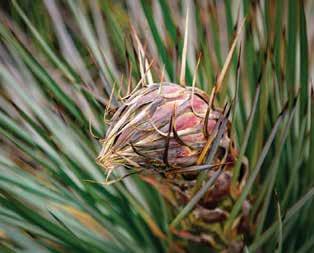
For the Serrano people, wealth lies in their traditions. Here’s a look at two celebrations that connect the people with their past and bring a richness to their experience.
San Manuel Band of Mission Indians ensures the success of future generations, and the Tribe as a whole, through the comprehensive internship program.
An elder from the San Manuel Band of Mission Indians shares childhood memories, her professional journey and how she feels about preparing the youth to protect tribal sovereignty.
Indian gaming exclusivity has created prosperity for the Indigenous people and the communities near their ancestral lands. Learn why California tribes are now fighting to retain this right.
Setting goals, pursuing passions and chasing dreams, two tribal youths reflect on what they’ve achieved and look forward to what’s to come.
Native American designer Patricia Michaels infuses her tribe’s history and legacy into every piece of haute couture.
From bright and bold to cool and muted, these suits and coverups will up your poolside vibe.
Puyu’houpkcav

40
PHILANTHROPY
The new Santos Manuel Student Union at CSUSB offers a place for all students to gather, learn and find community.
46
VENTURE
Now a quick getaway at Yaamava’ Resort & Casino is easier than ever with Breeze Airways’ new non-stop flights between San Bernardino and San Francisco.
47
CELEBRATE
Modern fanfare and traditional touches were found throughout the grand opening celebration of the new Yaamava’ Resort & Casino at San Manuel, a significant achievement decades in the making.
50
ACTION
Meet the woman behind the new Centerfield Plaza at Dodger Stadium and find out how she modernized the space while honoring the past to create a fan-favorite destination.
56
GIVING BACK
San Manuel and Three Square team up to feed thousands of hungry children and adults in Las Vegas.
58
HELLO
From food runner to executive level, this employee shares what it has been like to watch the incredible changes at San Manuel as well as his appreciation for the experience.

60 ON TREND
Everything you need to protect your skin before and after a day at the pool – and all the accessories to turn heads while you’re there.
64 SAVOR
The Pines Modern Steakhouse opens the doors in its new space at Yaamava’ Resort & Casino. Discover high-end, approachable dishes and the relaxed yet vibrant atmosphere at the region’s best steakhouse.
70
HORTICULTURE
The horticulture department brings beauty in unexpected ways to the shared spaces at Yaamava’. See a few of the inventive designs made from flowers and greens.
72
DISCOVER
Take the next step on your wellness journey at the luxurious Serrano Spa & Salon, where nature-inspired treatments and soothing surroundings deliver a deep sense of peace.
76
DRINK
A tropical escape awaits you at the new pool at Yaamava’ Resort & Casino. Check in and check out the lush surroundings and curated cocktail menu –starring upscale tropical libations.
80
WHAT’S NEXT
Your favorite band is only part of the equation: sound, lighting, seating and sightlines can transform a good experience into an extraordinary one. The new entertainment venue at Yaamava’ Resort & Casino is about to do just that.
82
LAST BITE
Loved that steak from The Pines Modern Steakhouse? Here’s how you can make it at home.
84
DIRECTORY
A quick look at dining, shopping, gaming and nightlife.
I am delighted to share our third issue of Hamiinat,
the magazine of the San Manuel Band of Mission Indians. The title translates to “hello” in the Maara’yam (Serrano Indian) language, and that is just what we want to extend to you –a warm hello.
Serrano Indians are indigenous to the San Bernardino Mountains and valleys, as well as the High Desert regions of Southern California. The people of San Manuel are the Yuhaaviatam Clan of Serrano Indians, whose rich culture and history are reflected throughout this wonderful magazine. We are most happy to offer you a glimpse into our Tribe and enterprises.
We continue to celebrate the opening of Yaamava’ Resort & Casino, an endeavor that was years in the making, and one that will bring jobs, revenue and new experiences to benefit the Inland Empire region for years to come. This huge success would not have been possible without Indian gaming, the story of which is ably presented in our cover story: an in-depth look at the history of tribal compacts with the State of California. We explore how revenues from gaming have not only lifted the Serrano people out of poverty, but also helped communities and people around us in meaningful ways. This important progress has brought new growth and opportunity to our Serrano ancestral lands and the entire state of California.
We then look at how the new offerings at Yaamava’ Resort & Casino are bringing beauty and excitement to the Inland Empire in unexpected ways: from intricate seasonal scenes created from local and exotic flowers and the lush pool complex to the soothing luxury spa and stateof-the-art entertainment venue. We also feature exciting swimwear designs from Native American fashion designers whose creativity is sure to inspire for the upcoming summer season.
In this issue we also meet changemakers on both ends of the spectrum: one of the seven women leaders who signed the original governing documents of the San Manuel Band of Mission Indians in 1966, and who helped to create the new constitution for our people, as well as young tribal citizens who have their sights set on a future of great promise and expectation for themselves and the Tribe.
We thank you for being our guest and can’t wait to share our many new and exciting offerings as well as our culture with you.
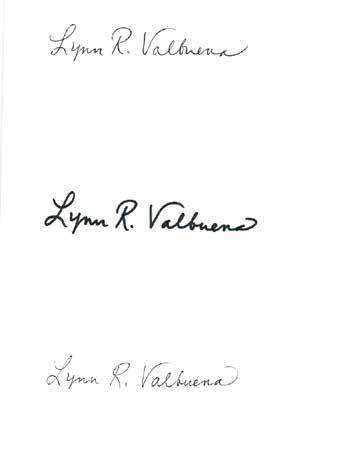
Chairwoman Lynn “Nay” Valbuena San Manuel Band of Mission Indians

H amiinat
Summer 2022
BUSINESS COMMITTEE
CHAIRWOMAN Lynn Valbuena
VICE CHAIRMAN Johnny Hernandez, Jr.
SECRETARY Audrey Martinez
TREASURER Latisha Casas
MEMBER AT LARGE Ed Duro
MEMBER AT LARGE Karina Torres
MEMBER AT LARGE Laurena Bolden
CONTRIBUTORS A VERY SPECIAL THANK YOU TO THE FOLLOWING:
Kyle Anderson
Peter Arceo
Jerry Bowlen
Zachary Carleo
Lee Clauss
Jacob Coin
Christopher Dennis
Drew Dixon
Tim Evans
Andrea Ferguson
Joey Gottesman
Darcy Gray
Tom Hedrick
Serena Harper
Heather Jackson
Alberto Jasso
Cathy Knowles
Dan Little
Chelsea Marek
Tonya Oatman
Tina Ramos
Jared Rapier
Ryan Sharpe
Linchul Shin
Ken Shoji
Frank Sizemore
Matthew Smith
Missy Stanisz
Rikki Tanenbaum
Kelley Tucky
Shane Upson
Brandi Vega
Daniel Vigil
Oliver Wolf
California State University of San Bernardino
LA Dodgers
Three Square
Nicole Fields
Aiden Hernandez
Anabella Hernandez
Nathan Hernandez
Gauge Hernandez
Deron Marquez, Ph.D
Sandra Marquez
Moriah Martinez
Nathan Martinez
Jordan Murillo
Ken Ramirez
Hawk Ramos
James Ramos
Shawnee Ramos
Claudia Reiley
EDITORIAL
MANAGING EDITOR Ed Duro
MANAGING EDITOR Karina Torres
VP TRIBAL BRAND MARKETING Jessica Stops
TRIBAL BRAND MARKETING Julie Lopez
PUBLISHER Peter Gotfredson
CREATIVE DIRECTOR Lauren Clulow
EXECUTIVE EDITOR Jessica Villano
Thank you to the San Manuel Band of Mission Indians and the entire tribal community for sharing their stories: past, present and future.
(puh-mee-ah chah-kee-meev)
OUR HERITAGE
Pümia’ čakimiv: what we came with. The phrase describes our heritage, traditions, culture and all the songs, dances and special things our people have passed down over many generations.

In this section we look at the significant ways in which Indian gaming has improved the lives of those in the Tribe, as well as the surrounding community, and explore new initiatives that could threaten this prosperity. We also meet several tribal youths who are embracing bright futures and an elder who has been in service of the Tribe for decades. Finally, we explore traditional gatherings that celebrate the seasons and remind the Serrano people of their history.
Enduring An Culture
A look at Yucca Harvest and Yaamava’ Spring Celebration and how they connect the Serrano people with their past.
BY RICHARD ARLIN WALKER
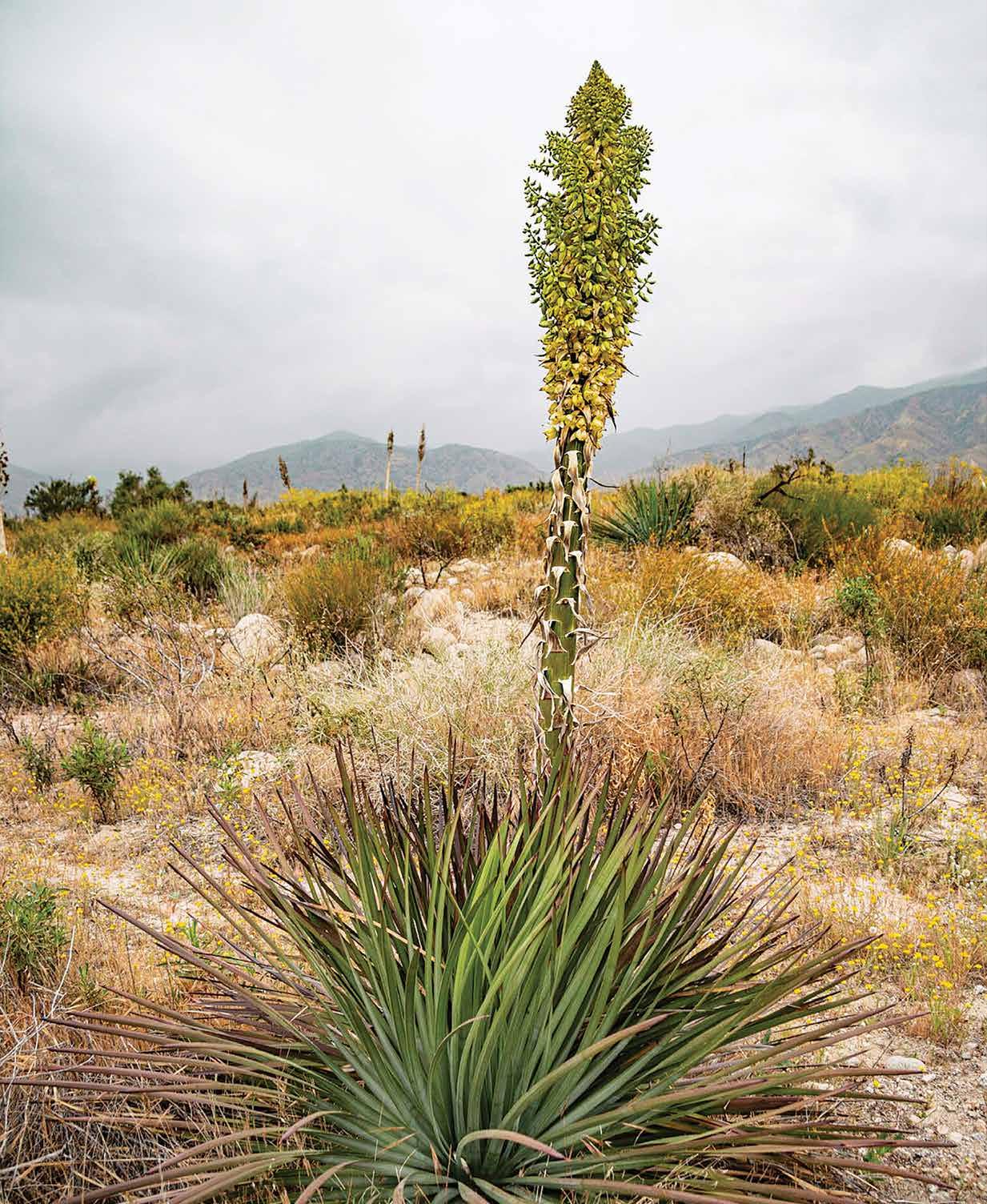

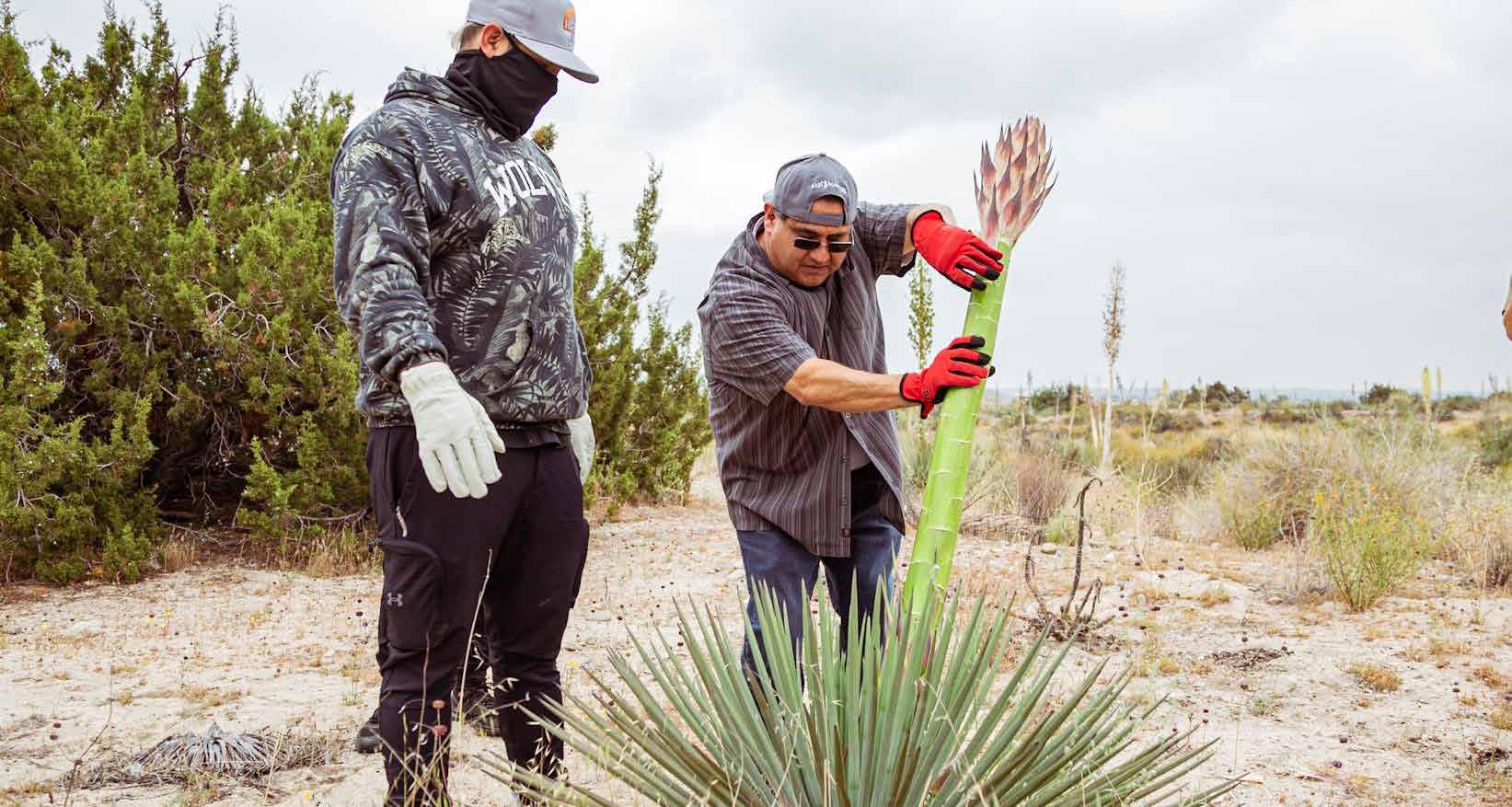
Even if it all went away – the hotels and the gaming and the other ventures that fuel the San Manuel Band of Mission Indian’s economic wealth – the Yuhaaviatam people would still have wealth that has withstood centuries of change and upheaval.
The people would still gather, as they will at the Yucca Harvest and Yaamava’ Spring Celebration, to give thanks for the new season and the life it brings.
Other tribes and relatives would still come – from Morongo, Cabazon and Agua Caliente; from TorresMartinez, Chemehuevi and Fort Mojave; from Pala, the Kumeyaay and other Native Californian tribes –to share a meal of rabbit stew, deer chili, boiled yucca blossoms, yucca and meat or egg dishes and yucca bread.
Bird Songs and Bighorn Sheep Songs would still be sung, and women would still dance to the beat of gourd rattles. Culture bearers would teach the language and tell of the people’s history, from creation to migration and the importance of their homelands. The people and their culture would live on.
State Assembly member James Ramos, a former chairman of the San Manuel Band of Mission Indians and the only Indigenous member of the California Legislature, grew up harvesting yucca, learned to make sandals and other utilitarian items from
We were almost wiped off this earth. To understand that and the importance of retaining our culture and understanding the plant life is so much more of who we are that will outlive anything economical.
yucca fiber and ate his grandmother’s boiled yucca blossoms with egg. He later harvested yucca with his children and, in the 1990s, developed the Yucca Harvest and the Yaamava’ Spring Celebration as part of the San Manuel’s cultural awareness program.
Both the Yucca Harvest and Inter-Tribal Celebration as well as the Yaamava’ Celebration occur in the spring. Both are powerful events –times of renewal and reunion, for sure, but also times to learn about the environment that has sustained the people since the beginning of time.
“Part of who we are is our sovereign right to understand the plants that grow and how to survive
if everything turned different than what it is today,” Ramos said.
Even if for some unforeseen reason the affluence from the new economy went away, he said, “You would be able to survive with the plant life, you’d be able to notice the cycles – starting in spring, making your way up to the mountaintop to wait out the heat down in the valley and following the plant life from the yucca blossoms to the pinon nuts to the acorns. All of this is knowledge about who we are culturally.”
He added, “I believe there are a few things in life that, once you attain them, no one can take from you: education, your culture and spirituality. Spirituality is our songs. It teaches us about that migration, about following the plant and animal life. The songs we sing, the Cahuilla Bird Songs, talk about the migration of the people following the plant life and the animals you would see along the way. Not every song is about a bird. It’s about the migration following the plant life so that your clan can survive.”
This was the cycle Ramos’ forebears knew: The yucca plant started to bloom on the valley floor in springtime, providing mildly sweet flowers for food and plant fiber for baskets, cordage, mats and sandals. As valley temperatures grew warmer, the people followed the yucca to higher elevations, where it would still bloom near Running Springs elevation.
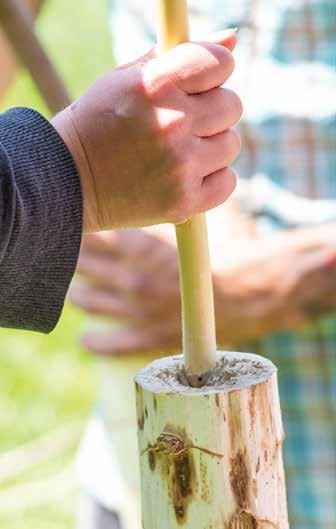
Then the people would make their way to the Big Bear valley area, near Baldwin Lake, to harvest the pinion pine nuts. Harvesting would take place mid-August to mid-September, Ramos said.
Following the plant life cycle as cooler temperatures came to higher elevations, the people would head down to the valley floor to harvest acorns, which bloom at a lower elevation than the pinion pines, in October and November.
“Then you’d come down to the valley floor and wait out the winter,” Ramos said. “And when spring comes, you’d start the whole cycle all over again.”
But climate change has interrupted plant cycles.
“There are times when it’s spring and it’s dry and plants won’t bloom right away, and then sometimes there are wet seasons and they bloom early,” Ramos said. “The yucca plant follows that so closely that, if there’s water, then we have an abundant crop, but if there’s not, we have to search for it.”
A warming climate and the worst drought in a millennium have led to an increase in wildfires that also have affected traditional harvesting areas.
“When fire comes, sometimes it helps and sometimes it doesn’t,” Ramos said. “We had a fire come through our area – in Serrano territory, the foothills of the San Bernardino Mountains – and we saw an abundance of growth of chia plant. We haven’t seen that much chia in a long time, and we’ve seen other plants grow after the fires came through too. But we’ve also seen infestations of the bark beetle. It used to attack the pine trees, never our pinon pines, and we’re now starting to see some infestation on
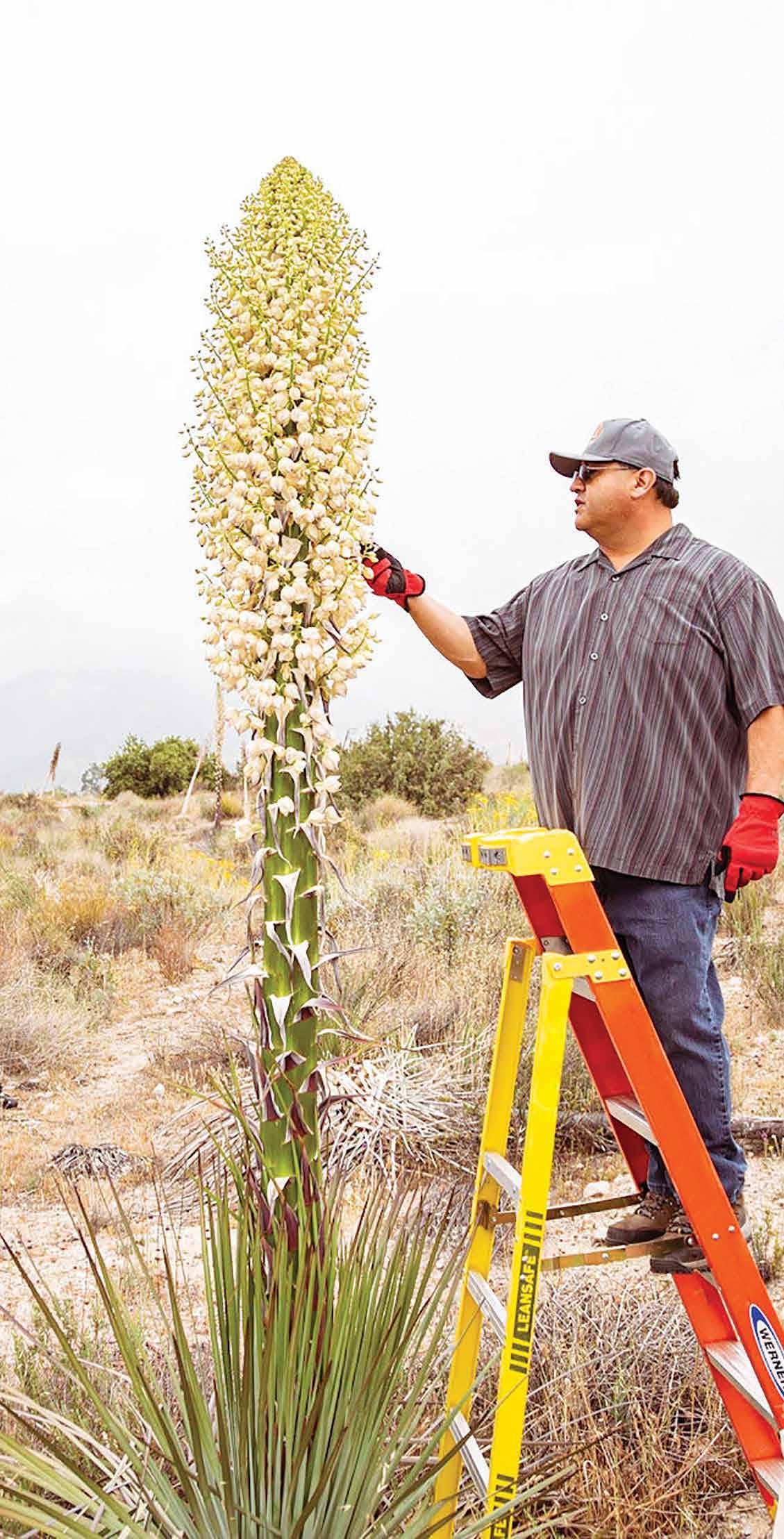
the oak trees that bear the acorns – in the forest. So, climate does certainly affect the plant life.”
Development, too, has encroached into traditional harvesting areas.
“A long time ago, people would know the areas to harvest because a whipply yucca plant grows seven years before it blooms, and then once it blooms, the plant dies. And so, there are different areas that people would know. Where some plants were barely growing, they’d know that it’d be seven years before those plants would bloom. And they’d know that some others are probably more mature so they’re going to bloom in three years and another crop is blooming now. So we would know which areas to go to, to collect. That type of knowledge is wisdom that we’re still trying to follow, but it’s hard now because of the infrastructure development in our traditional gathering areas.”
Reawakening and Reemergence
The Yuhaaviatam people’s lifeways came under attack before. The people had followed the plant and animal life through six seasons – Yaama’ Müaac, Süü Müaac, Ahounani’ Müaac, Siikwa’ Müaac, Harupkiva’ Müaac and Maarai’t Müaac – since time immemorial. But that was disrupted in 1866, when an anti-Native American militia formed and, in a 32-day battle, reduced the Yuhaaviatam population to fewer than 30. Santos Manuel, namesake of the San Manuel Band of Mission Indians, led the remaining people to the San Bernardino Valley where they resumed their way of life. The people and the culture endured. And their
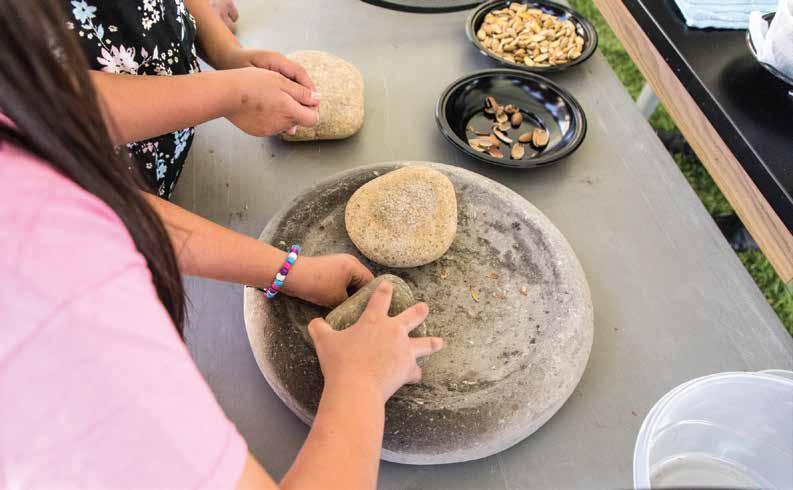
inherent right to self-govern was recognized by the federal government in 1891.
“We were almost wiped off this earth,” Ramos said. “To understand that and the importance of retaining our culture and understanding the plant life is so much more of who we are that will outlive anything economical.”
Appropriate, then, that Yaamava’ means rebirth –a celebration of the season and the renewal it brings; and that the Yucca Harvest celebrates a plant that is central to Yuhaaviatam culture.
Lee Clauss, San Manuel Band of Mission Indian’s Vice President of Cultural and Natural Resources, said, “It’s acknowledging that all of the plant life is coming back into its greening and you are now able
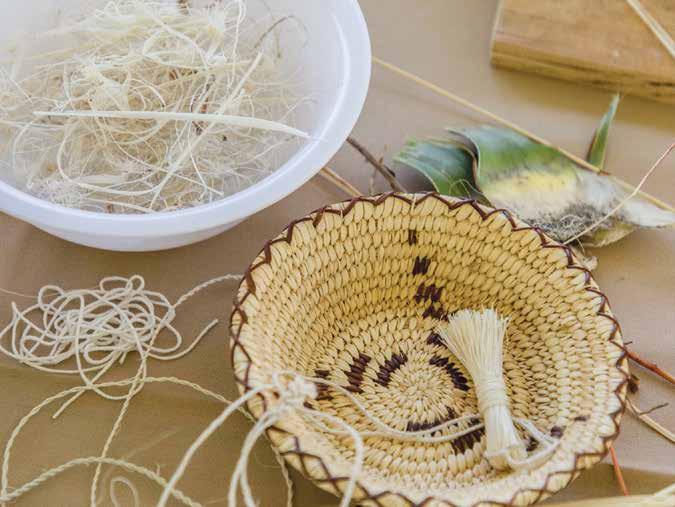
to move out of your winter regime. You can start moving into spaces where some of the plants that bloom first are available and animals start to come out of hibernation and start moving around the landscape.
She added, “In wintertime, you’re often using a lot of resources that you stored up during fall. Now you can get back into nature and get fresh resources.”
Clauss explained that the Spring Celebration has a family reunion feel to it. Tribal community members share stories about Creator. Aunties and uncles bring homemade dishes for the buffet-style potluck. Children play traditional games and learn how to make traditional items. And there are Bird Songs that tell the story of the Yuhaaviatam people, their connection to the land and all it provides – and all that must be protected.
“Our culture is so much more than just the gaming activities of our Tribe,” Ramos said. “It’s important our children learn about the cycle of spring and following the plant life so they can retain that knowledge and share it with their families moving forward.”

Preparing
Tomorrow’s Leaders
The
San Manuel Band of Mission Indians sets its community up for success through the tribal internship program.
BY KOLBY KICKING WOMAN


Valuing its sovereignty, the San Manuel Band of Mission Indians looked for ways to safeguard its selfsufficiency and self-government.
The answer was clear: establish a youth internship program that would empower the next generation with the skills and careers that will not only enrich their lives, but also ensure the continued success of the Tribe.
Aside from hands-on experience, participants are being prepared to one day take the reins in tribal government and to make the decisions that will guarantee the well-being of the community.
The internship program is divided into two age groups, 14-15 and 16-17, and is offered three times a
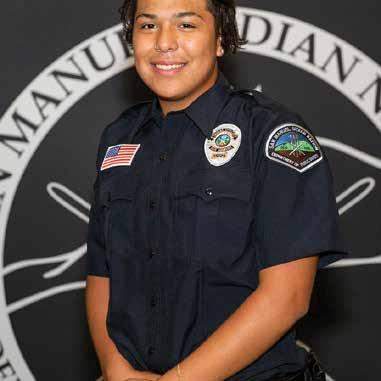
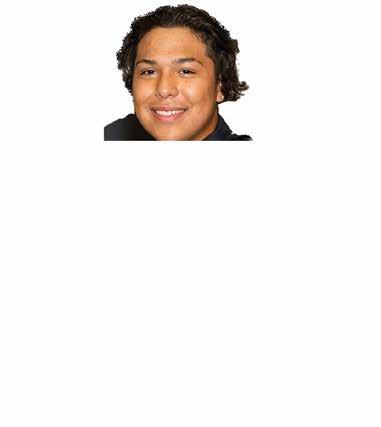
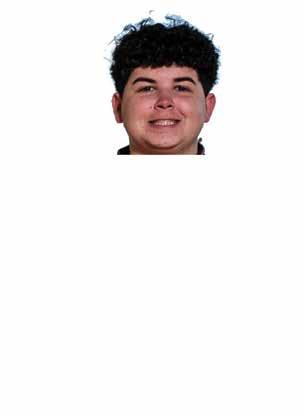
year – fall, spring and summer – giving plenty of opportunities to select a session that best suits the participants’ schedules as well as a chance to explore each of the programs, if they so choose.
Currently, youth admitted to the internship program can select from five focuses: Cultural Awareness, Financial Empowerment, Tribal Safety, Tribal Sovereignty and the Serrano Language Revitalization Program. (Youths 18 or over, can join the regular internship program and are not limited to the five focuses.)
Ed Duro, Tribal Council Member, explained, “It’s important to provide our youth with tools to help them succeed in life and find an interest in whatever department they desire.”
Nicole Fields, one of the first to partake in the program, said a favorite aspect was knowing she could help shape the program for future participants. “It was cool being able to give feedback because I knew my opinion was important and that I could help improve the program for the next people,” she said. Fields has completed internships in Tribal Safety and the Serrano Language Revitalization Program, both of which were very hands on. And when she ended up in a real-life situation, she was able to use the skills she gained through the Tribal Safety Program. Out biking last summer, Fields’ companion had a bad wreck, but with the internship training under her belt, she was able to assist with her friend’s injuries immediately. “The whole left side of his body was just

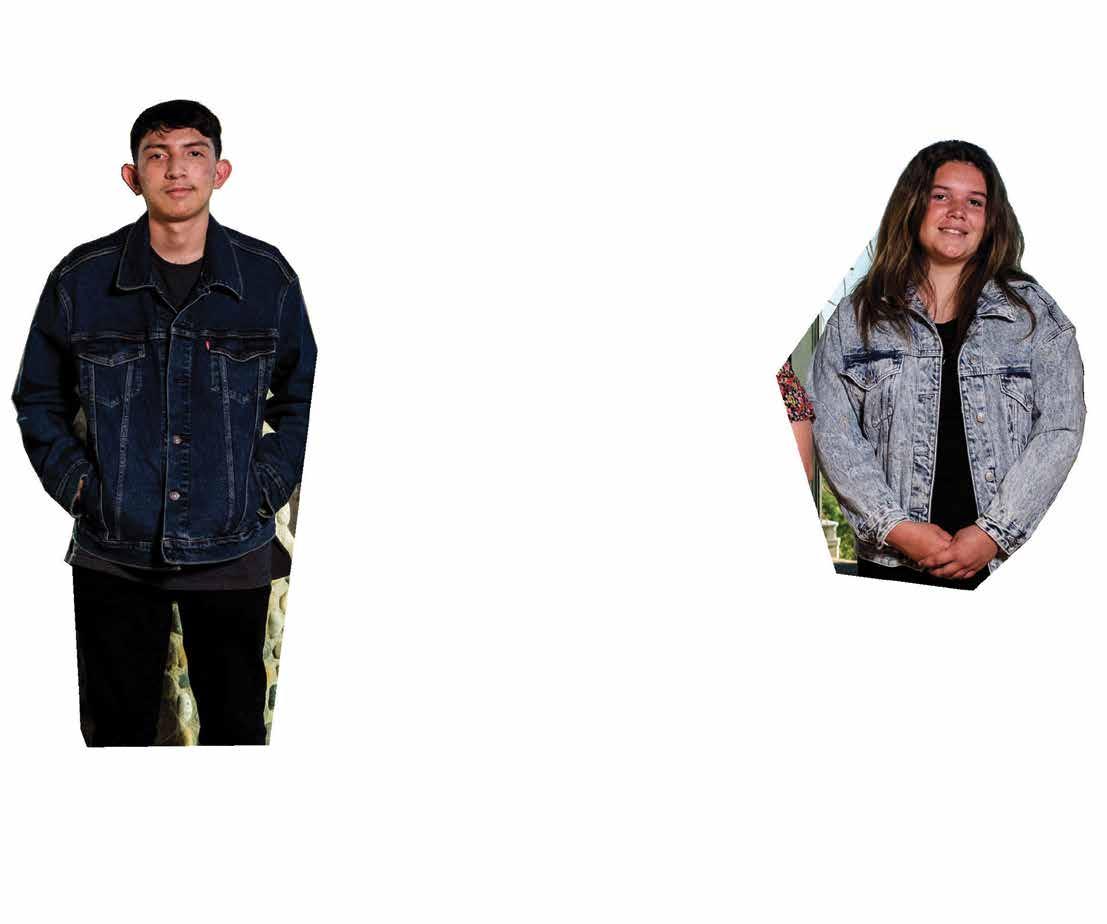
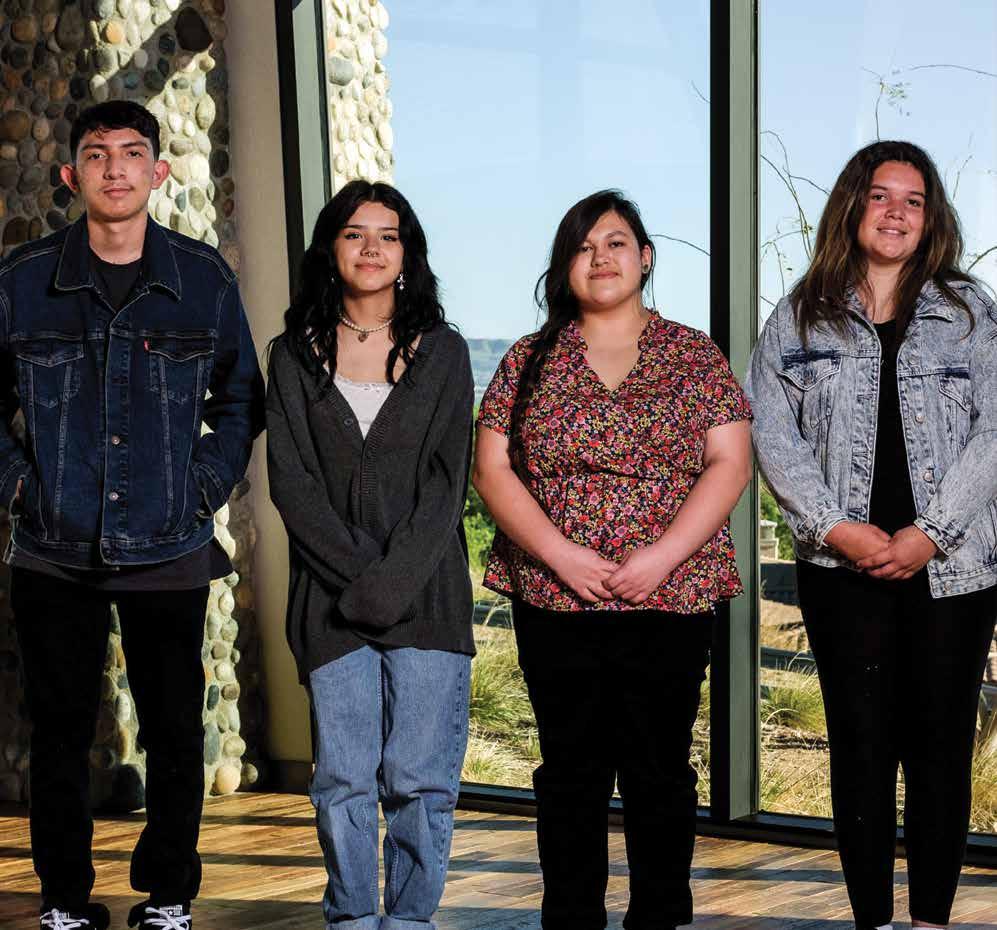
absolutely torn up by the road,” Fields recalled. “So, I applied the tactical medical skills and cleaned up his wounds before we took him to the hospital.”
While the program is still relatively new, it has already been a great success. “I think it’s great so many youths are participating in the program; it helps them expand their knowledge of the different departments and develop critical skills,” said Duro.
The Serrano Language Revitalization Program is one of the most popular offered by San Manuel and reflects a big movement throughout Indian Country.
“Knowing that our language was going dormant hit a sensitive spot for me. I wanted to learn the whole language so I can teach it one day,” said 16-year-old Gauge Hernandez. He has even started to create
projects for other language learners, both children and adults, to help keep the Serrano language alive.
Gauge’s younger sister, Annabella, has also taken part in the internship program. “We’re going to help make changes and they’re giving us the resources to do it. This internship is a great opportunity to help young people find what they want to do in the future,” Annabella said. “And it shows they trust us and believe in us as the future of the Tribe.”
One thing is certain, all the internship program participants have loved the experience and encourage others to take the chance and do it for themselves. Claudia Riley, who completed the Tribal Sovereignty program, described it as her first foray into a real-world job experience. “The fact that I was able to finish the internship is very important to me. It was a huge accomplishment
and I’m so grateful I have that experience,” Riley said. For youth who aren’t sure if the experience is one they would enjoy, past participants suggest moving past their hesitation. “Just do it and don’t be nervous,” Gauge Hernandez said. “Some people worry it might take up too much time, but these skills will help you achieve great things in the future.” Annabella followed up by advising kids to choose something they’re already interested in so they can have fun.
Fields, who is about to graduate high school, advised potential interns to pick up as many internships as they can with the time they have. “You’ll gain so many skills and so much knowledge. It even helped me narrow down a lot of options and interests and find a career path that I know will be fulfilling and lead to a successful future,” she said.
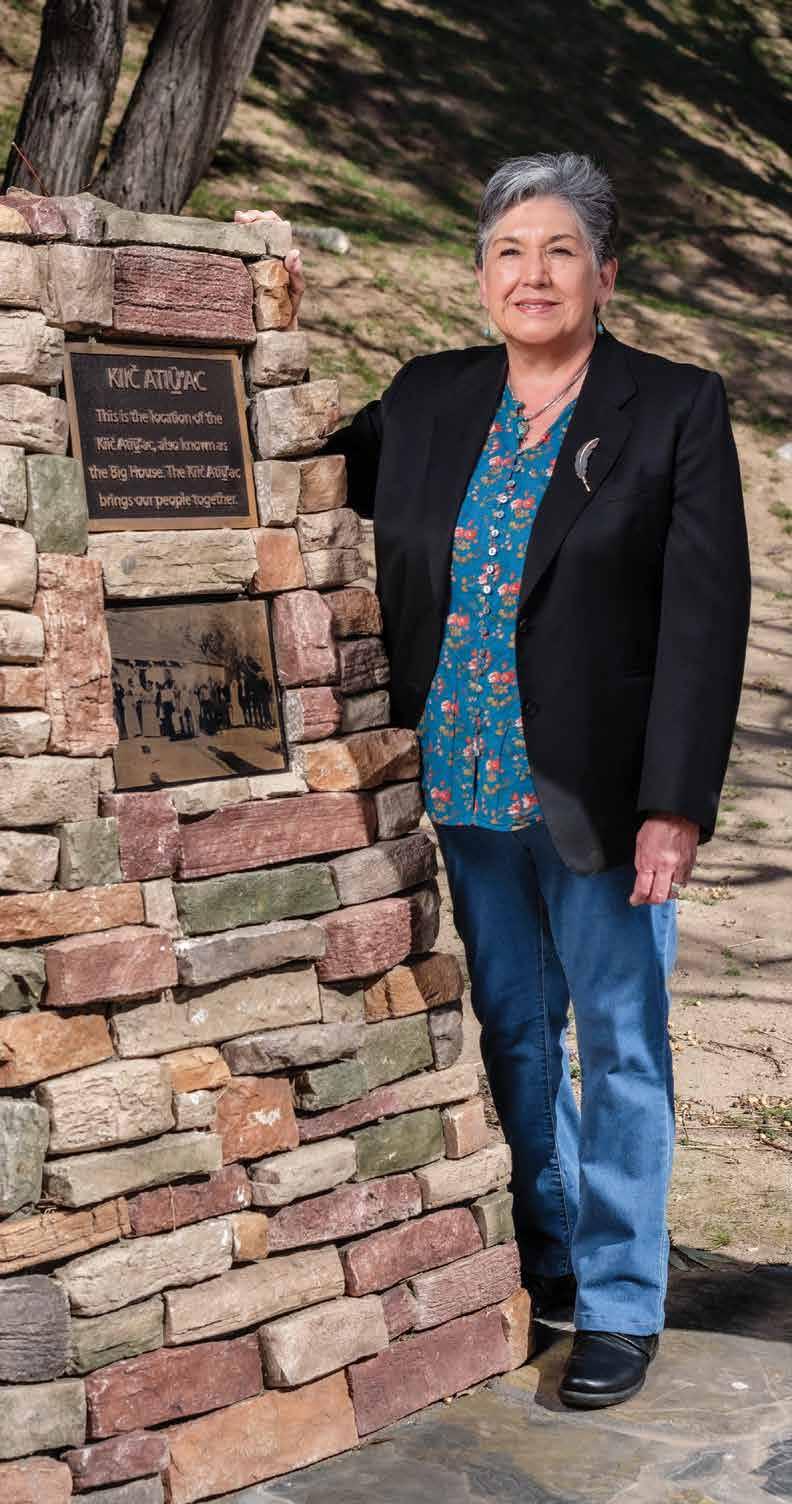
QA &
with Sandra Marquez
From teacher’s aide to Gaming Commissioner, Sandra Marquez shares her journey and offers insight into what she thinks is the key to future prosperity.
What does it mean to be Serrano and a tribal citizen of the San Manuel Band of Mission Indians?
I feel very proud and strong-willed, as our ancestors were. I think about the ancestors and how they struggled to survive. And I count my blessings. As a child, I knew what it was like to not have the things we have today, but we were happy. We hung in there and we were strong; that’s what perseverance is.
Did you grow up on the Reservation?
Yes, I was born in an Indian hospital on the Soboba Reservation. We lived on the San Manuel Reservation next to Tutu, my grandma. When I was in elementary school, about second or third grade, we lived in a house that was located by the flood control and the Victoria Gate entrance to the Reservation. My mom worked for the York family for many years as their housekeeper. They owned a nursery and they gave me my first job taking care of the plants; the York’s nursery was located close to where the Yaamava’ Resort entrance is now. They gave my dad and mom our second home. About 1956, our parents moved our home onto the Reservation, next to our tribal cemetery; I was in seventh grade.
Tell us about the changes to the Reservation.
I used to skate on the hard dirt roads. Nothing was paved. We had kerosene lamps, no electricity. I remember the lamps Tutu used to light. When we got electricity, it was one old light hanging down. We had spring water, which was piped from our spring on the hill. Then we had water from Big Bear Water Company for the apricot orchard. The BIA [Bureau of Indian Affairs] provided piping, so we could pipe our water from the spring. There were no homes there, it was all hills and brush. Housing came with the Housing Improvement Program [HIP] from the BIA; later Housing and Urban Development [HUD]. Before we could receive services, we had to create the Articles of Association. I took part in that. It was approved in 1966.
You were one of seven women who signed the articles, right?
Yes, seven women signed the Articles of Association. I typed it on the old typewriter.
Is this one of the things that stands out to you that you’re most proud of?
Yes, because we finally had guidelines to follow, which were the Articles of Association, and the Tribe could receive services from the BIA. Now we have the new Constitution, which took five years to create.
And you were part of that?
Oh yes. The Constitution are guidelines for the tribal citizens to govern the Reservation and protect and strengthen our sovereignty.
How do you feel when you see the changes to the landscape?
At first it was sad because the tribal citizens worked in the apricot orchards. I went with my Uncle Benza, also my godfather, to help him in the
orchards. I was small, but he would have me clear the ditch so water would flow to the apricot trees. Such wonderful memories. I know times change, new ideas are born and we need to move forward, but don’t forget the past. Our Tribe’s history must go on to the next generations. Keep the history going. The Tribe must count our blessings and thank God for allowing us to have what we have.
Were there elders you looked up to, people who taught you skills and traditions that you've held on to?
My grandmother, mom and my Aunt Wee-sha. I remember how they took care of us. I was sickly for some reason. My grandma would take me in her house. She had her bed in front of the fireplace in the big room and I'd lay on her bed. I would get ear infections and she would blow smoke in my ear to help it drain. I would get sinus headaches and she'd put hot rocks on my forehead to drain my stuffy nose and she’d boil eucalyptus to help us breathe. Tutu put hot rocks on my feet to keep me warm. Mom would follow her mom’s customs and do the same for us when we were sick.
What was your favorite thing they used to cook?
My Tutu would cook palilies (fry bread) outside and I would sit with her while she cooked the bread. While she was cooking, she would speak Cahuilla and sing songs. Her fry bread was the best. Aunt Wee-sha could cook all from scratch, no recipes. She made apricot pies, apricot turnovers, big biscuits and huge tortillas. Mom was a good cook. I loved her fry bread; it was so soft and tasty, yucca blossoms cooked with chopped bacon and eggs, cactus with eggs rolled in a tortilla…Mom made the best tortillas and fry bread, deer meat with gravy, fried potatoes. They were all good cooks.
What are some of the great lessons you've learned?
Togetherness, caring, respect and love for each other. You know, we were one big family. We were naughty, but we had a good time. From my ancestors, I inherited perseverance, patience and caring.
You've had a lot of big, important roles in your career. Let's talk about that. Through my vast training I feel I’m a good role model for the internship program because there's so much I learned through on-the-job training.
Tell us about your career.
I began my career with the Fontana School district as a teacher’s aide and was promoted to coordinator in establishing the Title IV A Indian Education Program. I was then recruited by
the BIA to work as secretary of the Education Department.
What did you do during that time?
I started in education but then the government cut the program and the Realty Department director asked if I would like to work there. I worked with an administrative law judge researching probate cases for hearings and working with my boss to prepare last wills and testaments for the Indian population under the jurisdiction of the Southern California BIA. Later, I took extensive college credited courses to learn human resources procedures, responsibilities, management, budget and warrant officer training. I received my Warrant Officer Certificate and became the purchasing agent. In my final position, I was promoted to the administrative officer position, GS 9; when I left I was a GS 9/3.
All these things prepared you to take on bigger roles?
Yes, I learned how to write and implement policies and procedures for departments. When San Manuel Bingo’s general manager offered me the role of HR Director, there were no written policies and procedures in place, so I hired staff and we wrote the policies and procedures and developed organizational structures with the department and management staff.
What role did you take on next?
Commissioner of the San Manuel Gaming Commission. It was the responsibility of the Gaming Commission to follow the Compact, San Manuel Gaming Ordinance, Indian Gaming Regulatory Act (IGRA) to assure the casino was compliant with all federal, state and tribal regulations and any applicable regulations adopted by the National Indian Gaming Commission.
What is one piece of advice you'd like to pass on to the younger generations?
Take an active role in the Tribe’s functions.
Learn about tribal government; join the Internship Program; learn about all the committees: Investment Board, Education Committee, Cultural Advisory Working Group (CAWG). Learn the Serrano language, learn about bird singing and dancing, learn the old customs and traditions. Get an education – higher education or vocational.
When you think about seven generations from now, what do you hope for?
I hope that our sovereignty is still protected by those who will come after us.
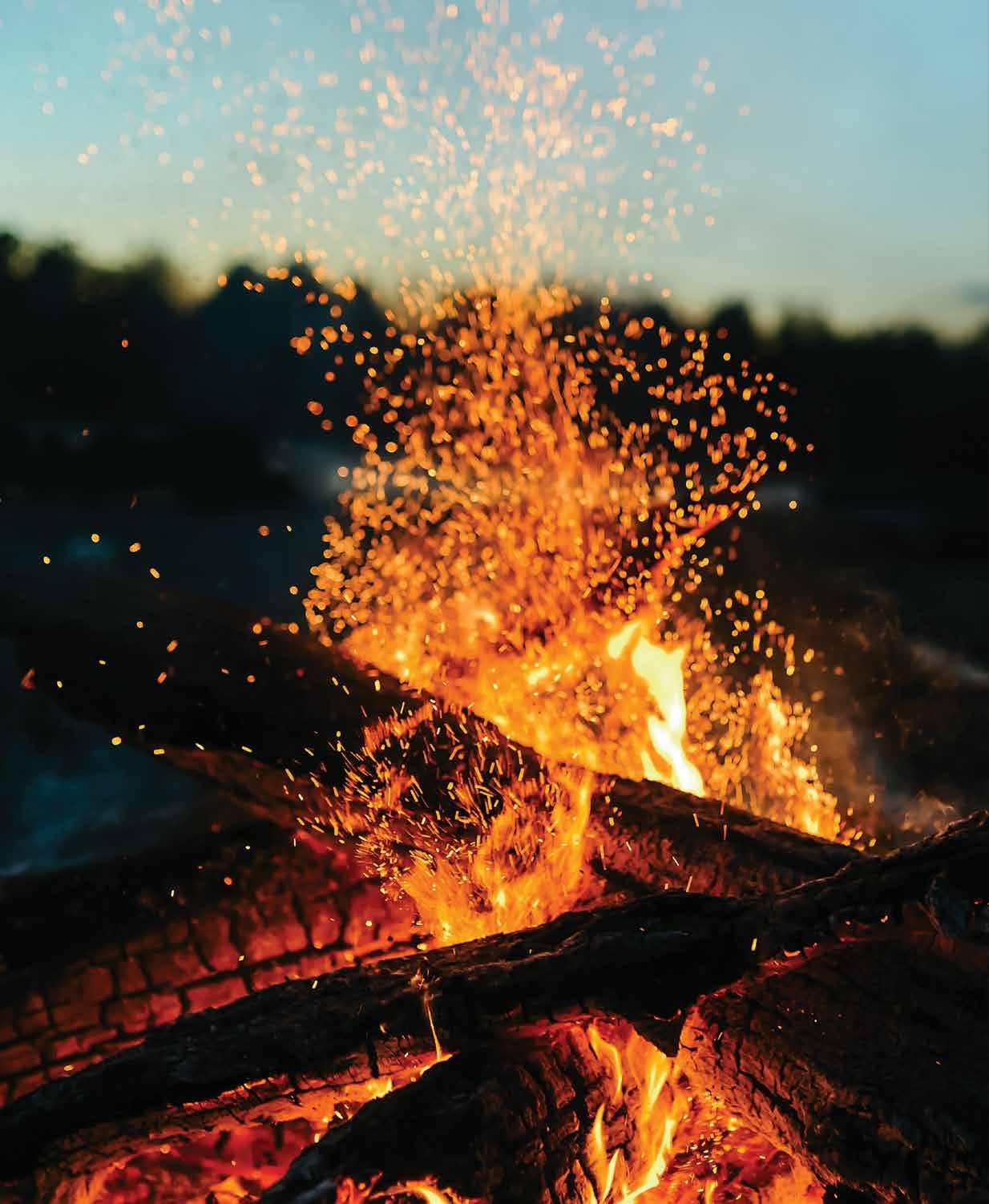
Tribal casinos generate $23 billion of economic activity in California, including nearly 200,000 jobs and $80 million per year to local communities and infrastructure – roads, fire, police, medical, education, parks, healthcare and social services. Today, tribal gaming exclusivity is at risk due to potential encroachment from out-of-state operators.
This threatens our ability to give back to our communities and the trusted gaming environment forged through the relationship between tribal governments and the state. This year, California voters could be asked to decide on options to legalize sports wagering. Tribal leaders urge voters to consider what’s at stake and say “NO” to out-of-state operators. Help tribes retain gaming exclusivity so we can bring our state the full benefits of online sports betting, a fair share of new revenue and safe, California-based sports wagering.

FRUITFUL SUNNY SHADOWS
By Deron Marquez, Ph.D.
Remembering those youthful warm spring days when sunlight washed over the desert and the warm sacred grounds were fruitful with community. The hours spent playing with tribal youths as the desert dirt whirled about for hours, then, the desert shadows started to emerge, and the breeze moved in waves of warm-cool air. Night was starting to reign, sunlight was battling to maintain its shadowy ground, the setting sun passed the horizon and the amber sky glowed, giving way to a sky ruled by constellations. The mountains disappeared and the ripe night arrived.
Across the plaza, groups of adults were starting to clump. Firepits, already ignited as though they were allies of the sun, kept the plaza inhabitants visible. Voices filled the air and the sound of crackling flames provided fantastic half face shadows of the contestants. Their faces, well advanced in this game of chance, remained expressionless. The fires produced shadows, as the team passed the “bones” back and forth behind a dark blanket being held in place by their teeth. The opposing team had to track the “bones” through rhythmic chanting sways and guess which player possessed them. This was a well-rehearsed ancient practice of gaming that utilized skill, chance and community. As child, I witnessed this game – Peon – in the late 1970s when attending a Fiesta at the Malki Museum grounds on the Morongo Reservation.
During this same time, across the country, a different form of gambling was taking place.
The birth of Indian high-stakes bingo was launched in Florida and Maine. Much like gambling within American Indian communities, bingo was well known, but the rules surrounding Indian high-stakes bingo were different. Bingo was limited by states and counties for charitable causes; this was not the case in Indian Country. This new form of bingo also offered winnings surpassing state’s regulatory limits. States were quick to challenge these tribal government offerings.
In 1979 the Seminole Tribe of Florida opened its doors and introduced gaming to Indian Country, however, the gaming path was riddled with many challenges. The legal battles commenced in Broward County, where locals threatened to arrest anyone playing Indian bingo. The district and appeals courts upheld tribal rights for conducting highstakes bingo given that Florida permits others to conduct such activities under civil laws. This legal framing was upheld by other courts across the country, including the Ninth Circuit Court of Appeals in its 1983 Barona decision. Three years later, the same question would be back in front of the Ninth Circuit.
The state and County of Riverside, located in Southern California, sought to close two tribal bingo and card room operations. The Ninth Circuit based its ruling based on its prior Barona decision;
California and the county could not enforce their statutes because neither prohibited but instead both permitted and regulated these forms of gaming.
California appealed to the United States Supreme Court and in early 1987, the Supreme Court affirmed the lower court’s decision, upholding tribal governmental gaming rights.
The following year, Congress passed the Indian Gaming Regulatory Act (IGRA), which prescribed measures that must be taken by tribes, the federal government and states for the conduct of tribal gaming. The IGRA was crafted to address states’ concerns and is far from ideal, but through the years, the three governments were able to find the best possible path.
Sovereign Spandex
A truism related to sovereignty: a sovereign must possess the ability to utilize every fiber of the meaning. Tribal nations have morphed from complete sovereigns into sovereigns possessing fragments of what was once whole.
Through the years, the federal government has remodeled tribal nations, where in one moment the high court rules tribes have the right to conduct these operations, then Congress curtails that right, as it happened with IGRA. Tribal governments across the country had to prepare for the injection of states. But tribal governmental gaming also afforded tribes the ability to fortify and seek new framing to advance sovereignty.
The creation of new frames included the
educational realm, business development, politics across all spheres and mega-developments on reservations. Sovereignty is about performance; acting in a manner that advances, grounded in the old while expanding the new sectors that tribal governments control. Sovereignty is a non-stagnant concept and needs constant rejuvenation with each new generation. Gaming, for the first time in “American Indian” history, has provided the means to perpetuate actions, horizontal and vertical. Because of gaming, tribes have reconstituted their equal footing within the political landscape. For many years, Native Americans had witnessed their existence being discarded by the United States: the government broke each of the 368 treaties it had with tribal nations; practiced federal- and state-sanctioned genocide; took two-thirds of tribal land holdings (primarily through the 1887 Allotment Act); and terminated over 100 tribes in 1953, just to name a few atrocities. In 1900, there were approximately 200,000 Indians recorded on the U.S. Census. Today, our torch of survival ignites our proliferation of sovereignty and honors those who walked our sacred grounds, fighting to keep our sovereignty intact so future generations could reenergize and advance it.
Move Over, We’re Driving this Rez Engine
With little or no ability to generate revenue like traditional governments due to the lack of a taxable land base and with limited federal funding,



resources were bleak in the late 19 th and most of the 20th centuries. Problematic federal programs came with too many restrictions. It made sense for tribes to decide economic plans and remove paternalistic overreach. Tribes were always capable of determining their future, as illustrated by tribal government gaming operations, which afforded tribes the ability to plan their futures.
Today, tribal governments have crafted impactful business arms and thus have emerged as powerful community partners. Many tribes, especially those with a large land base, have established business zones and partnered with corporations. Others have turned to investing off-reservation, seeking alternative economic engines in population centers. While gaming has become the catalyst for creating more economic engines, it also provides tribes the ability to provide much needed services to tribal and non-tribal communities.
Many cannot comprehend that there are communities in the United States that still go without simple living elements. Tribal governments with successful gaming operations invested in infrastructure needs, providing many households with proper living conditions. The ability to provide
services such as roads, public infrastructure maintenance, fire protection, public safety, courts and other government functions were sovereign steps Simultaneously, social services were strengthened by tribal governments. Healthcare was properly provided, cultural programs properly funded, language revitalization became a staple across many reservations and education became attainable.
Recently, healthcare has dominated political discussions. For American Indians, federal healthcare was implemented as early as 1819 when Congress appropriated $10,000 to missionary groups for the purpose of civilizing Indians and making rudimentary health provisions. In 1849, the Bureau of Indian Affairs was transferred to the Department of the Interior (from the War Department) and assumed the role of medical provider. By 1880, the government erected and operated four hospitals and employed 77 physicians (“The Executive Branch and Indian Health Care,” Deron Marquez, Ph.D., 2016).
In 1929, Soboba Indian Hospital opened, but 20 years later it closed and reliance on nonIndian hospitals became the norm. Finally, in 1955 Indian Health Services (IHS) became the lead
agency. Unsurprisingly, service was inadequate. In 2005, the average IHS per capita expenditure on American Indians was $2,100 compared to a national average expenditure on healthcare of $5,298 (Marquez, 2016). Tribes, through gaming, opted to acquire their own health insurance, including vision and dental, and no longer depended exclusively on the federal government.
Prior to gaming, tribal languages on smaller reservations were disappearing, but with funds, tribal governments were able to launch language programs. At first, the goal was to record the last few speakers. Then language preservation projects transitioned into computer programs, language institutes, books, hiring of linguists, keyboards with tribal characters, language classes for adults and children and so much more. Language has returned to communities, enforcing uniqueness and being utilized in written form for legal documents as well as everyday use.
American Indians are behind the national education average. In 2018-2019, with 90 percent in public schools, the American Indians and Alaskan Natives (AI/AN) graduation rate was 74 percent compared to the national average of 86 percent
(Public High School Graduation Rates, National Center for Education Statistics, 2021). The Bureau of Indian Education reported a graduation rate of 53 percent (Maryville University, Scholarship and College for Native American Students, 2022). The 18-24 age cohort has a 19 percent college enrollment compared to the national average of 41 percent and this cohort witnessed a decrease in enrollment from 2016 to 2018. In 2019, less than 1 percent earned a master’s or doctoral degree (Native American Students in Higher Education, Postsecondary National Policy Institute, 2021).
Nationally, improvements are needed, and those needs run deep. Conversely, tribes with means have altered this path and crafted their own educational progress that has seen graduation rates increase in high school and college. Tribal youths may attend public schools, private schools, tribal governmentfunded schools or home school. Tribal governments have created an educational program that supplements all avenues of education, thus leading to high graduation rates across all sectors.
In 2022, “He Who Demands, Does Not Command”
Indian gaming is a tribal government function, authorized by tribal law and conducted by tribal oversight; Indian gaming is not a federal program. Tribal success brings critics from all sectors of America. Challenges to Indian gaming will continue and the remainder of this decade is critical. Gambling has become normalized, no longer taboo. States operate lotteries, permit casinos and now authorize sports wagering, a phenomenon recently cleared by a 2018 Supreme Court ruling.
In California, tribes have created an exigent 2022 year for themselves. Unlike the political war to amend the California constitution of the early 2000s, today, tribes could be classified as their fellow political activists, seeking approval to simply expand their gaming footprint. The proposed 2022 California constitutional amendments seek to expand the constitution for tribal governmental gaming, cardrooms, horse tracks and publicly traded corporations, thus opening the market and diminishing tribal gaming exclusivity.
Perhaps the exclusivity clock is about to strike midnight, but the interesting aspect of the potential market shift is that it is being assisted by tribes. No longer the underdogs, tribes have many sycophantic eyes upon them. For example, at the turn of the millennium, when Proposition 5 and 1A were placed before Californians, tribal governments were seen by non-Indians to be unfairly treated by the United
States government and the State of California. Today, the state is dealing with many issues that require funding, especially with the economy being hampered by the pandemic.
Coming off two years (and counting) of lockdowns and social alterations brought on by COVID-focused policies, tribal gaming operations, like so many other operations, were forced to close. Some tribes were able to provide certain benefits to their employees, such as salaries and medical support, before any congressional relief was contemplated. The federal government enacted the Coronavirus Aid, Relief, and Economic Security Act (CARES) of 2020 and the American Rescue Plan Act (ARP) of 2021. Tribal governments sought to participate given the amounts of money doled out to employees, most of them non-Indian, to recoup some tribal funds.
Unhappy with the federal government’s allocation of funds, Harvard University, along with the University of Arizona, reported that tribes in California unfairly received funds. In their publication, Harvard classified Indian Country into three sectors: 1. Haves, 2. Have Nots, 3. Have Less (Assessing the U.S. Treasury Department’s Allocation of Funding for Tribal Governments under the American Rescue Plan Act of 2021, Harvard University, 2021). The report provided the amounts of monies “have” tribes in California received, the dollars per tribal citizen and also per tribal employee. Harvard also published calculated numbers of tribal populations per tribal community, information that should only be disclosed by tribal governments and not by Harvard University’s reverse engineering scheme. Some “have” tribes are the ones seeking to place initiatives on the 2022 ballot and Harvard provided the opposition intelligence to use against Indian Country.
On the heels of the Harvard report, the campaign season is about to get underway with four potential gambling ballot measures in California. With corporations and tribal governments seeking to expand the gaming law, the sure winner will be media outlets to which corporations and tribes will be paying millions for coverage on their desire to enter in or expand the California market. Of the four proposed measures, only the tribal-horse track sponsored measure – to permit only in-person sports wagering at tribal operations and privately owned horse tracks in four counties – has qualified, spending over $11 million to do so. This measure would also permit dice games and roulette at tribal locations.
Another measure is offered by California cardrooms. As with the qualified measure, cardrooms seek in-person, but wish to include online, sports wagering, as well as expand their card-restricted gambling operations to more games permitted at tribal operations. A third measure seeks to maintain tribal government exclusivity by expanding gambling under the IGRA framing, with a mirror state-law alternative available to tribes as well, and incorporating other tribal governments as partners. Like the first two, the language includes inperson and statewide online wagering. And like the first measure, roulette and dice games are included.
The last initiative, and perhaps the most well-positioned group to end tribal exclusivity in California, is sponsored by behemoth online corporations. DraftKings is traded on NASDAQ and had, in March 2021, a market capitalization of $28 billion (DraftKings and the Growing Shift to Sports Betting, Yahoo Finance, 2021). In 2020, its revenue was nearly $322 million and nearly $1 billion the following year (DraftKings Q4 and Total 2021 Earnings, Gaming Today, 2022).
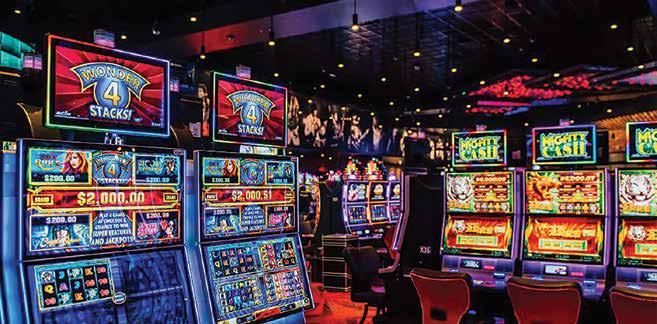
Serious about expanding, co-founder and CEO Jason Robins’ company was expected to lose $1.4 billion in 2021, sacrificing the monies to expand into more states (DraftKings’ CEO Robins Looks to Score His Biggest Jackpot Yet, Bloomberg, 2021).
FanDuel is 95 percent owned by Flutter, a United Kingdom (UK) based mobile gaming company and Bloomberg speculated that FanDuel was valued, as of April 2021, at $25 billion. Flutter, in December 2020, paid $4.2 billion to acquire the remaining 37 percent of FanDuel. (With Some Obstacles Out Of The Way, Perhaps 2022 Year For A FanDuel IPO, Online Poker Report, 2021).
In 2020, FanDuel reported $967 million in revenue (Does Boyd Stock Offer An Early Opportunity Ahead of FanDuel Spin Off?, TREFIS, 2021). Flutter trades on the London Stock Exchange and had a capitalization, in March 2021, of $39 billion (Sports betting company Flutter considers spinning out FanDuel to boost value, CNBC, 2021). Other investors in Flutter include Alphabet (Google), Comcast Ventures, Verizon Ventures and NBC Sports Group, to name a few (CNBC, 2021).
BetMGM has a partnership with Entain, a sports betting company based out of the UK worth $18 billion, as of September 2021 (DraftKings make $20 billion offer for UK sports betting company Entain, sources say, CNBC, 2021). DraftKings attempted to acquire Entain for $22.4 billion that same year (CNBC, 2021). BetMGM, trading on the New York Stock Exchange, expects to post $1.3 billion in net revenue in 2022, following a near $850
million 2021. They also feel that North America has the potential to be a $32 billion market, California being key in reaching that goal. In the first quarter of 2022, launches in Louisiana and Illinois will take place, as well as retail sportsbook in Puerto Rico, plus online and iGaming in Ontario, Canada. (MGM Resorts and Entain Announce BetMGM Business Update, MGM Resorts International, 2022).
Some experts place the annual gaming revenue for both internet and sports wagering in California near $10 billion and only $600 million for sports wagering conducted at facilities. Two of the four initiatives seek to have both in-person and online gaming avenues and the corporate initiative will push strongly for the iGaming version. The only qualified measure, thus far, permits in-person sports wagering only. Three of the four are attached to tribal communities and promise to deliver funds for state programs, like homelessness, and to tribal communities. If revenue projections are correct, or even close, and in light of the amount of funds to amend California’s constitution, and for tribes, to control the alterations, is it worth the gamble? Once publicly traded corporations are embedded in California, will they push for more gambling opportunities? How will tribes proceed without exclusivity?
In 2002, the Little Hoover Commission was asked, by elected leadership, to address limitations placed on cardrooms (Card Clubs in California, A Review of Ownership Limitations, 2002). One limitation was the exclusion of casino owners in other states, and
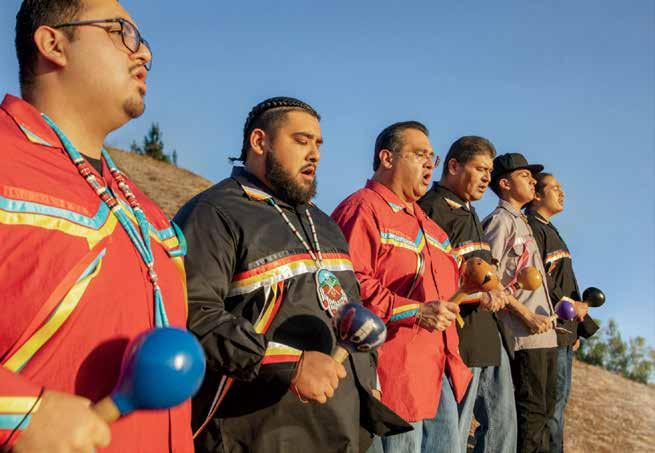
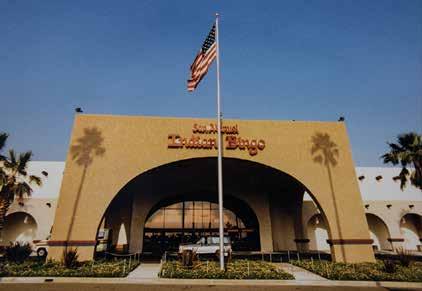
the second, regulated prohibition on publicly traded corporations (PTC), by requiring all shareholders to be licensed. The consistent reasoning behind such limits derived from the fear of crime, syndicated or individual.
Historical policy concerns, as reported, also included the expansion of gambling; if publicly traded corporations owned cardrooms, then they would seek to expand the scope of gambling. All factors considered, the Commission’s conclusion stated that such limitations on PTC owning cardrooms was “no longer necessary.” It reasoned that PTC are regulated by high standards, multiple jurisdictions, public oversight and are transparent. For California tribes, those conclusions placed them in a hypocritical-paradoxical corner: some tribes entered operational contracts with PTCs, as noted by the Commission, and yet, some tribes spoke out against them. So, why would today be any different?
Today, not only tribal governments, but the people of the state will be asked to grant full access to larger-than-life corporations, with no attachment to the Golden State. Some Californians favor DraftKings-FanDuel, others favor the other measures. The desire to expand gaming raises concerns for the exclusivity provisions resting in all the tribal-state compacts. Three of the measures open gambling and end the provision. If exclusivity vanishes, tribal governments, including those not engaged in gaming, will experience funding issues. Since tribes provide funding under the current system to tribes and local governments, those dollars will be less. The reign of tribal government gaming will end, and tribes must prepare for the inevitable. New economic engines will be needed.
In the summer of 2001, Chairman Daniel Tucker of the California Nations Indian Gaming Association, when discussing legislation addressing commercial gambling, stated that “big corporations will ultimately harm California tribes’ ability to support themselves by introducing widespread gaming into our cities and major communities. For the first time, Wall Street giants would control commercial gaming in this state.” By the end of the year, we all will know if Chairman Tucker was correct.
$4B+ $23.2B Annual Economic Impact (2018)
Invested in capital projects over the last 5 years
$200B+
Economic Impact in the last 10 years
$4.6B
$300M+
Charitable donations from San Manuel since 2003 Taxes and Revenue Share (2018)
1987
U.S. Supreme Court recognizes tribal sovereignty to regulate gaming
1993
1970-80s
Several tribes open bingo parlors
1986
San Manuel Indian Bingo opens
The National Indian Gaming Commission (NIGC) becomes operational to provide federal regulatory oversight of Indian Gaming
1988
Indian Gaming Regulatory Act (IGRA) signed
182,000
Jobs and $11.3B in wages (2018)
2001
California voters grant tribes the exclusive right to operate Class III casino games by amending the state Constitution with Proposition 1A
1998
California voters reaffirm Tribes’ right to continue gaming with the passage of Proposition 5
2005
San Manuel opens the new San Manuel Casino
2021
Yaamava’ Resort & Casino at San Manuel opens
2016-2017
San Manuel negotiates new tribal-state compact creating the Community Credit Fund to benefit the tribal and local communities
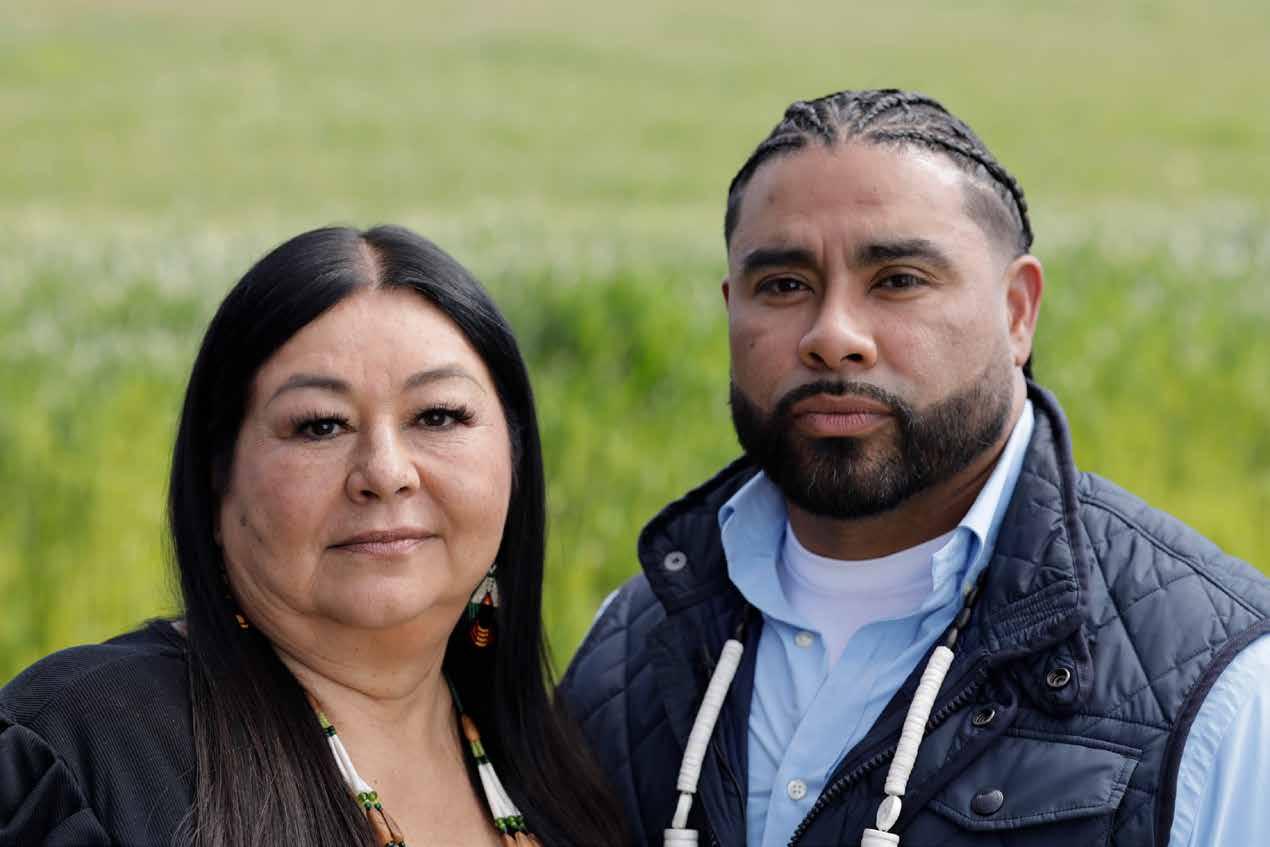
Protect the Promise.
Protect the Promise.
Over 20 years ago, voters granted our sovereign nations exclusive gaming rights.
Over 20 years ago, voters granted our sovereign nations exclusive gaming rights. Ad
Driven
Driven
Created hundreds of thousands of good jobs
Created hundreds of thousands of good jobs
Out-of-state corporations are coming to California with an online sports betting initiative that would break the promise between us.
Out-of-state corporations are coming to California with an online sports betting initiative that would break the promise between us.
I T’S BAD F OR TRIBES, AND ALL C ALIFORNIANS. Visit ProtectTribalGaming.com to learn more
Moriah MARTINEZ
From Educated to Educator
In December 2021, San Manuel Band of Mission Indians tribal citizen

Moriah Martinez took the last step in her undergraduate career as she earned a degree in Elementary Education with an emphasis in teaching English as a second language from University of Nevada, Reno.
Martinez began her educational journey in 2017, when she joined the Honors College, a decision that afforded her the opportunity to do independent research for credit. Martinez earned academic awards for excellence and completed her honors thesis on the eyewitness testimonies of primary school students under the Nazi regime.
While there were challenges along the way –and even a few moments where she considered quitting – Martinez now feels as though a huge weight has been lifted. “There were a few times when I wanted to give up,” she said. “But now I feel like a bird that’s been released from a cage, finally flying over the clouds.”
Martinez acknowledges that reaching her goal was a collaborative effort. “I’m abundantly grateful for the tremendous support I received from San Manuel’s Education Department (especially Liz Brierty), from my whole amazing family, especially my mom Deborah, dad Marty, sisters MaryBeth and Mikaela and hardworking grandparents Roy and Beulah Chacon.” She also credits her Lord Jesus and church community at the House of Mercy on the Paiute Reservation for her success.
Next up for Martinez is well-earned time with the ones she loves. “I learned that time with my family is where the riches of life are,” she said. Professionally, Moriah plans to research master’s programs and tutor both adults and children. Personally, she looks forward to pursuing passions such as learning languages, including Serrano, and exploring music and writing projects.
When asked what she had her sights on in the upcoming years, Martinez explained she wants to continue to support children and adults in their education. “I hope to merge my love of history and diverse languages and my faith with my passion for helping others learn. And who knows, in five years, I may be writing educational books and designing web content in those subjects.”
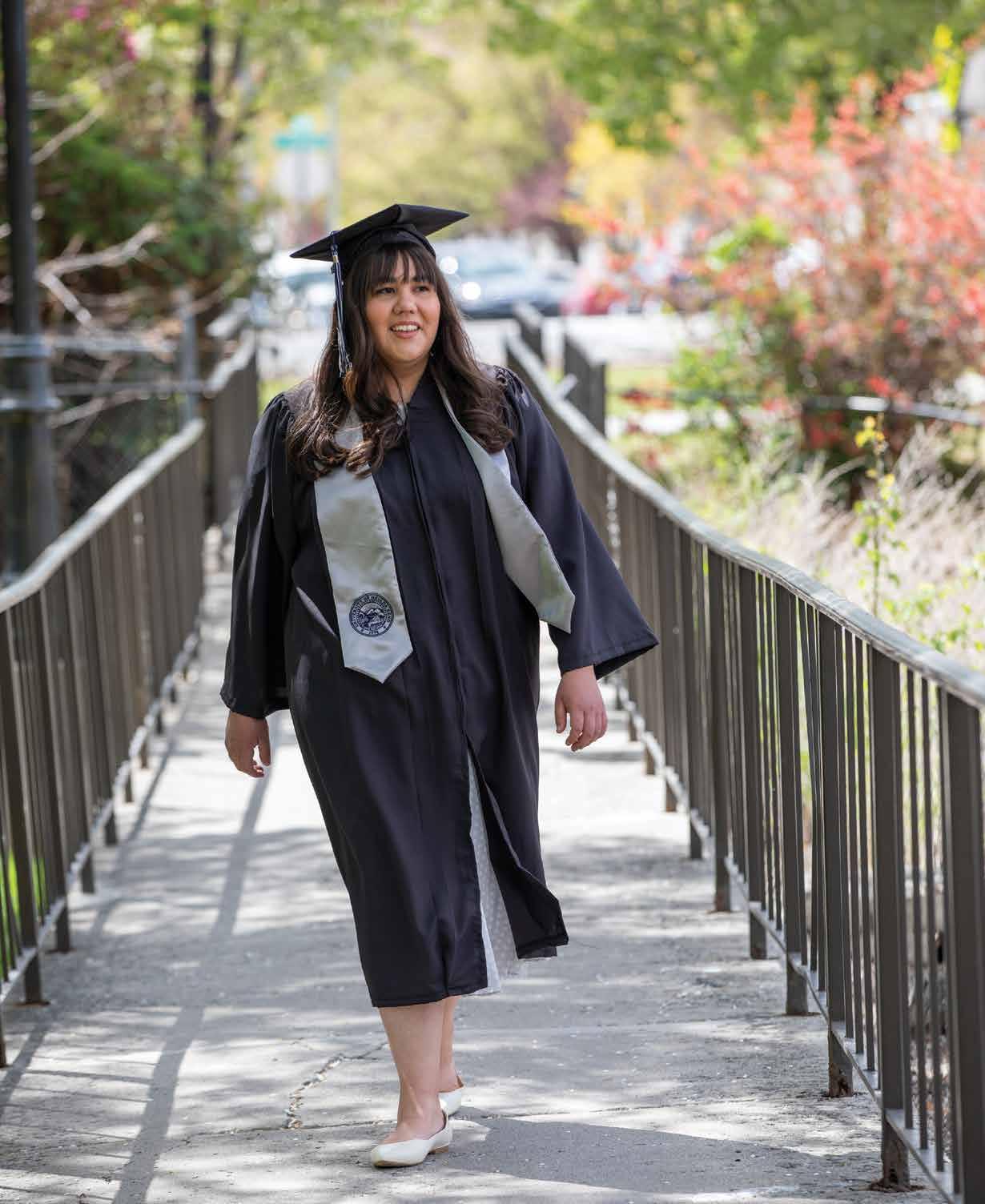
Relax and rejuvenate in a boutique hotel environment nestled in the foothills of the San Bernardino Mountains.
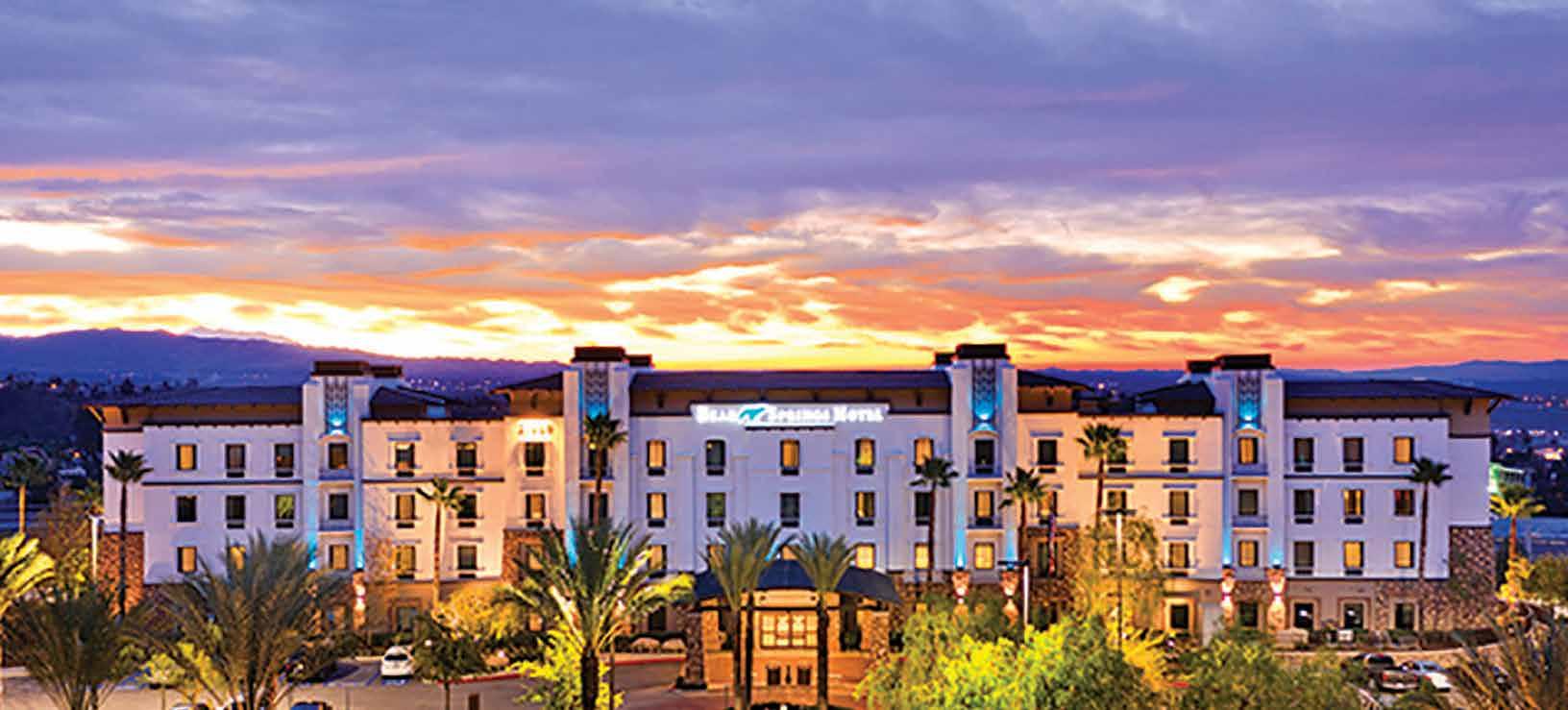
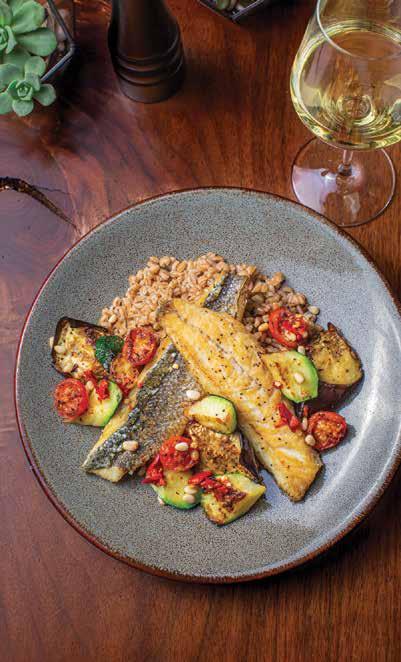
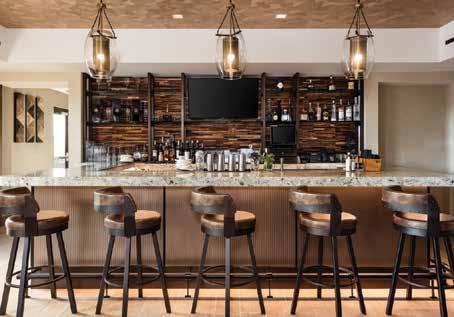


Enjoy an exquisite selection of American-style bistro specialties, 24/7 in-room dining, and complimentary 24/7 shuttle service to Yaamava’ Resort & Casino at San Manuel.
| 833-258-4745
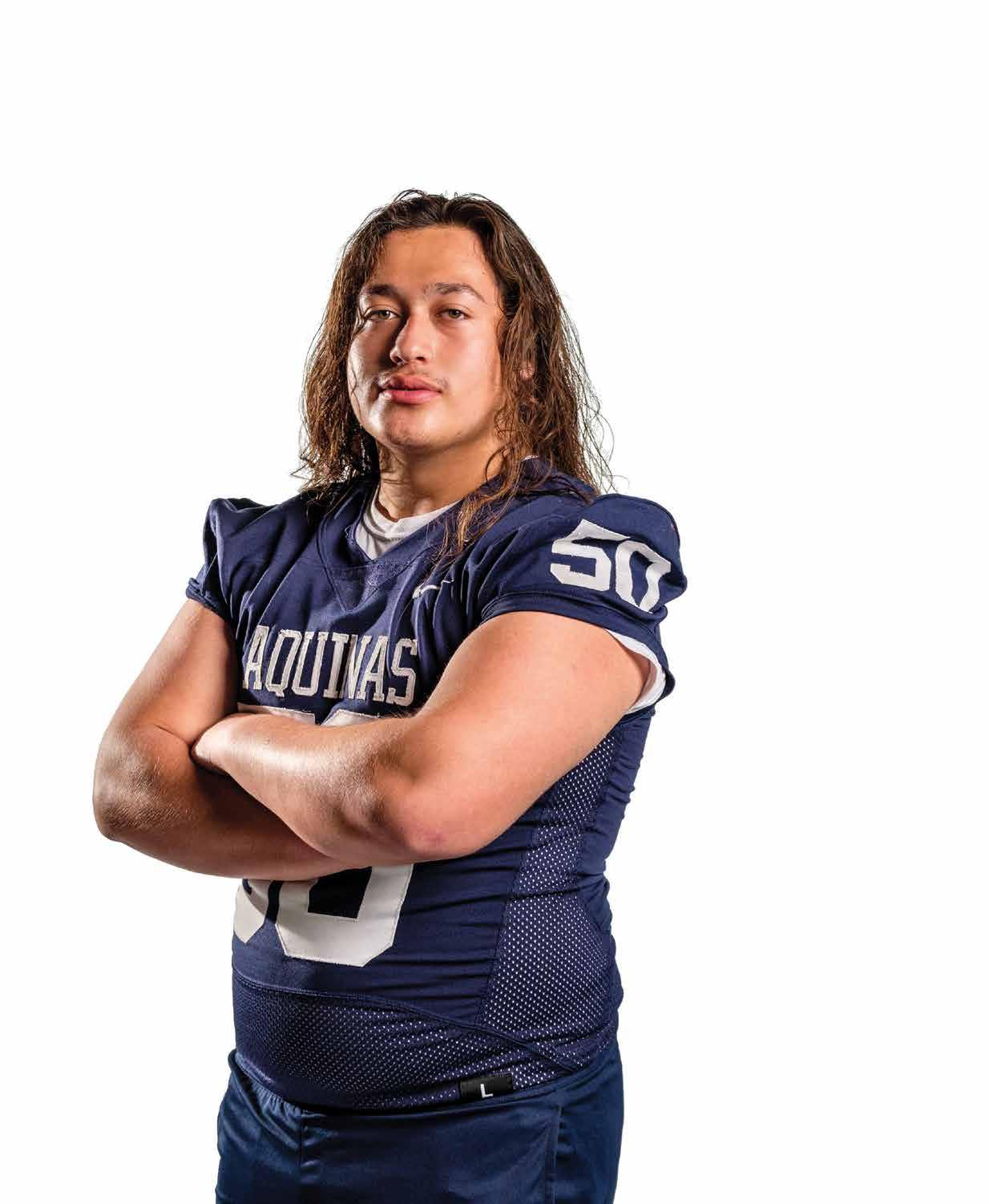
Hawk Ramos knew he wanted to play pro football before he even hit double digits. Thanks to the encouragement from his family, and the inspiration from his grandfather, he made a commitment to do his best, both on the field and off.
Now the San Manuel Band of Mission Indians citizen shares what he loves about the game and where he sees himself in the coming decade.
Q: When did you first know you wanted to play football?
After finishing my first season when I was in third grade, I knew I loved football. My favorite thing was spending time with my team. I loved the camaraderie.
Q: Tell us about your grandfather’s influence on your choices thus far.
My grandfather influenced my choices with school, my athletic career and the kind of person I want to be. He wanted me to be the best in whatever I did and at everything: a good son, student and athlete.
Q: Do you have your sights set on college-level football? The NFL? I want to play college football. I’m hoping to go to a Division 1 college. My top dream schools are University of Miami, Ohio State and USC. Then I want to go to the NFL.
Q: As of now, what are you most proud of?
My biggest accomplishment is making it to State Championship in Fairfield with my team.
Q: What were some of the thoughts running through your head when you helped secure your team’s spot in the State Championship?
That I would earn this ring and next time, give even more. As for what’s next, I want another shot at State next year.
From Then to Now
A look at the resilience and determination of the Yuhaaviatam to remain self-sufficient and sovereign.
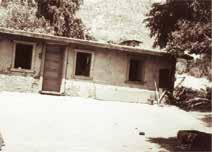
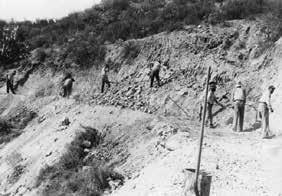
1700s-1820s
Spanish missionaries and military encounter the Yuhaaviatam (one clan of the Maara’yam), which they call “Serrano” or “highlander.” Many Maara’yam are forced into the mission system as slave labor for Spain.
CREATION
Since Time
Immemorial
Maara’yam
people inhabit the mountains, valleys and deserts of Southern California.
1850s-1860s
American settlers invade Serrano territory. CA governor instructs militias to exterminate Native people. Yuhaaviatam are killed and chased out of their territory.
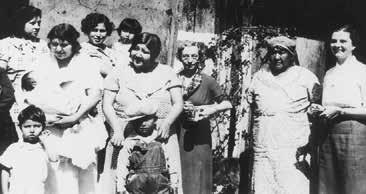
1880s
Native American boarding schools are established in the U. S. with the primary objective of “civilizing” or assimilating Native American children and youth into Euro-American culture, while destroying and vilifying Native American culture.
TREATY MAKING

1866
Raids and bloodshed decimate the Tribe.
Kiika’ Santos Manuel makes a decision to courageously bring the remnant of his people from the mountains to safety on the valley floor.
Early to Mid-1900s
Tribe adapts and adjusts to reservation life. U.S. government continues to dictate what the Tribe can and cannot do.
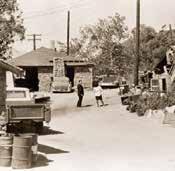
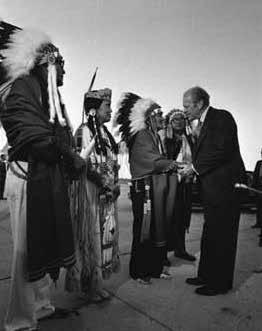
1975
1966
Articles of Association are adopted by San Manuel Band of Mission Indians.
President Ford signs the Indian SelfDetermination and Education Assistance Act, a federal policy of Indian selfdetermination, first declared by President Nixon.
THE NEW DEAL
ASSIMILATION
1934
1891
U.S. government passes the Act for Relief of Mission Indians, which recognizes the Tribe as a sovereign nation and establishes the Reservation. The Tribe chooses the name San Manuel Band of Mission Indians.
Indian Reorganization Act is enacted by U.S. Congress, aimed at decreasing federal control of American Indian affairs and increasing Indian self-government and responsibility.
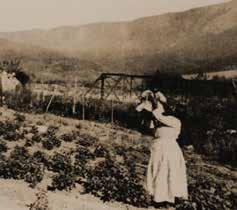
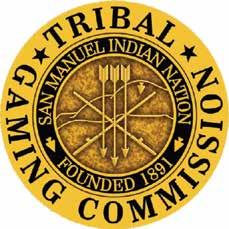
1970
In address to Congress regarding the federal policy of terminating relationships with tribes, President Nixon states, “This policy of forced termination is wrong.” He then outlines a policy of self-determination rather than termination.
Photo courtesy of the Gerald R. Ford Presidential Library
A.K. Smiley Public Library, Gerald Smith Collection
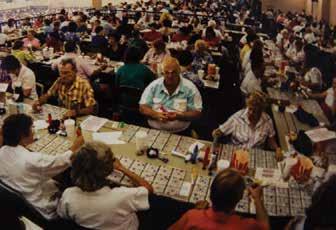
1986
San Manuel Indian Bingo opens.
1978
Indian gaming movement begins with Seminole Tribe of Florida.
1987
California v. Cabazon: U.S. Supreme Court landmark decision affirms right of tribal governments to conduct gaming on their lands.
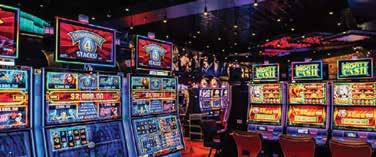
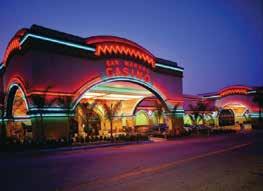
1990s-2000s
Tribe takes an active role in passing Proposition 5 and Proposition 1A.
1998
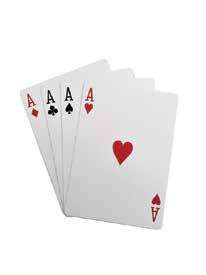
Proposition 5 is supported by 63 percent of voters in favor of gaming by Indian tribes in California. A lawsuit by a labor union causes the measure to be struck down by California Supreme Court.
SELF-DETERMINATION
1988
Indian Gaming Regulatory Act passes, creating statutory framework for Indian gaming.
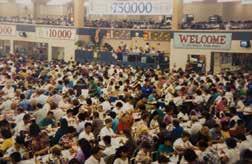
1980s
SMBMI seeks new business opportunities to strengthen sovereignty and journey towards self-sufficiency.

1994
San Manuel Indian Bingo adds gaming operations and advances goal of economic selfsufficiency.


2000
Residence Inn by Marriott opens in Washington, DC. The project is from the Four Fires intertribal economic partnership, which includes San Manuel Band of Mission Indians.
2017
Tribe transforms bingo hall into Rockin’ Casino area.
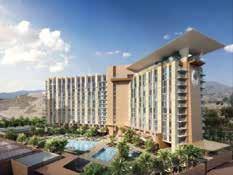
2021
2019
San Manuel Gaming and Hospitality Authority forms to explore economic growth opportunities.
San Manuel Casino becomes Yaamava’ Resort & Casino at San Manuel.
Yaamava’ expansion project opens including gaming spaces, new restaurants, lounges and hotel tower, as well as retail, spa and pool amenities.
STRENGTHENING OUR FUTURE
2006
San Manuel Band of Mission Indians breaks ground on San Manuel Village in Highland, CA, a mixed-use, off-reservation, commercial development.
2007
Residence Inn by Marriott opens in Sacramento, CA. The project is from the Three Fires intertribal economic partnership, which includes San Manuel Band of Mission Indians.
2008
Hampton Inn and Suites Hotel opened in Highland, CA, at San Manuel Village, a development of the San Manuel Band of Mission Indians.
Proposition 1A, supported by 65 percent of California voters, changes the state constitution and provides exclusive right to Indian tribes to operate a limited scope of casino-style gaming on Indian lands, in accordance with federal law.
2018
Opening of the Autograph Collection, The Draftsman Hotel, in Charlottesville, VA, a joint venture that includes the San Manuel Band of Mission Indians.
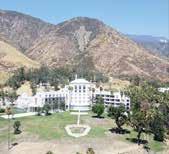
2016
SMBMI acquires sacred lands in San Bernardino Mountains with purchase of Arrowhead Springs Hotel.
2022
San Manuel Gaming and Hospitality Authority opens the Palms Casino Resort in Las Vegas.
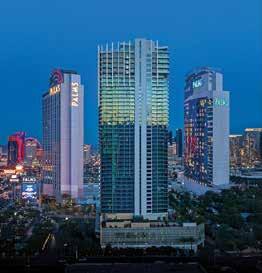


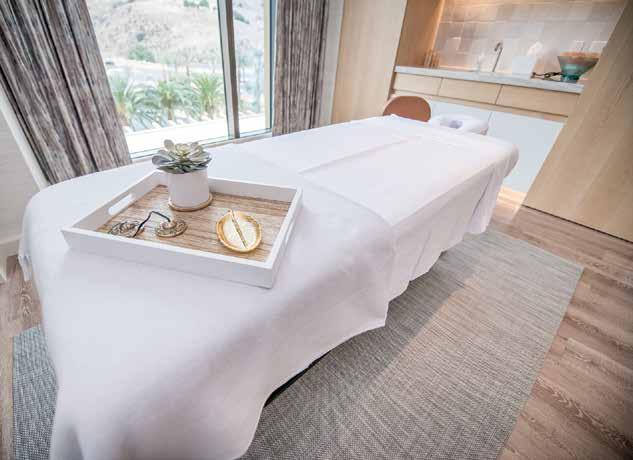

Q: What was the inspiration for Waterlily Designs?
PM: I was raised with a diverse, traditional, educated, well-traveled and culturally collaborative family and my garments and textiles reflect these rich experiences. You’ll also see my love of nature, culture and travel.
Q: How would you describe your brand’s aesthetic?
PM: Modernity in Native American designs. I know my fibers and I’m not afraid to explore different uses of fabric. I also bring culture and history to design – with clean, subtle aesthetics and unique details.
Q: As a Native American designer, where do you see Native American culture in the fashion world today?
PM: There has always been a place on the runway for our ancestors’ work but now we have a chance to share our own narrative: that we are still here – alive and full of pride just as our people before us.
Q: One of my favorite things about Indigenous designers is the way they share their culture and pass on knowledge/storytelling through clothing. How do you approach design through this process?
PM: The richness of storytelling comes from being a Taos Pueblo Native. Our language and traditions are orally taught so we have this understanding of where we come from and who we are. All of this has given me a beautiful palette for silhouettes, draping, textiles, designs and new fabrications.
Q: How do your designs connect with your culture and tradition?
PM: My culture dates back to pre-Columbus, when Taos Pueblo was a main trade center between South America and Canada. My fashion helps bring the truth of my people and other tribes’ sophistication of travel and commerce.
Q: It has never been more important for brands and consumers to embrace sustainability. Tell us why sustainability is so important to First Nations designers and yourself.
PM: Our people carry history of who we are and knowledge of the land and life around us. One

PATRICIA MICHAELS
Back to Nature
Inspired by her culture and surroundings, Native American designer Patricia Michaels carves out a place in the fashion world with her vision and unmatched use of textiles.
By Christie Moeller
Many First Nations fashion designers have brought profound contributions to the industry: from centuries-old weaving techniques and intricate beadwork to storytelling through textile and pattern. Patricia Michaels is one such designer. For more than 20 years, the Taos Pueblo Native – and Project Runway alum – has produced haute couture inspired by the culture, landscape and art of Santa Fe, New Mexico. Hamiinat sat down with Michaels to discuss her designs and where she sees Native designers in the future.
way we pass this down from one generation to the next is through ceremonial clothing.
Q: You’re known for your gorgeous hand-painted garments and unique use of textiles. Can you talk about this process?
PM: Our ceremonies at Taos Pueblo are in the beautiful Rocky Mountains. The vast landscapes and small details are my palette and silhouette for my textiles, cut, drape and construction. I start with an image inspired from ceremonies, nature and my clients, then I lay out white silk and paint, felt and bead embellish anywhere from one to seven yards of fabric. I then steam and dye into the fibers and wash, rinse and press. From there I cut, drape and sew.
Q: What are some cultural considerations consumers should be aware of regarding Native-inspired looks?
PM: Native regalia has inspired the runway for decades but there is a fine line between a designer being inspired by another culture and copying it directly. There is significant ceremonial meaning behind what we make for our tribal people and if one doesn’t understand these boundaries, they shouldn’t design highly stylized cultural garments.
Q: You’ve talked about Native American style moving forward as new materials and techniques came with the arrival of new people. How are you moving it forward now?
PM: The best advice I’ve ever been given is, fashion is about change, keep exploring it In that spirit, I embrace all opportunities: social media, short films and digital fashion, such as the digital printed fabrics I brought to the uniform industry while working with Cintas. This gives me a platform to stay in the public eye, in boutiques and museum shops. I’ve also competed on the world stage, which brought awareness to the fact that Native designers exist – and will have a voice with our vision.
See Michaels’ beautiful use of color, pattern and textiles on page 34 and 38.
Photo by Jennifer Esperanza

Silverthorne Prism Sandal by Minnetonka Moccasin available at minnetonkamoccasin.com
Upcycled Vintage Military Flysuit by 4Kinship available at 4kinship.com

From muted to bold, subtle to stand-out, these pool-ready styles make it easy to welcome sun-drenched days with open arms.
Shot at the new pool at Yaamava’ Resort & Casino at San Manuel.
Photography by Robert John Kley
STYLED BY CHRISTIE MOELLER
STYLE ASSISTANT BY TIFFANY WEEKES
HAIR & MAKEUP BY KRYSTLE RANDALL
MODEL PROVIDED BY NEXT MANAGEMENT

Bikini top by SHAN available at Serrano Spa at Yaamava’ Resort & Casino.
Upcycled Vintage Parachute Skirt by 4Kinship available at 4kinship.com.

Vintage ‘80s Stephen Sprouse Swimsuit available at 4kinship.com.
San Manuel Band of Mission Indians Annabella Blanket by Pendleton custom designed by Tribal Youth Annabella Hernandez.

Turquoise Gem Bikini and Dragonfly Jacket by Waterlily Fashion by Patricia Michaels available at waterlilyfashion.com.
Beaded Necklace by Aaron Rock available at 1891 Boutique.

Professor Hellen Milroy One Piece by Liandra Swim available at liandraswim.com.

Mille Miglia 300P Sunglasses by Chopard available at HERS Boutique. Gwen One Piece by Liandra Swim available at liandraswim.com.
Indian College Fund Gift of Earth Blanket by Pendleton available at pendleton-usa.com.


Native Hand Print Bikini by Waterlily Fashion by Patricia Michaels available at waterlilyfashion.com.
Puyu’houpkcav
(poo-yoo-hope-k-chahv)
TOGETHER
Puyu’houpkčav: together. When all are together as one, we accomplish more. We strive each day towards unity of purpose and spirit.

Get a peek behind the scenes of the extraordinary party that heralded the opening of the new Yaamava’ Resort & Casino at San Manuel. Learn about the new Santos Manuel Student Union at CSUSB, a place that offers community for all. Hear from the talented architect that designed the multi-faceted, fun-filled destination within the iconic Dodger Stadium. And get insight from the CEO of a food bank, who is working to end food insecurity in Las Vegas with the help of San Manuel.
FORCE for A
CHANGE
Santos Manuel Student Union is big in size, big in heart and big in its breadth of services.
BY RICHARD ARLIN WALKER
The North Santos Manuel Student Union at California State University, San Bernardino, is 127,000 square feet of concrete, glass, wood and steel, but there is much that its namesake – the 19 th century Yuhaaviatam leader Santos Manuel – would recognize.
It’s a gathering place in the shadow of mountains that know the Bird Songs and the footsteps of the Yuhaaviatam people.
It’s a place of yawa’, the Yuhaaviatam word meaning “to act on one’s beliefs,” that instills social values that students will carry with them into their career fields and communities.
It’s a place that upholds diversity and inclusion, just as Santos Manuel upheld his people’s right to exist in a changing world.
It helps tell the story of the Yuhaaviatam people in certain architectural details, furnishings, graphics and displays of cultural objects.
conditions of the present,” CSUSB President Tomás D. Morales told Hamiinat magazine. “The life of Santos Manuel is not only one of the brighter threads in the history of the Inland Empire, it is also physically tied to the land where our university is located. This is why we respect, honor and publicly acknowledge that our campus is located on the unceded Indigenous homeland of the Yuhaaviatam First Nation in San Bernardino.”
Ken Ramirez, then Chairman of San Manuel, acknowledged the significance of the new multiuse structure, noting that with the expansion, the Santos Manuel Student Union stands as one of the largest building complexes in the Cal State System named after a tribal leader. Ramirez said, “When I see this place so full of life, I feel as if I am in the presence of my greatgreat-grandfather Santos Manuel… who was first and foremost a community builder.”
To move forward into the future, we must acknowledge the histories of the past and the conditions of the present.
And it promotes social justice by its very name.
“To move forward into the future, we must acknowledge the histories of the past and the
Anthony Roberson, the university’s Associate Director of Operations, added, “I think about where we are – on sovereign land, on Native land. I think it speaks to us as a university when we talk about diversity and inclusiveness. As a higher education institution, we want to make sure we teach our students and
Image courtesy of California State University, San Bernardino

our community about the Indigenous people of this land and their culture.”
The Santos Manuel Student Union opened in February after two years and eight months of construction. The $90 million project was designed by LPA Architects in Irvine and built by Hathaway Dinwiddie of Los Angeles.
The San Manuel Band of Mission Indians kickstarted the planning for the student union about 20 years ago when it gifted $2 million to
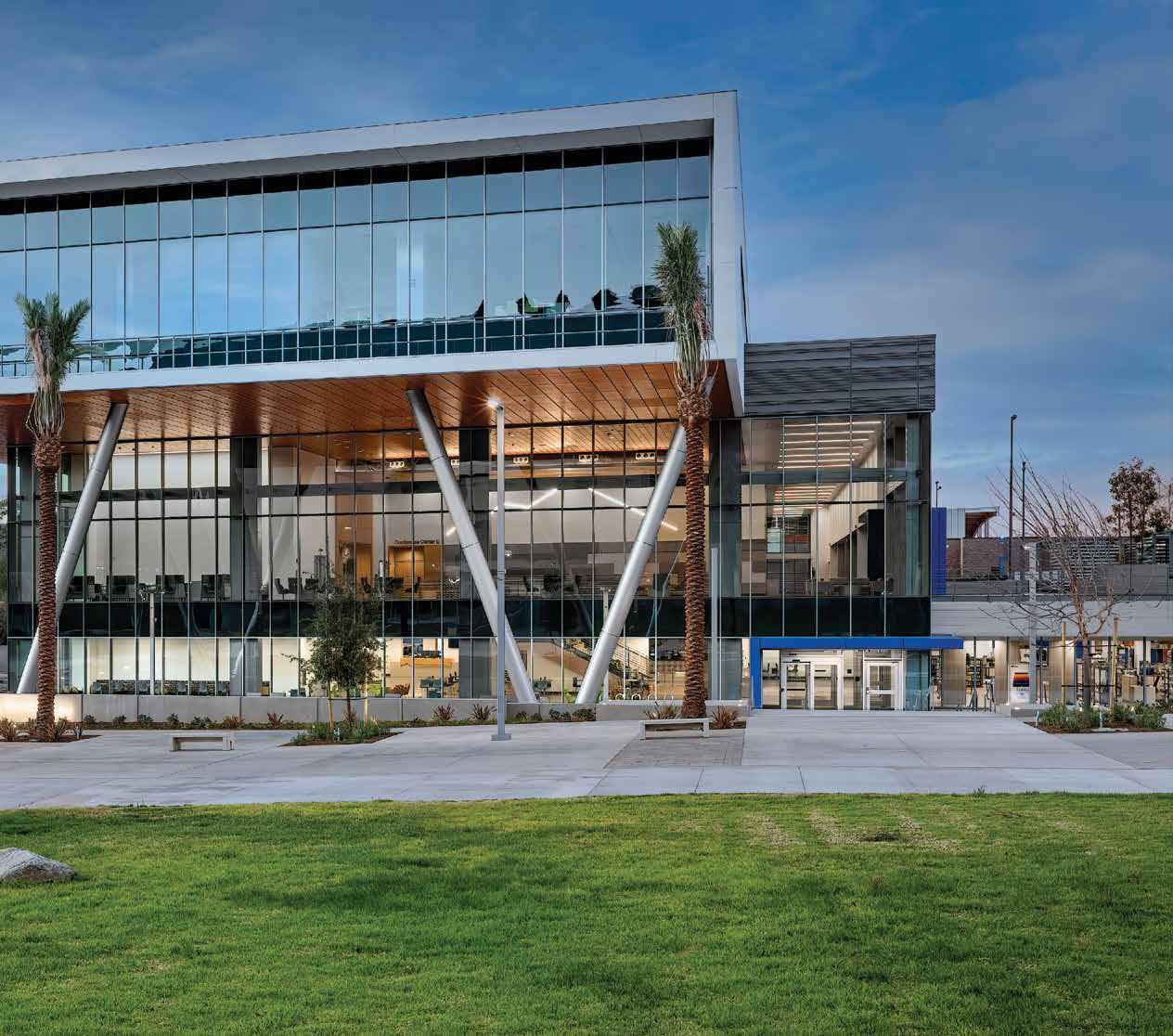
CSUSB – $1 million for planning and $1 million for an endowment to support student services.
“It is the most prominent building on campus because it’s in the heart of the campus,” Roberson said. “The Santos Manuel Student Union is the living room of the campus. It’s a beautiful building and the architecture is incredible.”
Julia Ruiz, Navajo, is Chairwoman of the Board of Directors of the Santos Manuel Student
Union and the Recreation and Wellness Center.
“They’re not just buildings,” Ruiz said. “Yes, structurally they are buildings, but what happens within them is so beautiful because people find themselves – they find where they belong and who they are and where they want to go.”
The Santos Manuel Student Union takes “social hub” to a new level. On the first level is a

pub with outdoor seating, an eight-lane bowling alley, restaurants, retail space, dining and lounge areas and a bookstore.
The second level has a conference center with a ballroom, dividable into five rooms, a catering kitchen and an outdoor plaza.
Santos Manuel

Some 500 students are employed on the first and second floors.
The third level features many support services that formerly didn’t exist or were located at separate sites on campus. “We initially had three major affinity centers before this expansion, but the number of centers that we have now has grown exponentially,” said Jesse Felix, Executive Director of the Santos Manuel Student Union and the Recreation and Wellness Center.
There’s the Adult Reentry Center, Asian Pacific Islander Center, Undocumented Student Success Center, First Peoples’ Center, LatinX Center, Pan African Student Success Center, Queer and Transgender Resource Center, Title IX & Gender Equity Office and the Women’s Resource Center.
Literacy Center, Student Career Center, Graduate Student Success Center, Veterans Success Center, Commuter Lounge, eSports Arena, meeting rooms, theater and the Office of the Vice President for Student Affairs.
First-year students of all ages can get help navigating the path to a degree, get a job to help pay tuition and learn to manage their finances.
A student can access snacks and food and catch a
people, but not necessarily always engage. And so, there are a lot of little areas where a student can sit and study with maybe two or three people and have their group convene without being a part of the bigger environment. And then, in some of the bigger places, you’ll have outcroppings where you’ll have a seat where a student can sit by themselves – they’re alone, in the community.
We have a student union unlike any other. There are opportunities for interaction between people from different walks of life... that didn’t exist before.
nap between classes on a couch – whatever he or she needs so they can concentrate on their studies.
“I think the one thing that’s really taken off is our social stairs, which is a place where students can do just that – they have the staircase that overlooks the entire area and they can study, they can work on homework, but yet still be around other people.”
More services are available in the adjacent Santos Manuel Student Union South, an 87,000-square-foot center that served as the original student union and is connected by an outdoor plaza to the new student union. Roberson said SMSU South houses the Financial
“We call the Santos Manuel Student Union the living room of the campus,” Felix said. “What’s really changed in student life is how students congregate. One of the things on the students’ list during the design process was the ability to be in public, while also being able to study and work alone – they wanted to be around other
Bringing all of this under one roof was not possible with the original student union building, now known as Santos Manuel Student Union South. At 87,000 square feet, the building was often crowded. “You couldn’t walk through there at times,” Felix said.
“I love to walk into the new building and see students there with their cell phones out, taking
pictures and sharing them on social media. We have a student union unlike any other. There are opportunities for interaction between people from different walks of life, so to speak, that didn’t exist before.”
Leading with love, walking with intention
According to Dr. Paz Oliverez, Vice President for Student Affairs, 70-80 percent of CSUSB students are the first in their families to go to college; 66 percent are Latino/Latina; 12 percent are White; 5 percent are African American; 5 percent are Asian; and less than 1 percent are Native American. Some 1,400 students are veterans or are active duty or reservists.
San Manuel Student Union Board
Chairwoman Ruiz, a junior at CSUSB majoring in kinesiology and minoring in diversity and social justice, commented on her role. “I believe in our past census there were only about 300 Native American students and that just blows my mind, because we have so many organized tribes in this area,” Ruiz said. “I think there’s a lot of opportunity – and I believe it’s my responsibility – to ensure that the youth of the tribes know that they have a home here.”
There are four federally recognized tribes in San Bernardino County and 11 in Riverside County. All told, there are 109 Tribal Nations in
34 counties in the State of California. They are part of an increasingly diversified population in an increasingly diversified regional economy. Housing construction grew 16 percent in 2021, according to the California Credit Union League. “Because of the Inland Empire’s economic structure and composition of jobs across different sectors of the local economy, its post-pandemic recovery will outpace California and the entire nation,” the association reported on its website. Those sectors include e-commerce, wholesale trade, transportation and warehousing. Meanwhile, the region’s population continues to grow – it grew 8.9 percent during the pandemic – as people are drawn by climate, housing availability and career opportunities.
The Santos Manuel Student Union, with its array of services and support, is helping students prepare themselves so they can contribute to the region’s vibrancy.
“I was just talking to a couple of students who were staffing an event in the student union last night, and they were talking about the kind of skill sets they developed as employees,” Oliverez said. “One of the students is doing work directly connected to his major and his field of study, which means he’s building skills to put on his resume that will make him more competitive in the job market after he’s earned his degree.”
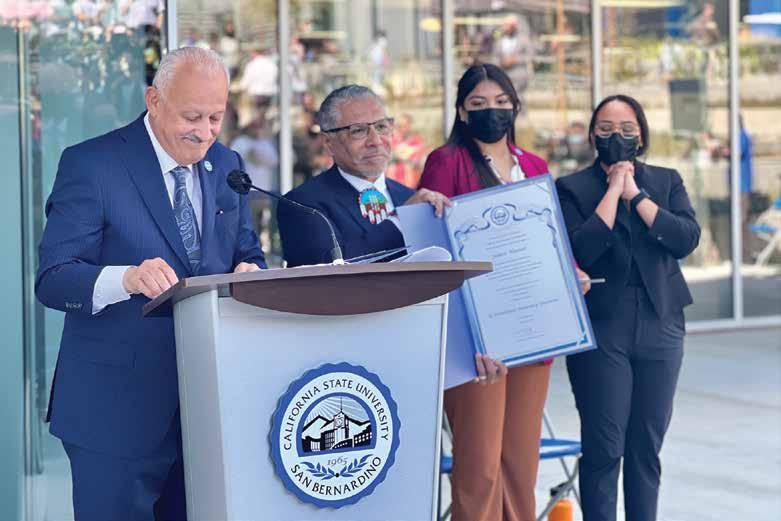
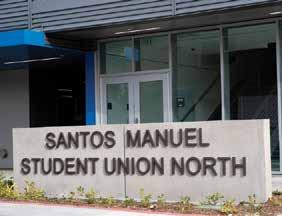
The Santos Manuel Student Union, or SMSU, comprises five venues at California State University, San Bernardino.
SMSU NORTH
127,000 square feet
Affinity centers, recreational venues, gathering spaces, retail spaces and restaurants, bookstore, conference center.
SMSU SOUTH
87,000 square feet
Financial Literacy Center, Student Career Center, Graduate Student Success Center, Veterans Success Center, Commuter Lounge, eSports Arena, meeting rooms, theater, and the Office of the Vice President for Student Affairs.
SMSU EAST
8,500 square feet
A recreation and wellness center with yoga room, massage chairs, group exercise room and multi-purpose classroom.
SMSU AMPHITHEATER
11,000 square feet
RANCHO MIRAGE STUDENT CENTER, CSUSB’s Palm Desert campus 1,800 square feet

She added, “Research shows that students who are employed on campus during college have a much higher success rate when it comes to staying in school and earning their degrees. So, the fact that a building like this is able to provide those jobs just continues to contribute to supporting our students’ success while they’re with us.”
Oliverez said CSUSB is a transformative force in the region because many students who graduate from CSUSB stay in the Inland Empire.
“Across the Cal State system, you have a lot of campuses where students are coming from all over the place, and they go there and earn their degrees and then they leave. But in our case, the majority of our students actually stick around this area, which is wonderful because it increases the number of people in this region who have college degrees and it creates a significant level of upward mobility for our students and families in this region as well.”
Ruiz and Felix said the Santos Manuel Student Union – its care for students from day one to
graduation and its commitment to diversity and inclusiveness – also is helping to create forces for social change in the region.
“In everything we do, we lead with love,” said Felix, who earned undergraduate and graduate degrees in logistics and operations management at CSUSB and is working on his doctorate in educational leadership with an emphasis in social justice.
“But our social change model is about getting students to look at who they are, to reach students from an anti-deficit lens to talk about how amazing they are and what it is they bring to campus, and for them to understand their core values so they can impact the community in the future. So, the whole goal of that is: Who am I as a person, what change do I want to make, and how do
I use my position to make a positive impact not only here on campus, but in the region?”
Ruiz added, “We’re building a better world and a better Inland Empire. Jesse always mentions that we lead with love. I always respond with, ‘And we walk with intention.’”
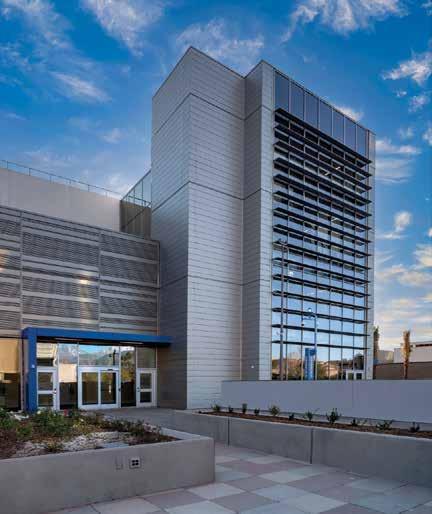


PROUDLY FEATURING
100% REAL & CERTIFIED JAPANESE KOBE BEEF
The Pines Modern Steakhouse at Yaamava’ Resort & Casino at San Manuel is the proud recipient of the bronze statue of Tajima-Gyu as a symbol of authenticity to serve authentic Kobe beef.
As one of a select number of fine steakhouses in the country to receive this distinction, The Pines’ Kobe beef offering complements their outstanding selection of fresh, high-quality seafood, unique desserts and a world-renowned wine selection.
To view the exquisite menu, visit yaamava.com

Up, Up and Away
Breeze Airways makes daily nonstop service between San Bernardino and San Francisco a reality, expanding the horizon for millions.

It was the announcement heard around the world; at least that’s the way it felt for airport’s leaders, the elected officials that sit on the commission, airport staff and business and leisure travelers in the Inland Empire.
On a sunny morning in early March, just outside the departures entrance to San Bernardino International Airport’s (SBD) domestic terminal, a representative from Breeze Airways announced daily nonstop service between SBD and San Francisco International Airport (SFO), beginning August 4, 2022. It was a moment met with excitement and joy. Residents and businesses throughout the Inland Empire now have more choice in air travel that is closer to home but without the gridlock found around other Southern California airports.
“Breeze Airways’ announcement of daily nonstop service to SFO is a monumental moment for our inland Southern California region and our communities that have supported the base reuse effort for many years, invigorating the resurgence of true travel options for our residents, businesses friends and families,” said Frank J. Navarro, SBD’s Commission President and Mayor of the nearby City of Colton.
Thirty years in the making, this announcement marks SBD’s first-ever scheduled passenger flights. Offering airline service to the Inland Empire region has been a goal since the transition from the former Norton Air Force Base to a now thriving public airport that supports air cargo, business and general aviation as well as maintenance, repair and overhaul operations.
According to Michael Burrows, Chief Executive Officer of SBD and the Inland Valley Development
Agency, “This new partnership with Breeze Airways is the culmination of decades of federal, state, regional and local focus on revitalizing what was the amazing Norton Air Force Base and is now the thriving SBD International Airport. We are here to support our communities, our businesses, partners and new friends for many years to come. Our region’s confidence brought us to this day, and we honor and appreciate our residents now by offering this incredible travel option right here at SBD.”
Part of the transition to a public-use airport meant building new facilities while rebuilding and rehabilitating existing infrastructure to support a wide range of aviation activity. In fact, the airport has maintained a passenger terminal building since 2010, serving passengers traveling on charter flights. “SBD and partners have worked hard to achieve this milestone in our airport’s history, and our region deserves this outcome,” Navarro continued. “We are proud of SBD’s current staff who are helping us make history, and appreciate their efforts to get us ready for scheduled passenger service beginning in August.”
San Francisco, the Bay Area and Northern California are in the top-requested domestic destinations from the Inland
Empire and SFO offers easy flight connections with nonstop service to 150 cities across North America and the globe on approximately 50 domestic and international airlines.
Breeze, launched by JetBlue founder David Neeleman, connects travelers in communities underserved by air service to the U.S. cities they want to visit most, by delivering affordable fares, state-ofthe-art technology and its signature Seriously Nice™ service. Breeze will inaugurate the new SBD-SFO nonstops with Embraer E195 aircraft, seating 118 passengers with 22 seats offering extra legroom. The E195’s two-by-two seating configuration means there are no middle seats onboard.
Breeze Airways’ modern aircraft, friendly employees and low air fares, along with SBD’s convenient and accessible airport will help redefine air travel options through the Inland Empire. Flights are on sale now and can be booked by visiting sbdairport.com or directly at FlyBreeze.com
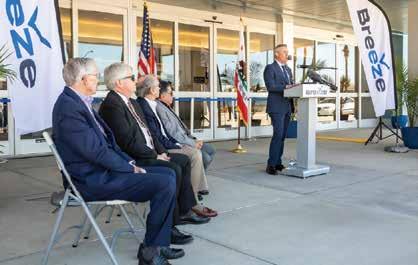
Michael J VanGorder Photography
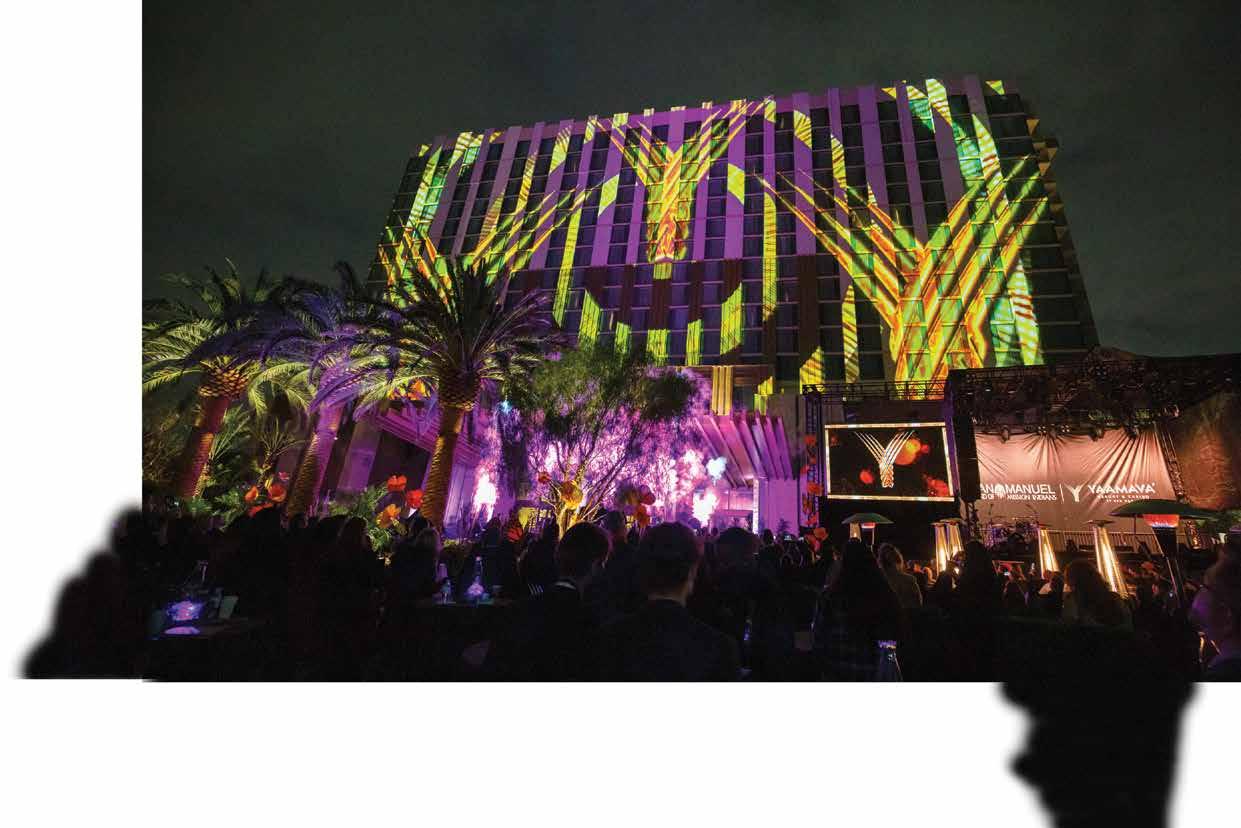
In Grand Style
Creativity, history and hard work come together for an epic celebration of the new Yaamava’ Resort & Casino
Hundreds of tribal citizens and guests gathered on a chilly winter evening in Highland, California to welcome a true change in season as Yaamava’ Resort & Casino at San Manuel opened its doors December 13, 2021. Yaamava’, meaning spring in Serrano, was years in the making and the stunning transformation of the property into a world-class resort called for an unforgettable celebration uniting tribal government, hospitality trendsetters and VIPs.
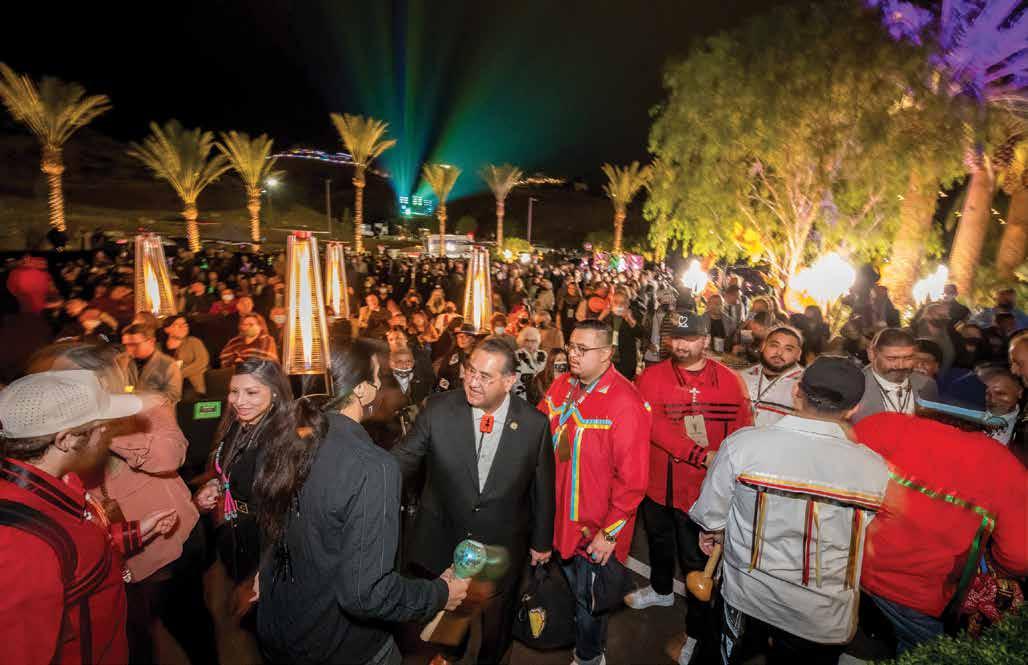
BY MELINDA SHECKELLS
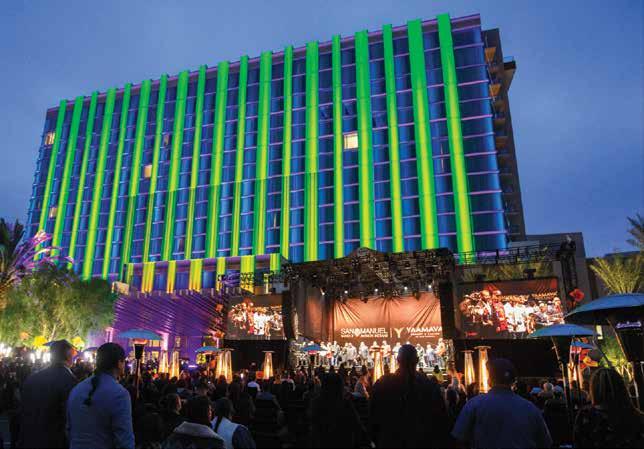
The ceremony opened with beautiful songs from the San Manuel Bird Singers, putting the audience in a state of contemplative bliss, before San Manuel Band of Mission Indians then Chairman Ken Ramirez, members of the Business Committee and Yaamava’ Resort & Casino General Manager Peter Arceo spoke.
Ramirez shared the history of the land – how it was not part of the Reservation, but instead a dream and vision for what was to come – as well as his personal memories of working for the previous owner. From project approval to groundbreaking to opening, Yaamava’ faced many obstacles, including a global pandemic, in addition to rerouting the California Aqueduct Pipeline and undoubtedly the biggest employment crisis ever faced by businesses.
“The highlight of the event for me was members of the Tribe sharing their history and perspective on what this grand opening and expansion meant to them as individuals and as a group of people,” Arceo said. “Hearing the speeches... was very touching and level set everyone in attendance as to what was most important.”
On reflection, Arceo said he will never forget the bird singers standing on stage. “I’ve never seen an event with so many of the bird singers before. And the songs they sang were much more than what is traditionally part of team member/casino events,” he explained. “It was quite a sight to see and hear. I’m so happy the Tribe shared that part of their culture with all of us.”
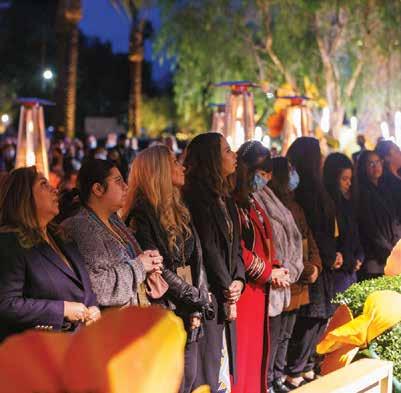
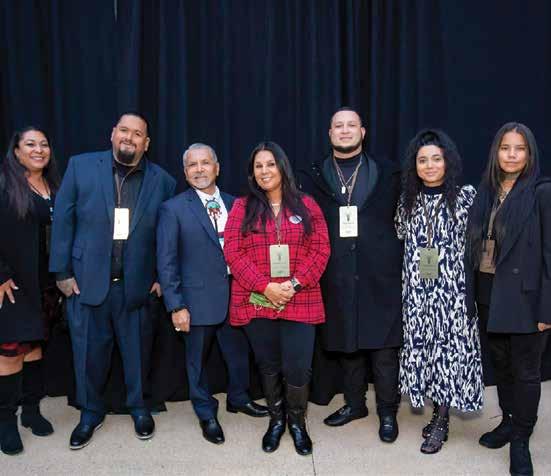
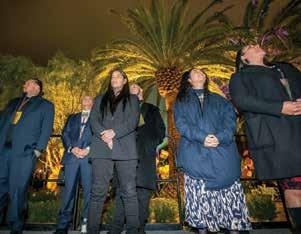



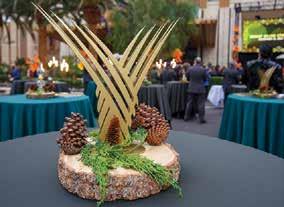
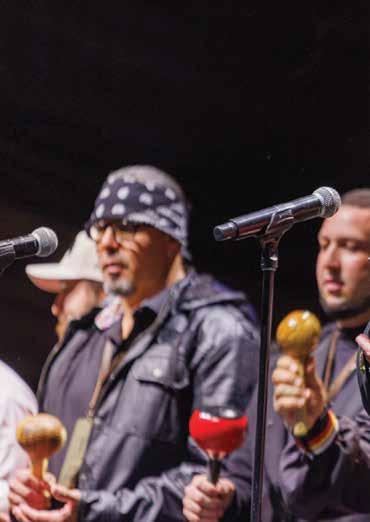
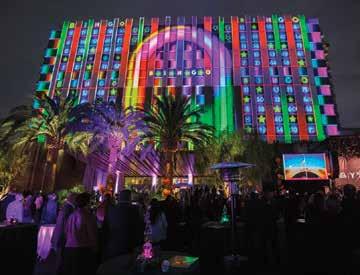


To cap off the excitement, and in lieu of fireworks, a 3D light show was projected onto the new 17-story hotel tower. The digital content told the story of both the Tribe and the casino, punctuating the history and accomplishments of a humble bingo hall, which debuted 35 years ago, and its transformation into a hospitality-industry leader.
“I loved the creative aspect of working with Bart Kresa Studio on the projection mapping. We’re in a fire zone, next to mountains, where using traditional fireworks is not an option. We had to come up with creative ways to get that wow factor,” Arceo said.

“Teaming up with Bart, who has done events of this magnitude in the past, was awesome. As was watching how we transformed the resort tower into a magical screen, which took us through a celebratory journey
“The highlight of the event for me was members of the Tribe sharing their history and perspective on what this grand opening and expansion meant to them as individuals and as a group of people.”
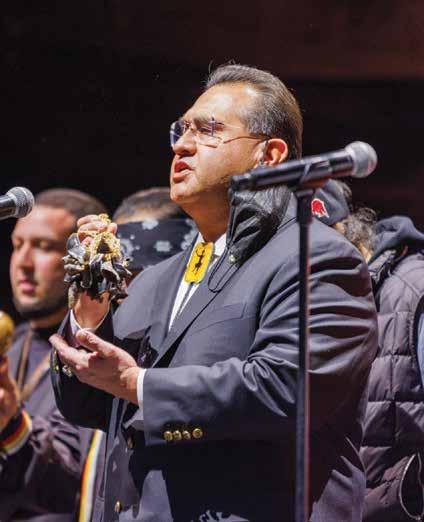

scored with a cool soundtrack. The entire experience lifted the energy of the crowd.”
Adding behind-the-scenes intel, Arceo said that while the whole production came off flawlessly, it was a nailbiter down to the end – with the biggest variable being the weather. “In the 10 days leading up to the event, we didn’t know if it was going to rain. We had three backup plans based on where we thought the weather was going to land,” he laughed. “That meant we had to plan more than one grand opening celebration and then make the final decision closer to the event. We really didn’t have clarity on which plan we were going to execute until about four days before the big event. That was very challenging, but the team handled it extremely well.”
GRAMMY Award-winning singer Miguel performed for the crowd and, as his setlist came to a close, a light shower began. “After the concert was over it began to rain, the timing could not have been more perfect. That was the ‘aha’ moment we all realized we overcame obstacles and could relax,” Arceo reflected. “We were able to get everything done without any major hiccups, literally minutes before it began to rain. It was perfect.”
Arceo noted none of this would have happened without the tireless effort of the team members from both San Manuel Band of Mission Indians and Yaamava’ Resort & Casino. “It’s this joint effort that sets the foundation for continued success in the future. It truly took a team of skilled people to pull off something of this magnitude. There were a lot of moving parts,” he said. “The entertainment team worked extremely hard under less-than-ideal conditions and the tribal experiential marketing team helped coordinate and design the layout and logistics. The two teams did a great job working together to create a wonderful, memorable event for everyone.”
Now that Yaamava’ has a few months under its belt, Arceo looks ahead to a bright future, one that includes lots of smiles and sunny days. “I’m looking forward to watching the millions of people come to our property to enjoy all the new amenities and services our team has been working hard to put together. I find a lot of reward in seeing happiness in others and watching people smile,” said the hospitality industry veteran. “I love asking ‘How was your stay?’ ‘How was your experience in one of our venues/ restaurants?’ I love to hear the excitement in our guests’ voices and the way their faces light up being a part of this new experience – and of course I love hearing the positive comments about our team,” he said, smiling.
Fans Fans For the For the
The celebrated Dodger Stadium debuts its new Centerfield Plaza, an all-encompassing destination filled with things to discover for fans – both young and old.
By Matt Jacob
A renowned architect and urban planner, Janet Marie Smith’s fingerprints can be found on multiple iconic Major League Baseball stadiums, from Camden Yards in Baltimore to Fenway Park in Boston. Currently the Executive Vice President of Planning and Development, Smith has overseen the expansion and improvement projects at historic Dodger Stadium since 2012. A few years ago, she was tasked designing its new Centerfield Plaza at historic Dodger Stadium. She talked with Hamiinat about what went into creating Dodger Stadium’s “new front door,” her favorite elements of the new plaza and what drew her to our national pastime.
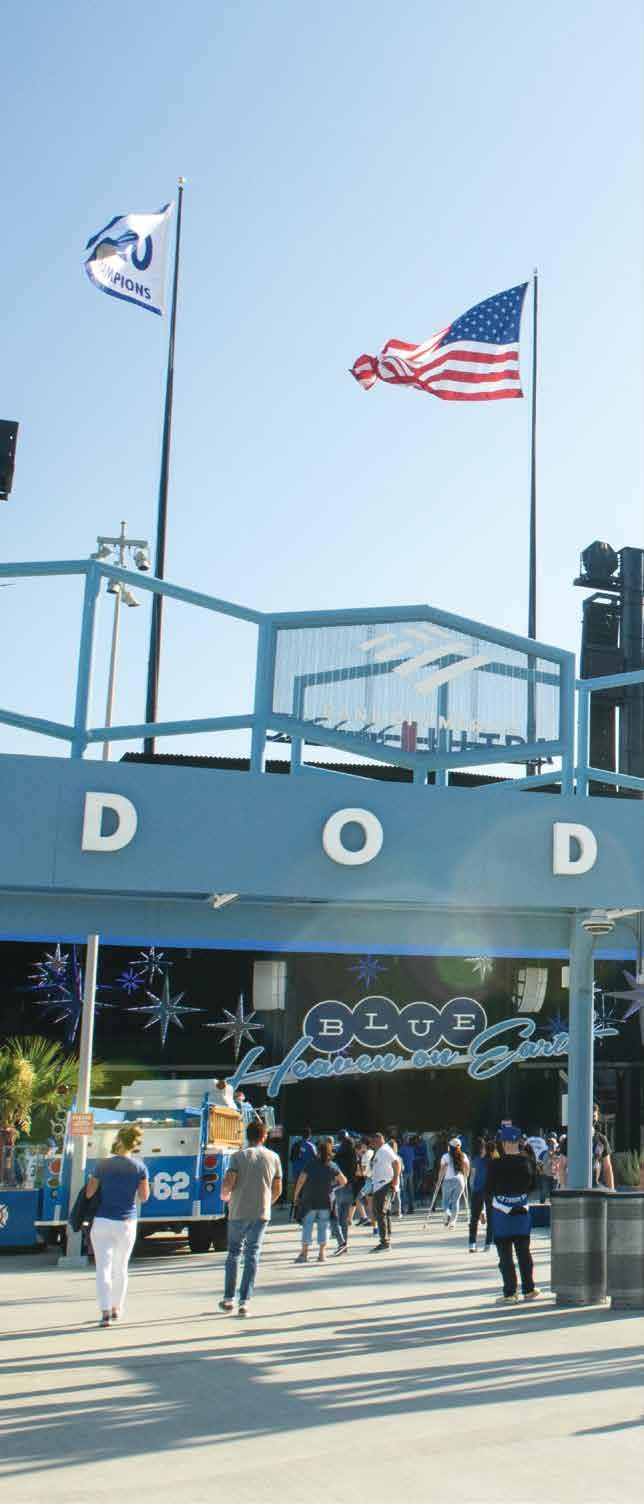
Photo
courtesy of Los Angeles Dodgers
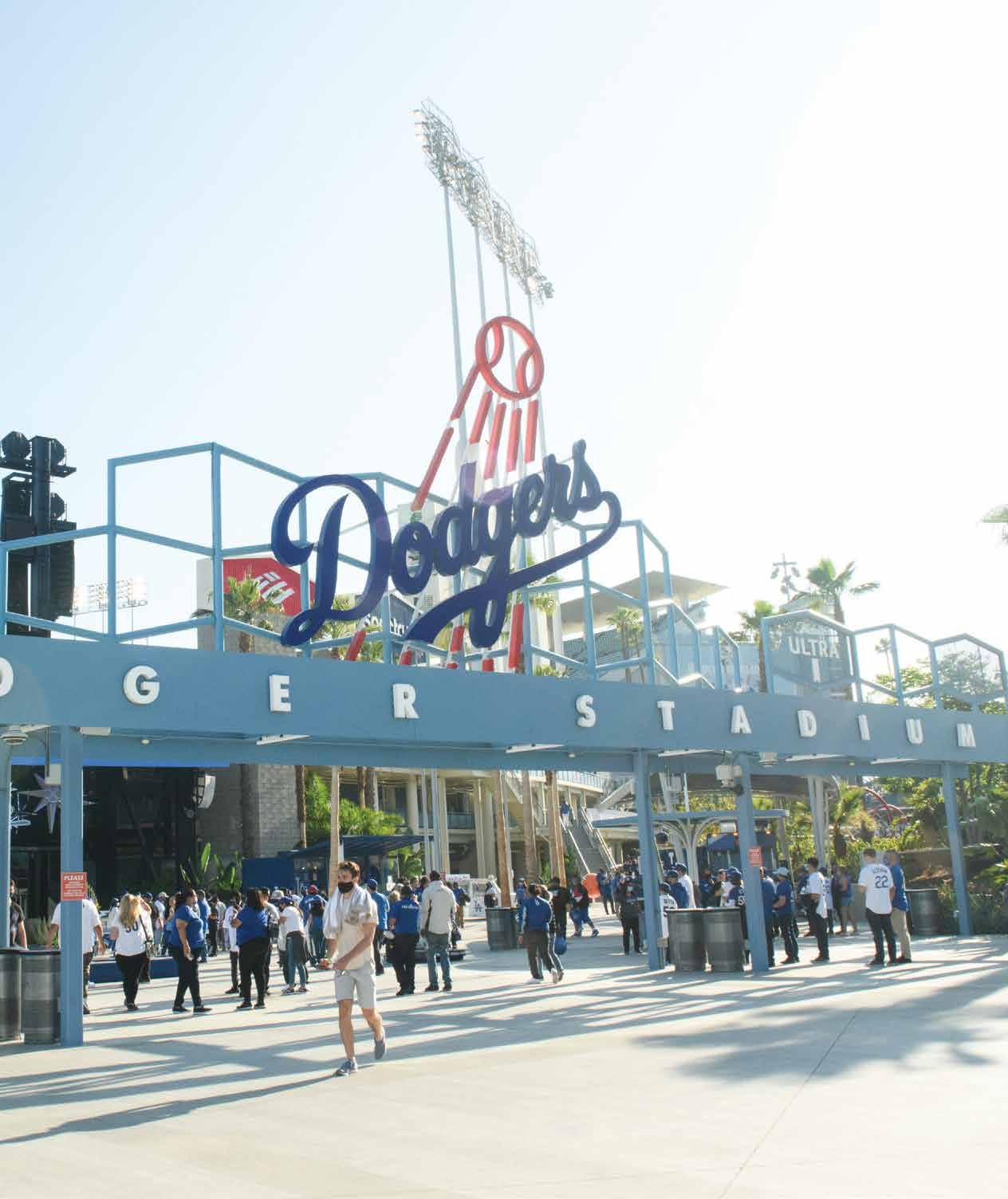
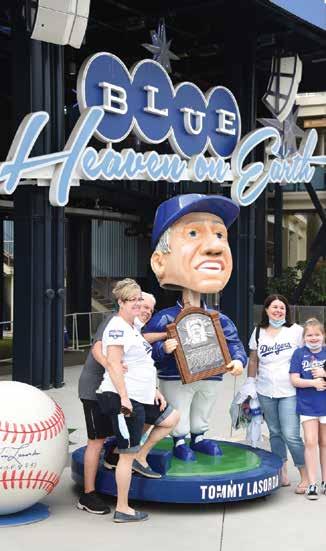
What prompted your initial interest in architecture?
My dad was an architect, so that was an influence. But I didn’t give it that much thought. I had to just check a box for a major when I got to Mississippi State, and that seemed to be as good as any.
I initially thought I’d major in engineering or art, but one seemed too science based, and the other didn’t have as much rigor I would’ve liked. So, I ended up studying architecture. And what I found I enjoyed most were my classes in urban planning – that notion of how cities grew and changed.
After graduating from Mississippi State, I moved to New York and got a fantastic job working on the redevelopment of Battery Park City, which is an extension of lower Manhattan. While there, I went back to school to get a degree in urban planning, and Baltimore was one of the case-study cities that we spent a lot of time discussing. I was impressed with how Baltimore reinvented itself when industry died and moved out from downtown. The city managed to reclaim its waterfront as a place for recreation.
Maybe 10 years after that, when I learned that the Orioles were building a new stadium in downtown Baltimore, I thought, “Wow – there goes Baltimore, adding something else that will bring millions of people into the middle of downtown.” So that’s a short version of the trajectory that got me into baseball and into the architecture that shapes not just the parks we play in, but the way those buildings relate to our cities and our hearts.

Camden Yards in Baltimore was a “throwback” ballpark and it received universal praise from the moment it opened in 1992. It also served as a blueprint for countless new baseball stadiums that followed. As you worked on Camden, did you know it was going to be a home run?
I always felt confident that it was going to be a success and be right for Baltimore. And we really had a secret weapon under our own roof in Hall of Fame player Frank Robinson, who was the Orioles’ manager at the time. Frank had played in these older parks, so he was a tremendous resource for us. Having someone like Frank there to champion it gave us a lot of confidence that this wasn’t just a Disney-esque, fabricated approach to building a baseball stadium. Rather, it was rooted in history, something that was very real. Now, what I couldn’t have predicted was that it would start this wave of other baseball parks being constructed in cities like San Francisco, San Diego, Denver, Pittsburgh, Cincinnati, Philadelphia — you could go on and on. There was an entire generation of ballparks that opened within 10 years or so after
Camden Yards that really looked to mimic not the architecture but the attitude, and that desire to move into the heart of a city.
Whether it’s designing a new ballpark from scratch like Camden or renovating existing structures like Fenway Park and Dodger Stadium, what informs your design aesthetic?
This probably sounds kind of weird, but you really have to “listen” to the building, because the building will tell you what to do. With Fenway and Dodger Stadium, I mostly just tried to have my ear to the ground and ask, “What does that building want to grow up to be?” That is, how do you take something that distinctive and build on it?
So, with Dodger Stadium, it was, “Look, this building is so unique compared with any other in baseball, with these crazy 1960s colors and the folded roof of the pavilions, and the fact it’s carved into the hillside and offers this beautiful view of the downtown skyline in one direction, and Elysian Park and the San Gabriel Mountains in the other. So how do you build on that?”

I love that Stan Kasten, our president and CEO, charged me with staying faithful to what the building was. And you need the entire design and construction team to think that way. Because every ballpark is special and unique, which is one thing I just love about baseball.
I don’t care how long you’ve worked in this field, when you’re renovating a building like this, you are not the expert – you just aren’t. The fan is the expert. You’re not going to come in and tell them what you think. They’re going to tell you what they think. I do try very hard to not get too far away from the thing that made me fall in love with baseball in the first place. Because if you forget to be a fan, you won’t be able to feel that pulse.
Describe the early process of designing the new Centerfield Plaza at Dodger Stadium. Were you given a lot of autonomy, or was there a specific organizational vision?
Stan really championed this project. After the eight years of renovations and additions we had been doing at Dodger Stadium – with the goal being to give
our fans more to do during games – he felt that the Centerfield Plaza would be the crowning jewel and the stadium’s new front door.
If Stan said it once, he said it a thousand times: There’s going to be a new front door to Dodger Stadium. And he was absolutely right. We had done these engineering studies on how long it took our fans from the time they parked their cars at Dodger Stadium until the time they passed through their gate, and it was just painful how long it took to navigate the parking lot.
So first, we wanted to make it easier for fans to enter the stadium through the gate that was closest to them, so we put in these stairs, elevators, escalators and bridges to help them navigate their way through the building. But we also really wanted them to take in this new front door at the Centerfield Plaza, which we designed as a place to enjoy pregame, postgame and during the game.
What was the biggest challenge you encountered as you went about tackling the centerfield renovation?
Stan counseled us early on about synthesizing input from a lot of places…making certain we had, for instance, not just places like the Gold Glove bar but also kids' play areas. We wanted this to be a family event; we wanted everyone to feel like there’s something for them. So, balancing all of those things, while giving the area a compelling look, was very much part of our agenda and was a challenge.
The other thing, of course, was COVID. The Centerfield Plaza was on the drawing board for several years, but we took a pause and worked on other renovations before coming back to it. When we finally did, we knew we’d have to get it done in a single offseason. We’d have to start in October and finish by the end of March the following year.
Well, there we were the last week of March 2020, racing to get everything done, and then COVID hits. So, the entire thing sort of sputtered instead of soared to the finish line. But while those challenges were daunting, the validation of seeing how fans used the new space was worth all the sweat, agony and delays.
Speaking of fans, what kind of feedback have you and the organization received since the plaza opened? Are there certain elements that are particularly appealing? Well, it didn’t hurt that the plaza opened right after we won the 2020 World Series, so our displays got to be about the World Series. We built this oversize World Series trophy that’s like six feet high and put it in centerfield, and people lined up to get their pictures taken with it. That was neat.
Really, it was just fun to see the joy our fans had experiencing the entire area. I’m sure some of it had to do with the fact we were coming out of COVID. We were all looking to be together again in a place that felt familiar and had so many memories for so many people. And to be able to celebrate a World Series championship in this new space was just amazing.

Photos courtesy of Los Angeles Dodgers
Were there any “Wait, what about this?!?” components added late in the game?
Oh, I’m sure there were. You’re always trying to make a project better every step along the way. But some of those adjustments weren’t architectural. Like when legendary Dodgers manager Tommy Lasorda passed away in January 2021, we asked his family if we could take the things that were in his Dodger Stadium office and put them in the lockers that were on display in centerfield. And they said yes. So, it was touching for our fans to be able to celebrate Tommy by putting those mementos there. What I loved was it was all stuff that came straight out of Tommy’s office. It wasn’t like we went through Tommy’s possessions and picked one from Column A, one from Column B. These were actually Tommy’s things that he lived with every day.
And, of course, winning the World Series in 2020 and being able to put the memorabilia –the new World Series ring, the trophy, etc. – in centerfield was an amazing late addition.
It’s probably like asking a parent to choose their favorite child, but what’s your favorite part of the centerfield renovation?
I know! I often say that you can’t pick favorites. But in this case, I do have a favorite spot: coming in that new front door and being greeted by that beautiful Jackie Robinson sculpture that Branly Cadet did in 2017 to honor the 70th anniversary of Jackie breaking the color barrier is just amazing. And to have that statue against the backdrop of the sign that reads “Blue Heaven on Earth” – which was what Tommy Lasorda called Dodger Stadium – was particularly poignant after Tommy passed.
What (if anything) is next on the Dodger Stadium redesign front?
We had announced we were going to put a sculpture of former Dodger and Hall of Fame pitcher Sandy Koufax at the new front door alongside Jackie Robinson’s. Because of COVID, we didn’t get to do that in 2020. So, when the All-Star game that was supposed to be played at Dodger Stadium in 2020 got moved to 2022, this also got moved to 2022. The most exciting thing we have coming is the chance to finally unveil the Sandy Koufax sculpture out there on the plaza.
courtesy of Los Angeles Dodgers

Photo

A Home Run A Home Run
BY MARK LANGILL
Dodger Stadium might just be as famous as the team itself. With the opening of the new Centerfield Plaza, a dream destination for fans, Hamiinat checks in with one man who has seen it all. Hear what he has to say about his time with the team and the new fan experience at the storied Dodger Stadium.
During his first season as a Dodger broadcaster in 1959, Jaime Jarrin often made a detour from his normal commuter route to the Los Angeles Coliseum, the team’s temporary home after moving from Brooklyn in 1958. Jarrin visited the construction site at nearby Chavez Ravine where the first privately financed Major League ballpark since 1923 slowly evolved into a grand showplace.
The 60th anniversary of Dodger Stadium in 2022 coincides with Jarrin’s own celebration as he will retire at the end of the season. Jarrin reflects on his Hall of Fame career with a stadium backdrop of expanded exhibits and activities for fans, including this summer’s MLB All-Star Game.
“It’s been a privilege for me to see that ballpark since the first day,” Jarrin said. “There were so many expectations when Dodger Stadium opened in 1962. A new ballpark was the reason the Dodgers moved to Southern California in the first place. When it was finally ready, I felt like a kid under a Christmas tree coming to Opening Day.”
Jarrin recalls how the original foul territory at Dodger Stadium – the area now used for the Baseline Box and Dugout Club sections in front of the Field Level – gave pitchers like Hall of Famers Sandy Koufax and Don Drysdale the advantage on popups that didn’t drift into the grandstands. The Dodgers of the 1960s designed their roster based on their home field. Unable to rely on home runs with symmetrical outfield dimensions and heavy night air, manager Walter Alston’s pennant-contending teams utilized strong pitching and the speed of All-Star shortstop and stolen-base artist Maury Wills, who swiped a record 104 bases during his National League MVP season in 1962.
The initial Dodger Stadium experience focused on the field action, along with the traditional ballpark staples: organ music, a baseball menu of hot dogs and peanuts, ice cream, popcorn and sodas. Sellouts became commonplace as the Dodgers won two World Series titles and another pennant during a four-year span between 1963 and 1966. The Dodgers in 1978 became the first MLB team to break the three million mark in home attendance.
The “game experience” gradually shifted after Guggenheim purchased the Dodgers in 2012. The
areas outside the stadium hallways on the Reserved Level were cultivated into children’s play areas, along with added space for restaurants and retail. Historical displays included oversized baseballs commemorating Cy Young Award winners, and the Retired Numbers Plaza on the Top Deck, which features a picturesque view of downtown Los Angeles. The pavilion areas were reimagined after the 2019 season and give fans a chance to “circle” the stadium grounds when exploring the ballpark.
The Centerfield Plaza at Dodger Stadium is now the “front door” to the third-oldest venue in the Majors behind Boston’s Fenway Park (1912) and Chicago’s Wrigley Field (1914). Fans are encouraged to explore the ballpark’s exhibitions and other activities for children.
“I always wondered why we didn’t have a main entrance to Dodger Stadium,” Jarrin said. “If you look at the pictures of old ballparks like Ebbets Field in Brooklyn or Crosley Field in Cincinnati, those buildings had a front entrance. (Dodger President) Walter O’Malley wanted fans to have access to the interior of the ballpark based on where you parked. He also designed the stadium with architect Emil Praeger so there wouldn’t be any columns or pillars, allowing fans to watch the game from anywhere in the park without a visual obstruction.”
This summer, a statue of Koufax is scheduled to be unveiled in the Centerfield Plaza. It will join the other statue by sculptor Branley Cadet, whose artwork of Jackie Robinson sliding into home plate was dedicated in 2017. It will mark the 50th anniversary of Koufax’s induction into the Baseball Hall of Fame. Koufax made his Major League debut on June 24, 1955 at Ebbets Field. On the same day of Koufax’s first game, Jarrin emigrated from his native Ecuador and arrived in Southern California to embark on a broadcasting career with Los Angeles station KWKW.
“I think about how fortunate I have been, coming to work at Dodger Stadium for such a long time,” Jarrin said. “It has always been so clean and beautiful, and I get to walk into the best seat in the ballpark in the press box behind home plate. When Walter O’Malley built the stadium, everything he did was done to please the fans. It’s still one of the best ballparks in the world. Nobody would believe it opened in 1962.”
RELATIONSHIP Nourishing A
San Manuel Band of Mission Indians helps to meet the Las Vegas community’s most pressing need.
By Steve Bornfeld
They forged a partnership of the heart that put food into mouths.
And it yielded an experience that feeds the soul.
“There was a panorama of smiles on people’s faces everywhere you looked,” said Brian W. Burton, President and CEO of Three Square Food Bank, recalling the scene the day upwards of 40 team members from San Manuel showed up as volunteers last fall.
That, by the way, was in addition to the whopping $100,000 donation the Tribe had made to Three Square, Southern Nevada’s only food bank and largest hunger-relief organization. The gift enabled 300,000 meals to be delivered to needy Southern Nevadans, almost one-sixth of the region’s residents, all who suffer from food insecurity.
Yet it was the volunteer scene, as San Manuel team members streamed into a “Backpack for Kids” program, that warmed Burton to his core. “The
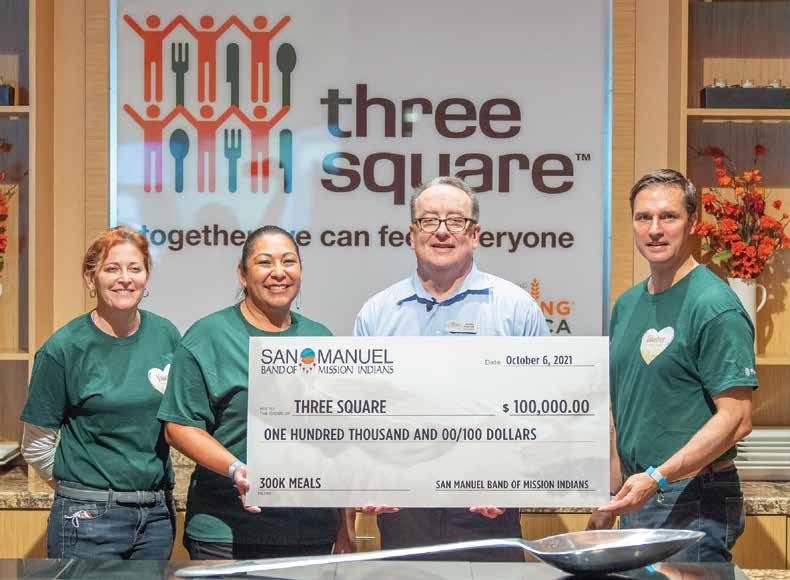
excitement that was reflected that day was in their countenance, in their joy,” he said.
“I like to say that God smiles when you can’t tell who’s receiving and who’s giving. It was in the laughter you could hear on the line as they picked up the cereals, the pre-packaged fruit and the granola bars, picturing a kid opening that and being happy that he had something to eat. It’s part of that magic that happens when you come into that space at Three Square.”
Equally magical is the connection it created between the two organizations. As Burton noted, “We immediately bonded with San Manuel leadership and began to talk about mutual goals and how the community could really benefit.”
And as Ken Ramirez, then Chairman of the San Manuel Band of Mission Indians, said when
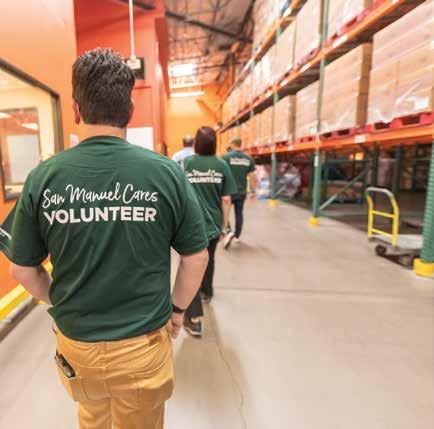
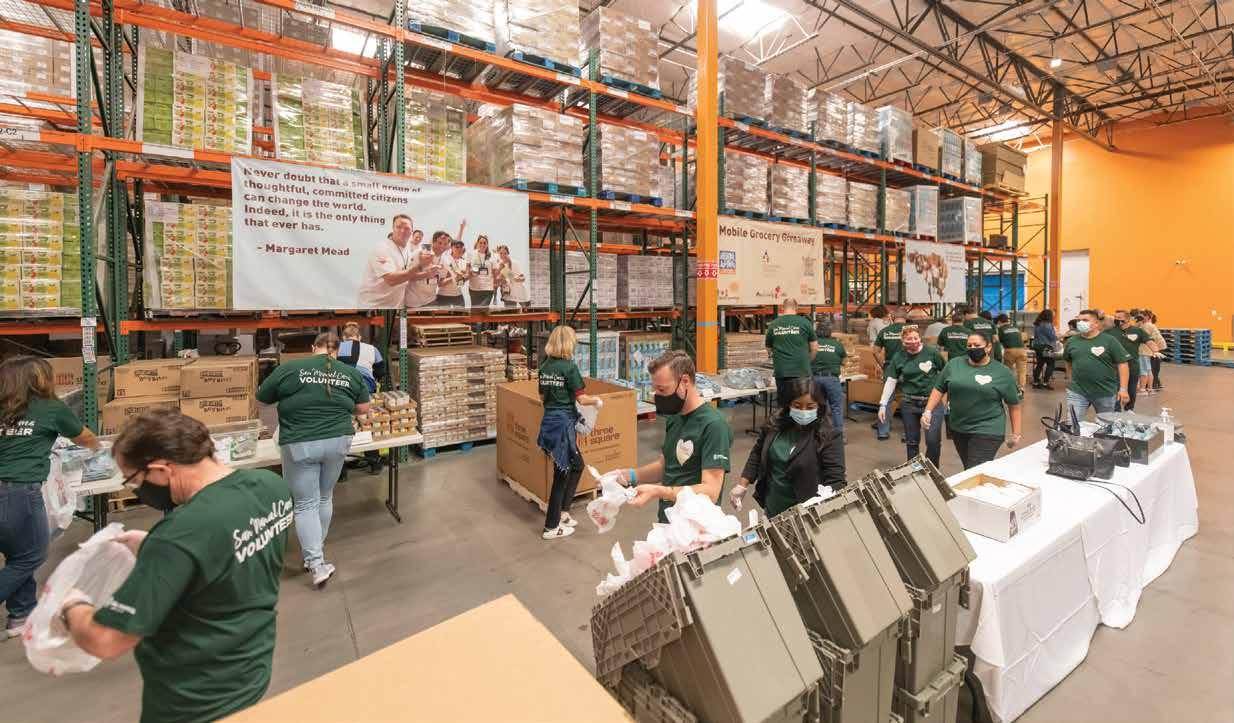
the $100,000 gift was bestowed, “It’s important to our Tribe that we work to impact and change lives of those who are in need and facing economic challenges.” The donation was given under the Tribe’s Empowering Lives pillar, one of four pillars that guide the Tribe’s philanthropic efforts.
“Our Tribe is proud of the community involvement and support we have provided in Southern California and across Indian country.”
that really underlined that this was more than an organizational partnership.
“It was so wonderful because we had been kind of shut down during the pandemic and had a loss of volunteer labor; we had to pay people to do a lot of these activities,” Burton explained. “They were just a timely godsend when they stepped in with all those volunteers.”
Philanthropy comes naturally and generously
“For the Tribe to come in at that level sets it apart in terms of how relevant it is and the change that can happen when you have resources like that coming into a community like ours, where we have so many needs and disparities.”
This budding friendship has included productive conversations on other ways the partnerships can bear fruit in Las Vegas. “They clearly indicated that we are congruent with their charitable goals and
Our Tribe is proud of the community involvement and support we have provided in Southern California and across Indian country – and we’re humbled and honored to continue this tradition of giving here in Las Vegas.
It was a wham-bang start to this friendship, one that equally humbled Burton, who was surprised when the bountiful gesture was made as the COVID-19 pandemic was impacting the world. “It was so reassuring to us that there was a new friend in town with that desire to help and the capacity and resources to do significant things for the community.”
As beautiful as the donation was, and Burton has declared it nothing short of life-changing, it was the helping hands of the San Manuel team members
to the Southern California San Manuel Band of Mission Indians, which has given more than $9.3 million to educational institutions and charities in Las Vegas since January 2020.
And it quickly made a sizable footprint in Las Vegas with its philanthropic values. “Ours is a community of two million people. But we have grown so rapidly over the last 50 years that our infrastructure and a lot of our nonprofit sector and our social safety net, our foundational peers, had to play catchup with that growth,” Burton pointed out.
values as an organization,” Burton said. “And since we all had a great experience that day, I know we can look forward to more activities in the future.”
San Manuel Gaming and Hospitality Authority (SMGHA) was created to independently carry out the investment in and ownership and management of gaming and hospitality businesses outside of the San Manuel Reservation. Looking forward, SMGHA is excited to continue the philanthropic relationship in Las Vegas begun by San Manuel Band of Mission Indians.
Here from the
START
From food runner to the executive level, Tom Hedrick shares the upward trajectory of his career and how he feels about working for the San Manuel Band of Mission Indians.
By Lissa Townsend Rodgers
It’s
been 36 years since Tommy Hedrick’s father told him to get a job. “He’d heard the Tribe was opening a bingo hall, so I went down and applied,” Hedrick reminisced.
The young Hedrick was going into high school when he was hired as a food runner, bringing cheeseburgers and chicken strips to hungry players. Even though he’s now Tom Hedrick, Vice President of Tribal Community Services, those days aren’t totally behind him.
“Every now and then I’ll walk through the casino, and I’ll hear someone say, ‘Hey Tommy!’ I think Who the heck is that? And it’s one of the old bingo players!”
What was your career path from food runner to the executive suite?
I went from supervisor up to the second man in slots. From there, I learned how to manage the tables. Then back to slots where we saw a lot of upheaval during the Prop A and Prop 5 battles. Later I was promoted to Director of the Manager on Duty department. I’ve moved up every few years because there were always new opportunities. I’ve been in on the ground level of a lot of things, so I take great pride in getting to build it.
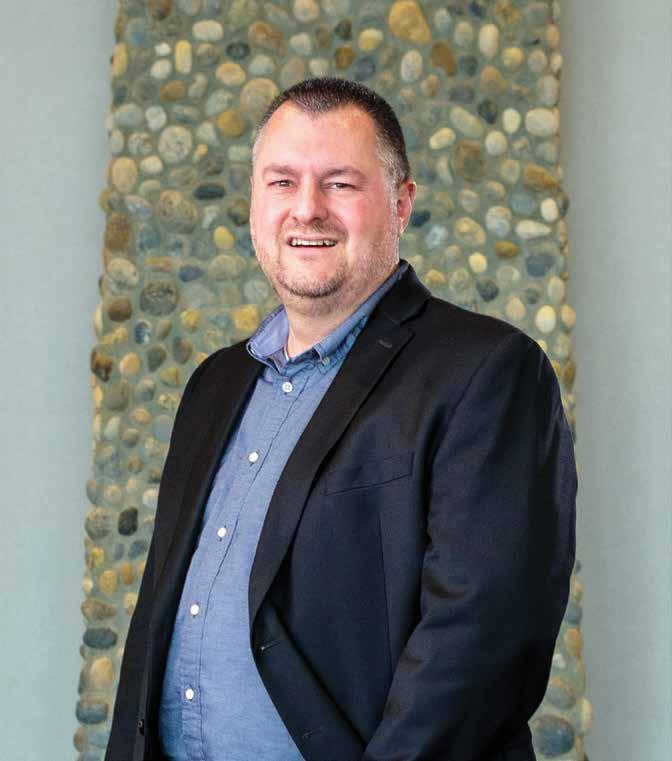
What does your job as Vice President, Tribal Community Services entail?
What are some of the projects you oversee?
There are three verticals: security, building operation and service. In the service vertical, tribal citizens come to us with an issue, concern or service request and we take care of it. For instance, one of the big projects we’re working on now is getting generators to tribal elders so when we lose power out here, they still have it. We’re also the contact point with the tribal citizens and the construction crews so everyone knows what’s going on. We’re also working on several initiatives, such as events – the last one was the fall festival, which was a collaboration of tribal and casino departments – and projects with the youth through the education center.
What has the transition from working in the casino to working with the tribal government been like?
Even though I grew up with many of the tribal citizens, I hadn’t seen a lot of them for more than two decades. But they were so welcoming; it was like I was never gone. People I grew up with, people who worked in the bingo hall, tribal citizens – they had kids who are now having kids.
What is your favorite part about working at an executive level?
For 35 years my job was to make sure the guest was happy and stayed longer. Then to come up here – where I see how the money we helped them make is used for philanthropy, for the advancement of the Tribe, for future generations – it’s very rewarding. In the role I have now, I get to see it come full circle: my job was focused on making the money, now I come up here and see how that money benefits the whole community.
Are there any particularly memorable events or a special time in your career with San Manuel?
It’s been the best of times and the worst of times. The worst being when we closed our doors in 2020 in response to the pandemic. But the generosity of the Tribe toward the workforce was inspiring: they paid us even though the doors were closed and helped us support our families. They didn’t have to. In fact, all the other casinos furloughed people. But this Tribe, for the 35 years I’ve been here, has absolutely treated us like family. The best of times was when we all worked together to open those doors again. We were happy to give back to the Tribe that had so generously given to us.
(muh-chish-chk)
FAVORITES
Müčisck: your favorite things. A word to acknowledge all those things in life you find yourself drawn toward.
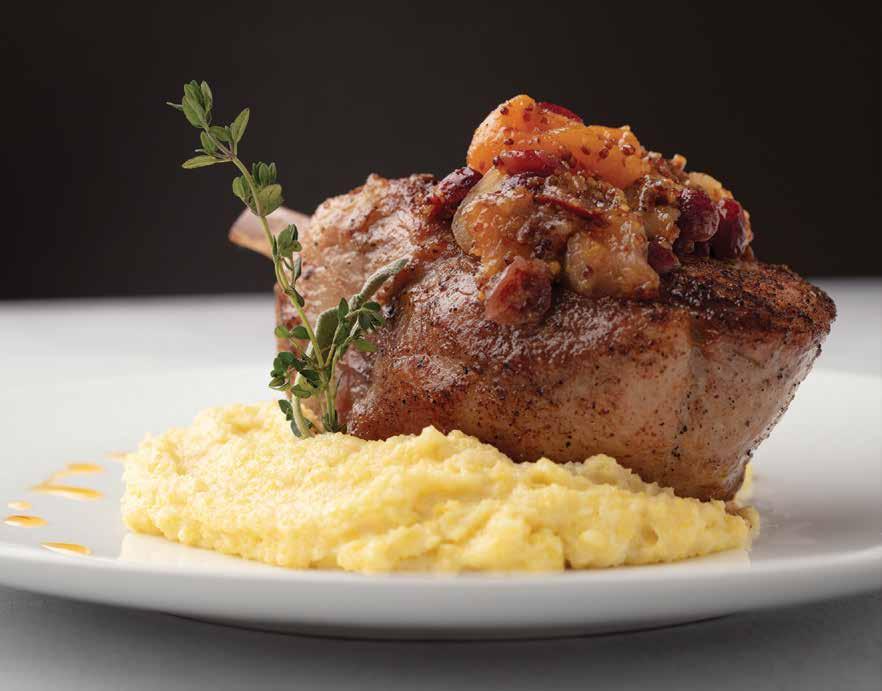
This section explores all the things that brought you to Yaamava’ Resort & Casino at San Manuel in the first place: the fine dining, hand-crafted cocktails, boutique shops and stunning surroundings – punctuated by the excitement found on the casino floor. We also explore the luxurious spa and new state-of-the-art entertainment venue, set to stage headliners and smaller acts in a space that tops all others in the region.
collected COOL
Each issue we gather a few fun things that turn heads. This time we’ve set our sights on everything you need to look and feel good before, during and after a day in the sun, all available at Yaamava’ Resort & Casino at San Manuel.
PHOTOGRAPHY BY JAIME BIONDO
Rainbow Clutch, Sammie Hat and Juno Bag Fuchsia by Pia Rossini available at 1891 Boutique at Yaamava’ Resort & Casino or piarossini.com.
Tune Tag Along Bluetooth Speaker and Glow Up Compact Power Bank by Tech Candy available at Cache & Carry at Yaamava’ Resort & Casino or shoptechcandy.com.
Classic Organic Sunscreen Spray, SPF 50 in Guava Mango Scent Sunscreen Spray and Classic Tinted LipLux Lip Balm by Coola available at Helix Pool at Yaamava’ Resort & Casino.

The Essentials of Summer
Sunscreen to safely soak up the rays, check. Bluetooth speaker to listen to your chill playlist, check. Mirror to make sure it’s all working – even after a dip in the pool, check. And colorful, woven clutches and totes to carry it all.

Eyes on the Prize
Squinting against the glare isn’t a great look. But these shades are. Choose from vintage tortoiseshell, sleek gunmetal gray wireframes or uber-trendy shields to protect your eyes – and add the finishing touch to your poolside vibe.
Men’s Active Metal Frame Brown
Gradient Lens Sunglasses by Ray-Ban, Men’s Radar EV Path Black Sport
Sunglasses, Men’s Tortoise Brown
Gradient Sunglasses by Ray-Ban available at HIS Boutique at Yaamava’ Resort & Casino.
Smart Skincare
There’s two parts to getting a beautiful glow: protection and repair. After a day in the sun, show your skin some TLC with gentle exfoliators and hydrating creams and oils.

Naturopathica Lavender & Honey Balancing Mist, BABOR Body Lotion, Naturopathica Body Lotion, Naturopathica Lemongrass Mimosa Body Scrub, BABOR Salt & Sugar Oil Scrub, Naturopathica Lavender Blossom Bath & Body Oil, BABOR Vitamin Ace Body Cream available at Serrano Spa at Yaamava’ Resort & Casino.
LOW KEY + Lu urious
How The Pines Modern Steakhouse at Yaamava’ Resort & Casino at San Manuel serves up exquisite yet approachable ambiance and food.
Christopher Dennis had an atypical, if not far-fetched, path to his position as Chef de Cuisine at The Pines Modern Steakhouse. He didn’t attend a prestigious culinary school nor was he born into a family of chefs. In fact, his first job handling food was at a Subway.
As a teenager, he went from working in a bowling alley to his first restaurant job at Pelican Hill Resort in Orange County, CA. And when the charismatic and approachable Dennis arrived at Yaamava’, he worked his way up – from team dining to food court, to helming the most prestigious restaurant at the resort: The Pines.
By Danny Palumbo | Photography by Jaime Biondo
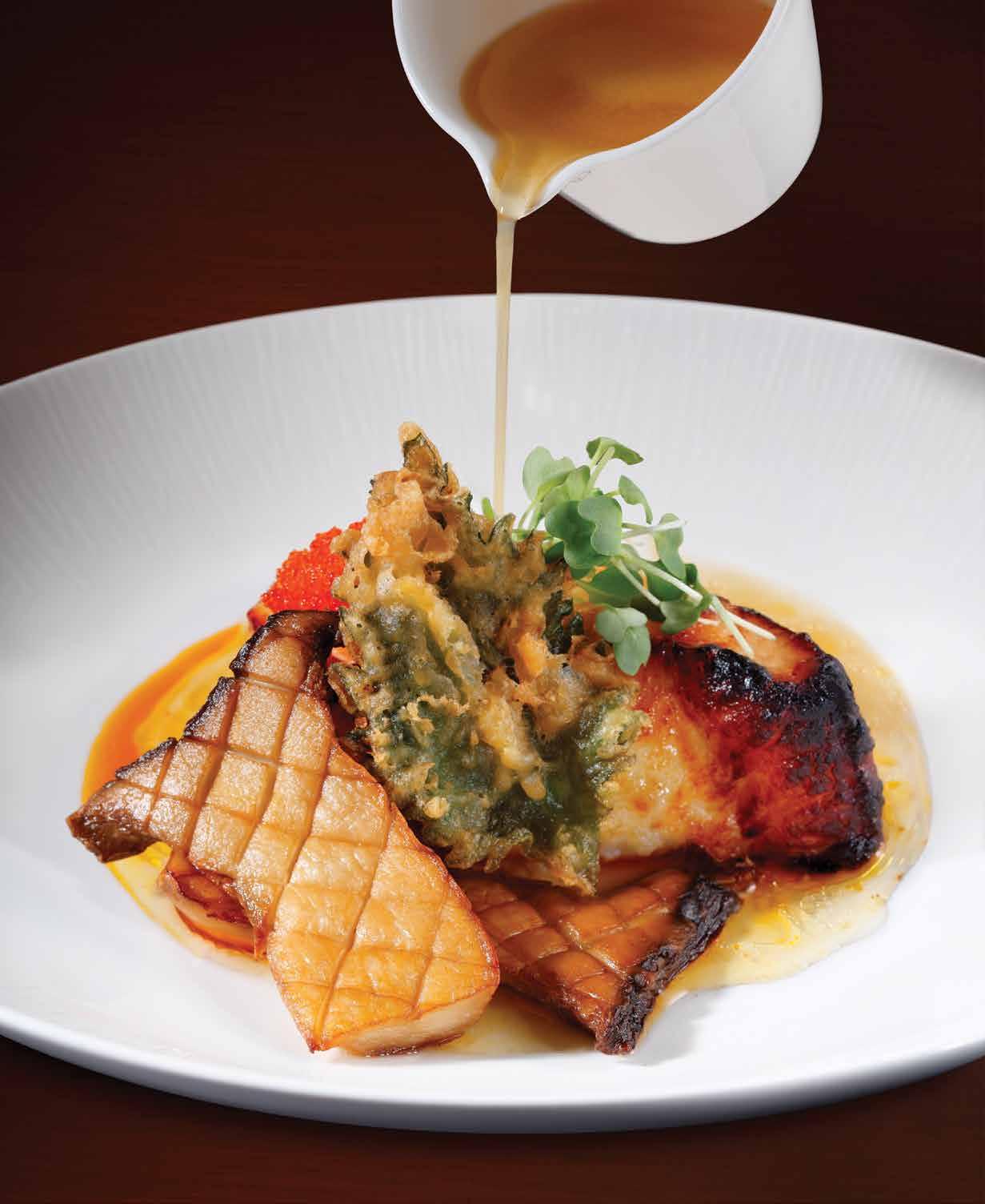
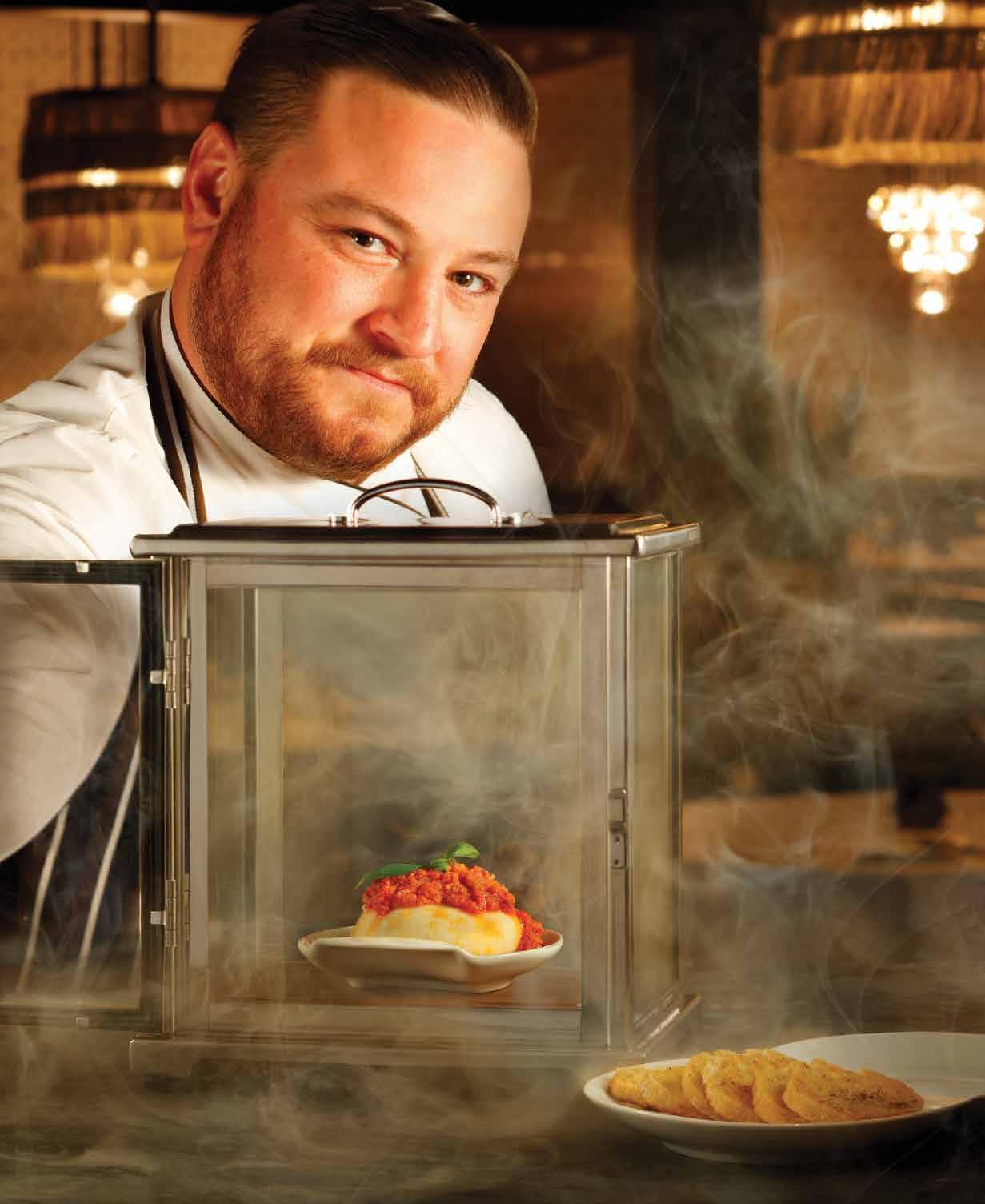
The steakhouse recently reopened in its new location, a gorgeous space filled with modern angles, gilded touches and floor-to-ceiling glass doors opening to the casino floor. While some steakhouses come across as stuffy or overly posh, the new Pines is cool and relaxed, the type of place that encourages you, from moment one, to have fun.
Take a seat in a big Hollywood-style booth and enjoy the intimate atmosphere. The space strikes a balance between dimly lit and vibrant, almost like a metropolitan street at night. Each room has its own electric personality; you might even find yourself wanting to roam the restaurant to see what’s tucked away in each corner. This is the spot you want to post up for the night – laughing, drinking and indulging in the top-of-the-line fare.
That’s because The Pines is all about simple and exciting luxury. Fine dining doesn’t quite begin to describe the experience. It’s more
all, The Pines is like Disneyland for steakhouse lovers. Everything, from the menu to the décor to the food, is meant to make you giddy with joy. Modern steakhouse food is en vogue, and The Pines crew offers an enticing twist to the continental cooking of the ‘80s. Each dish is iconic and recognizable but enhanced to transform the food into a newfound decadence that feels playful, and more importantly, natural. Take the Baby Iceberg Wedge, here made with Point Reyes blue cheese, shaved red onion, candied pecan, crispy bacon and house-made smoked chili ranch, which is loaded with aromatics, tang and sweet heat.
Chef Dennis confides that he loves ranch, but not the bottled stuff. He believes that a good ranch should be speckled with herbs and deliver a unique bite. He also loves ranch because it conveys the message that the food at The Pines isn’t too fancy. Food should blow you away, but still be approachable. And there’s nothing more
While some steakhouses come off as stuffy or overly posh, the new Pines is cool and relaxed, the type of place that encourages you, from moment one, to have fun.
complex than your average, run-of-the-mill “fancy” restaurant. The Pines is refined, but it doesn’t feel forced. The food is gorgeous, but it doesn’t take itself too seriously.
Navigate the menu and you’ll encounter something captivating at every turn. Some of the delights include Millionaire’s Mac & Cheese, an opulent dish chock full of indulgent ingredients such as black truffle, prosciutto, parmigiana cream, poached egg and, wait for it, gold leaf. Then, there’s the fanciful, tableside presentation of the Smoked Burrata, topped with Sicilian Trapanese and served with micro basil and oil-brushed crostini. The burrata is nestled in a smoke-filled box, which billows from the case like a chimney, kissing the cheese with a bit of charcoal flavor on its way out. Finally, you’ll find a colorful assortment of ice-cream sandwich macarons presented on a tiered platter, their taste reminiscent of childhood favorites: caramel apples and those beloved sugary cereals. All in
approachable than a humble ranch dressing.
You’ll also discover classics like the Roasted Veal Chop, which doesn’t explicitly call itself a veal saltimbocca, but is nonetheless rich with sage crema, prosciutto and wild mushroom. This classic Italian dish is reimagined as a more decadent, continental iteration and is a prime example of how good chefs elevate food without making it unrecognizable.
The Miso Glazed Chilean Sea Bass is another dish where Dennis really gets to show off his prowess. The well-orchestrated plate treats the taste buds to a bounty of flavors and textures.
The dashi juice is jam-packed with savory flavor and the buttery, flaky sea bass comes topped with king oyster mushrooms, a tempura-fried shiso leaf, peppery wasabi microgreens and tobiko (a smokier, saltier fish roe), achieving an impressive complexity of flavor.
The main reason to visit The Pines though is the steak. It’s one of only 55 restaurants in

Well Paired
It’s one thing to understand the subtle nuances of fine whiskey, bourbon and cognac. It’s another to expertly match those spirits with high-end cuisine. But now food-and-drink pairings are as easy as asking a team member at The Pines.
Servers and bartenders are ready to help guests select a pour from Collection 86 – one of the most exclusive lists on the West Coast – to enjoy with their favorite proteins, preparations or sauces. Named for the year San Manuel Casino opened, Collection 86 boasts nearly 300 bottles of the finest spirits in existence: rare Scotches and cognacs, worldclass bourbons, vodkas, tequilas and whiskeys as well as fine wines from throughout the world.
While the menu does include some of the most expensive pours around – the Macallan 52 Year whisky goes for $3,100 for a 1-ounce taste – the emphasis is not on price, but on exclusivity.
“What really defines the list is the rarity,” said Ryan Sharpe, Director of Beverage Operations at Yaamava’. “We have some items that aren’t extremely expensive… but our resort is the only place guests can try them.”

the U.S. that serves Kobe-certified beef, so they’re primed to give you the best. The Wagyu steak is cooked tableside with garlic, cipollini onions, green onions and thinly sliced scored king oyster mushrooms. Savoring a forkful of earthy, buttery king oyster mushrooms with a slice of fatty Wagyu is a culinary treat to cherish.
The intensely flavorful 45-day, dry-aged Snake River Farms New York Strip is up next. The cut is tender and immaculate, red through and through with a thin crisp crust. Chef Dennis serves his steak with two sauces: an herbaceous chimichurri made with Fresno chiles and a house-made sweet-spicy-tangy steak sauce starring his own Worcestershire.
The Worcestershire itself is noteworthy – made with anchovies, tamarind and a stampede of other ingredients – because it’s an example of the chef’s unparalleled work ethic. Everything, from the macarons and the pasta to the steak sauce, is homemade and it’s this commitment to excellence that has earned Chef Dennis his spot as captain at The Pines.
But the down-to-earth chef said, “I’m lucky that I’ve got such great cooks and chefs. I wouldn’t be where I am without them.”
The perfect combination of comfortable luxury and fine dining discovered at The Pines is the culmination of years of teamwork. “I used to do brunch side by side with a lot of these cooks back in the day. Now, we’re collaborating and working together. We’re challenging each other to be the best and I’m glad we can come together as a team,” said Chef Dennis.
Everyone at The Pines will agree that the chef has brought an incredible everyman quality to this celebrated dining establishment. Even the back-of-house environment is positive and relaxed, thanks in part to the chef’s nurturing attitude and low-key gritty determination. It’s his humble beginnings, passion for teamwork and eye for delicious, practical invention that make the new Pines Steakhouse a continually special experience.
When asked if he ever thinks about his first job at a Subway, Chef Dennis smiled and said, “All the time.” It’s a distant memory, but one that easily measures how far a strong work ethic and commitment to excellence can take you.
You’ll find a colorful assortment of ice-cream sandwich macarons presented on a tiered platter, their taste reminiscent of childhood favorites: caramel apples and those beloved sugary cereals.

A Living Tableau
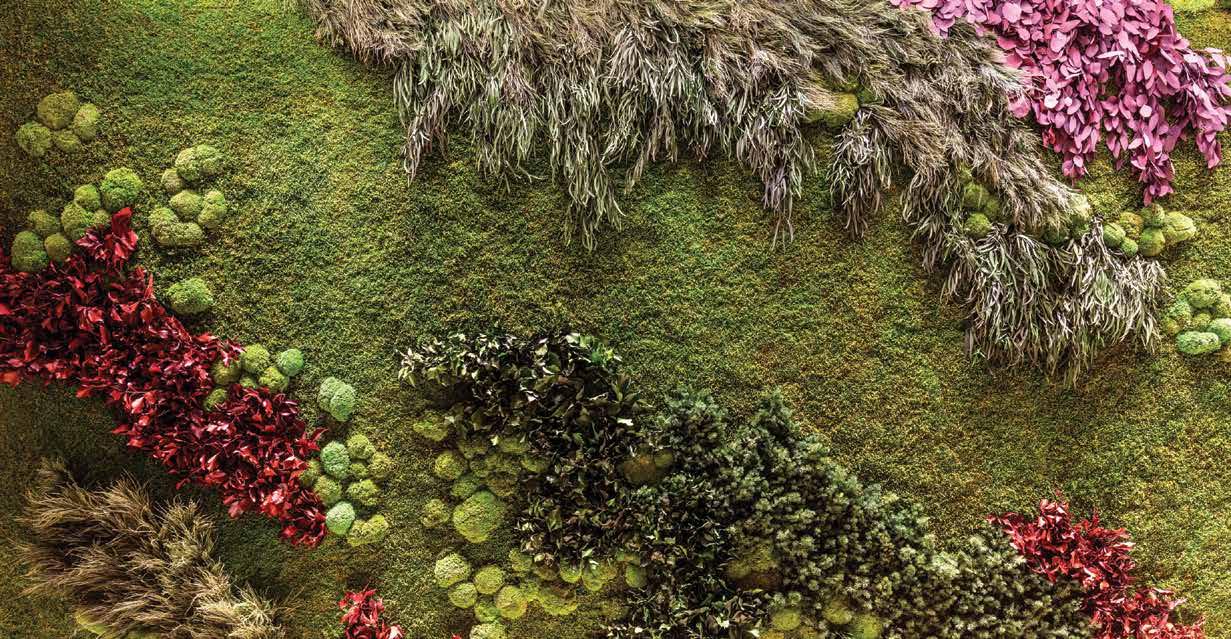
Ornamental horticulture uplifts spirits and brings natural beauty to the public spaces at Yaamava’ Resort & Casino at San Manuel.
By Patricia Kirk
Soon after Yaamava’s grand opening, guests who wandered the resort – from the lobby and rotunda, through the casino and high limit rooms and into the Overlook Bar – discovered more than 30 vibrant displays of flowers and greenery.
An abundance of red and gold from anthurium, flowering ginger and mums framed doorways and lined walkways and vibrant displays popped up in various corners throughout the property. The colors, signifying happiness and good fortune, were also found on lanterns and ornaments suspended from branches. An array of tigers – from realistic looking Siberian and Bengals to lacquer and cartoon-style big cats – appeared to lounge, stalk prey or roar in the midst of these arrangements, all heralding the Year of the Tiger.
“Our Lunar New Year show represented the ways different Asian cultures celebrate the holiday,” said Jerry Bowlen, Director of Horticulture at Yaamava’. He noted that the displays used elements, textures and colors found in China, Thailand, Vietnam, Japan and Korea. “We

wanted to wow our guests and introduce them to traditions from around the world,” Bowlen explained. Bowlen came to Yaamava’ from Bellagio Hotel & Casino in Las Vegas, where he had conceptualized and designed 40 shows over eight years at the world-renowned Conservatory. And while Bowlen loved working at the famous stop on The Strip, he was drawn to Yaamava’ for the opportunity to develop something unique, on a much larger canvas.
With five annual themed shows – varying in length from six to 12 weeks and all inspired by the seasons and cultural celebrations – Bowlen said, “Each display is designed to enhance the beauty of the area using colors and textures that coordinate with interiors and garden areas.”
Operating in a five- to six-month window in which each show has to be conceptualized, designed and built, it’s all hands on deck for the 84-member horticulture team, Yaamava’s seasonal décor team, marketing staff and vendors. And once a show is launched, the plants and floral arrangements receive daily care to maintain the highest standard.
The spring show, launched in March, is themed after spring in California.
With an Old Route 66 flair, the show focuses on plants and wildlife native to the Golden State, as well as iconic elements such as old cars and archways.
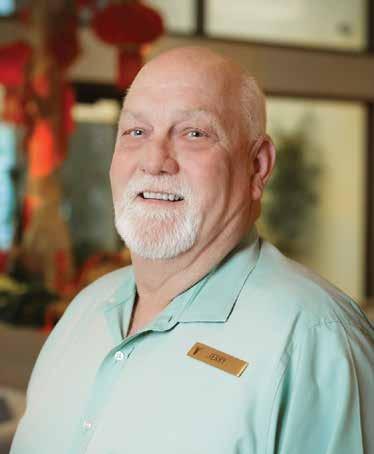
Bowlen noted that along with the rich colors and textures, the displays include animatronics of native animals: bears, coyotes, elk, birds and butterflies.
And Bowlen added, “We’ll be bringing more concepts to future shows, including water features, fog, holograms, sound and lighting.”
While most plants and materials used in displays are sourced from local growers and suppliers, some specialty and patented flowers chosen for their colors, scents or textures are imported from South America, the Netherlands and Hawaii.
For guests who want to experience these specialty plants and flowers in their rooms – or even take them to their own homes – Bowlen noted that guests can buy arrangements through the concierge or at Yaamava’ retail outlets. In the future, Bowlen plans for arrangements to be available for sale to guests and Yaamava’ clients. Currently, a catalog of floral arrangements and balloon clusters is available, or custom orders can be arranged.
Bowlen has big plans on the horizon to expand offerings across the enterprise. As for his overarching vision, Bowlen said, “We want everyone to feel welcome and to be uplifted by our beautiful displays.”

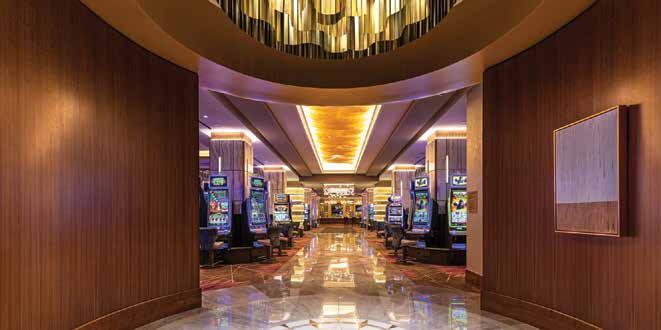

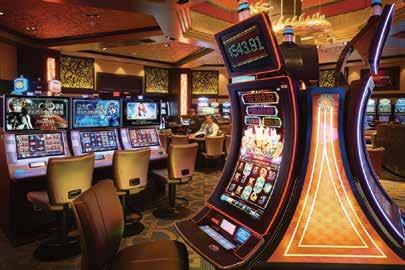
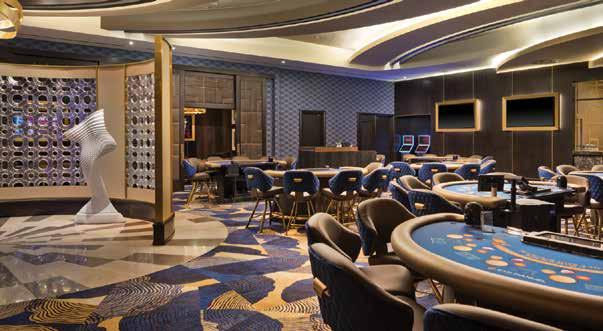
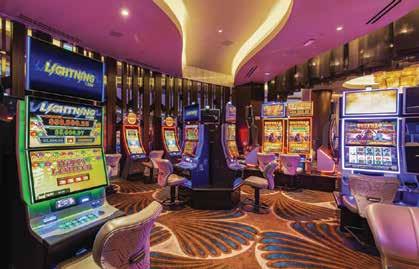





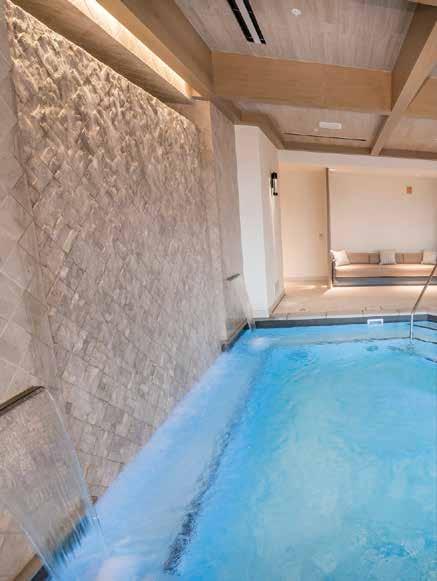

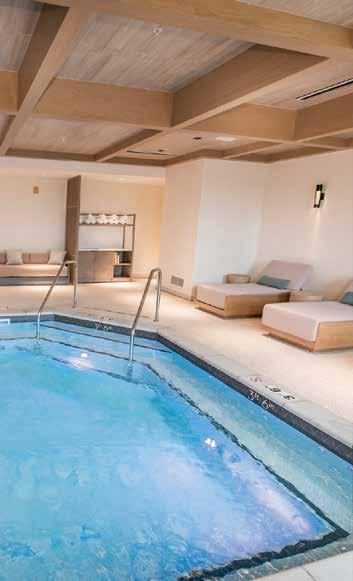
Down Earth to
The new Serrano Spa & Salon at Yaamava’ Resort & Casino at San Manuel creates an unmatched wellness experience by blending the empowering energy of the earth with top-of-the line service. By Dakota Kim
Acentral theme at the newly minted Serrano Spa is a connection to the earth. Here the surrounding desert and golden mountains are on full display through the large windows and from the private terraces. White quartz crystal lamps illuminate the space. Accents in berry mauve, blushing peach and seafoam green remind guests of the local flora. And the wellness journeys – a themed collection of treatments – are inspired by the natural world.
Based on gemstone properties, these journeys range from the Amethyst Journey, which focuses on the heart chakra, to the tranquil Turquoise Journey, honoring the stone regarded by healers to bring protection, good fortune, wisdom and a sense of peace.
“The Turquoise Journey is our highest, most luxurious. Using BABOR Sea Creation products and featuring techniques based on water and movement, the experience has a unique flow that makes you feel like you’re at zero gravity,” said Shane Upson, Director of Spa Operations. The journey begins with a hydrating facial and a sea re-mineralizing massage with seaweed body wrap before moving on to a full-body enzyme exfoliation, lymphatic brushing and cocooning cream wrap. The final touch is a BABOR Sea Creation mani-pedi, where scents of rosemary, eucalyptus, apple and lavender cleanse your aura before you head into the world.
Upson has long been a champion of wellness for all. “I’ve always been passionate about self care. And now the world has changed when it comes to wellness; it’s at the forefront of everyone’s mind.” More people are now opting for a day at the spa...but some may find the experience intimidating. “We created the journeys to put people at ease and so guests know what to expect; but, of course, they are free to design their own journey if they prefer,” Upson said.
The à la carte menu offers massage modalities such as Swedish, Himalayan salt stone or sports therapy massages. Gemstone crystal masks, LED light treatments, skin rejuvenation and wrinkle reduction treatments are also available. Guests can even visit the salon for tandem treatments like a balayage or hair regeneration paired with a Knesko collagen eye mask or aromatherapy.
Serrano Spa also offers cutting-edge technology. “We’re ready with the elevated tools to bring ultimate well-being to guests, from facial microcurrents to lift and tighten skin to Hypervolt Hyperice percussion products used by elite athletes in the NBA and NFL,” said Upson.


To create a top-of-the-line experience, Upson personally interviews each team member. The spa has the best estheticians, hairdressers, nail technicians and massage therapists in the industry because they’re extremely specific about what they want: people who can create a truly memorable few hours for the guests. “Today, guests value experiences over things, which is why we see more groups and couples. They want to share something together,” Upson said.
As guests wait for their journeys to begin, they can relax in private booths in the tranquility area, pass under the bubbling waterfalls at the Water Sanctuary or head outdoors. Here they’ll find an oasis of calm with features that take advantage of the Inland Empire’s enchanting and healing dry, desert weather. The mountain-facing terrace is a reflective space where guests contemplate the striking view while sipping a revitalizing tea or cocktail. At the poolside terrace – awash in a vivid colorscape of pinks, greens and blues – music with an electro lounge poolside vibe plays while guests gather around a large fire pit or on one of the chaise lounges or sofas, and cuddle up in a throw blanket by Matouk.
For the complete wellness experience, the fitness center will offer sunrise yoga and tai chi along with a fully outfitted gym. Guests can get long and lean with a Pilates reformer class in the movement studio; push muscles to the limit with the TRX bands; or hit the state-of-the-art Precor ellipticals to sweat out any toxins. The equipment even connects to guests’ Fitbits and Apple Watches, so they can sync their workouts. And for those who want more of a challenge while getting valuable feedback on form, a personal trainer is available by appointment.
Finishing up the experience is the spa’s refreshment station, where Linchul Shin, Yaamava’s


Director of Food and Beverage, has selected healthy yet indulgent snacks like passionfruit, coconut mixed nuts, caramelized walnuts, Marcona almonds, homemade signature granola and pastries.
“Linchul and I have the same background and we both embrace creative, outside-the-box thinking with events and menus. We work together to create delicious, rejuvenating dining options for our spa guests,” Upson said.
Guests will find tinctured teas, curative juice elixirs, kombucha, collagen tonics, elevated waters – with rarely seen thyme and pineapple infusions –and even “Bloody Mary” water, steeped with red and green peppers, cilantro and celery.
“We combine health with indulgence,” Upson said. “And we have the never-say-no mentality. Today, one guest wanted only herbal tea while another requested milk and cookies.”
Serrano Spa has big plans for 2022. In February, the spa hosted Season of the Heart, celebrating both Galentine’s Day and couples with a heartchakra centered menu. And, in the near future, the spa will host holistic healing rituals like full-moon
meditations, crystal and sound healing and yoga parties. A tea party and shoppable event is also in the works.
“The Spa Boutique offers items you can’t get anywhere else,” Upson said. Along with athleisurewear, swimwear, kimonos and candles, the boutique carries upscale skincare lines, gemstone jewelry by Chelsea Bond, Karma and Luck gemstone trees and a crystal water bottle collection from VitaJuwel.
In the end, Upson’s goal is to provide extra special touches to welcome guests to the Yaamava’ family. “From elevated, beautiful desserts for birthdays and little gifts when someone mentions they love a specific something. We want to be that family away from home,” Upson explained. He’s excited to share the crystal gemstone-inspired spa journeys and welcome them into the Serrano Spa family, where forging warm, healing connections is paramount. “It’s not just about the massages or the Water Sanctuary; it’s about the way we make guests feel. We have such a level of intention and joy that the guests feel it the second they enter.”
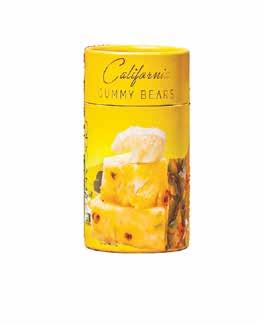
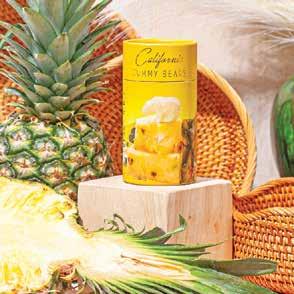



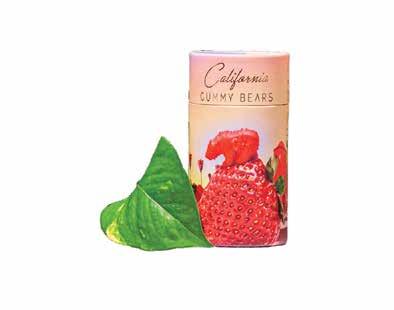


itKeeping simple?
Yaamava’ has partnered with several high-end beverage retailers to bring ready-made cocktails and prosecco in cans exclusively to pool guests.
summer escape summer escape The Ultimate
Drop your cares – and your beach towel – and dive into a sun-drenched day of fun, food and drinks at the pool at Yaamava’ Resort & Casino at San Manuel.
By Jessica Villano
There’s something intoxicating happening at the new pool at Yaamava’. And it’s not just the handcrafted cocktails. Here glistening pools, swaying palms and vibrant music are all part of the thoughtfully curated luxury vibe.
Add the amazing Southern California weather and poolside options for food and drinks and you have a multi-faceted escape, either for a snack or a full day lounging by the pool – ice-cold cocktail in hand.
“It's truly an elevated experience. Our goal is to exceed our guests’ expectations by learning what they’re looking for and creating that for them; some people want high energy; others just want to chill,” said Senior Manager Zachary Carleo. “One of my favorite parts about the pool is the amount of time you get with guests. Instead of an hour and a half at dinner, at the pool you might get four or five hours to really connect with them.”
Two of the offerings that make Yaamava’s pool such a prime destination are bottle service, available to cabana guests, and the weekend brunch. “This is a one-of-a-kind program in the area and I’m confident it will be one of best brunch programs in the country,” said Linchul Shin, Director of Food and Beverage at Yaamava’. “And the live entertainment revamps the energy for the entire pool deck, providing something new and fresh each week.”
For those who want to go all in on the tropical vibe, look no further than the drink menu at the poolside Helix Bar. The inspiration for the bar program came from, of all things, childhood visits to a local Tiki bar. “I wasn’t drinking of course, but my parents used to go to a restaurant called Bahooka,” explained Assistant Manager of Food and Beverage Dan Vigil. “It was dark, lots of Polynesian-themed decorations. Walls of aquariums surrounded the booths and all the drinks were big, strong and made with juice. The whole ambiance was fascinating, and I thought it was the coolest place. This menu is my homage to that feeling of cool.”
Nods to 1950s California cocktail culture and high-end rumbased libations abound, but there is also so much more. In fact, it took months of R & D and lots of refining and editing before Vigil debuted his menu of tropical drinks. “I set up a cocktail tasting with my directors, managers and Assistant Manager for Beverage Joey Gottesman, a career mixologist from Hawaii. So, no pressure,” Vigil laughed. The result was a bar menu that perfectly complements the aesthetics and allure of the pool’s beautiful environment. Turn the page to see which drinks passed the test.
The glamour of the South Seas – as told through rum, coconut and pineapple –came on the scene in the '30s. By the '50s there was a full-blown culture built around the dreamy idea of the South Pacific. Now Yaamava’ is giving us a modern take on those exotic tropical flavors at the poolside Helix Bar.

Faithful ship
Lovers
Full summer flavors fill the glass with this beautiful take on a margarita. Milagro Tequila Blanco and Dekuyper Watermelon Liqueur pack a punch while the hibiscus lime sour and Tajin rim weigh in with the sweet, tart and spicy notes.
Inspired by Don the Beachcomber’s classic Navy Grog, and originally made with four different rums, this drink is built solely on Don Q Anejo Rum.
Lillet Blanc adds crisp floral notes and Falernum layers in flavors of ginger, lime, clove and almond. Fresh grapefruit and lime finish the drink.
Staycation
There’s no tell-tale neon green here, but Melon Ball lovers, this one’s for you. Midori Liqueur and Tanqueray 10 Gin form the foundation and orange, lime and grenadine are layered in for a rainbow effect. Finally, a splash of bubbles is added for a touch of effervescence.

Purple rain
If the muted ombre look doesn’t capture your heart, the Crème de Mure Blackberry Liqueur and Cazadores Reposado Tequila surely will. Sweet and toasty coconut cream give depth of flavor and tart lime balances it all out. Frozen 1953 mai
The granddaddy of Tiki drinks has a hotly disputed origin story – and a recipe that was kept secret for so long people had to try to reverse engineer it – but Yaamava’s take on the tropical favorite is here. Featuring Don Q Anejo Rum, Bols Orange Curacao and Giffard Orgeat, this version adds pineapple to the original orange and is topped with a Kraken Rum float.
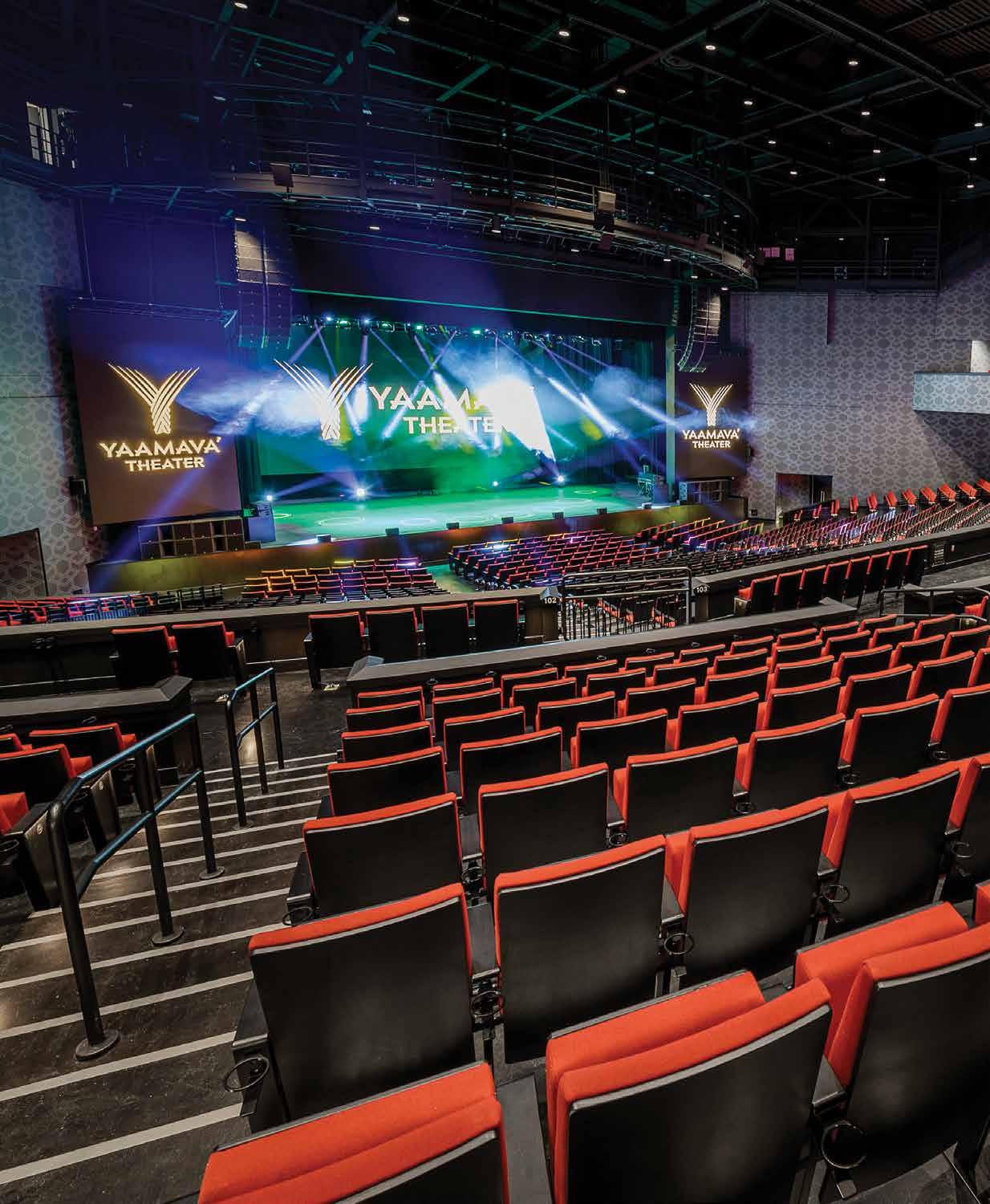
Stage Center Take
BY MELINDA SHECKELLS
A stellar entertainment experience awaits fans at the Inland Empire’s newest venue at Yaamava’ Resort & Casino at San Manuel.
SStanding on the stage at Yaamava’ Theater and looking out into the audience of 2,600, the energy of the fans pulsates. The sound from the state-ofthe-art L’Acoustics K2 sound system blankets the room. LED walls produce dazzling visual effects. This scenario – a sold-out crowd, best-in-class audio and customizable space – ticks the box as a dream scenario for any performer, promoter, theater operator and concertgoer, and it is one that Drew Dixon, Vice President of Entertainment at Yaamava’ Resort & Casino at San Manuel can’t wait to deliver every night at the Inland Empire’s newest entertainment venue.
When Yaamava’ Theater opens its doors this spring, along with exclusive booking partner Live Nation, expect to see the acts that don’t normally come 60 miles east of L.A. The theater hits a sweet spot as there aren’t other competitive venues within radius, thus giving a wide-open playing field for booking talent. A mix of legacy acts, current chart toppers, comedy headliners, multi-date residency acts, multicultural programming and even sports viewing parties will grace the stage.
“Our goal is to book two to three nights ticketed per week, and then additional casino events,” said Dixon. He is anticipating the theater to be populated by tribal citizens, casino guests and others who drive to see the show. “We want to book acts who appeal to our players, but with the quality of what we’re looking to produce in this room, we will definitely get drive-in from L.A.”
The theater is the final phase of the luxury resort expansion at Yaamava’ Resort & Casino at San Manuel. At fewer than 3,000 seats, it can still be described as intimate with a selection of nine suites and six distinct seating areas, all of which offer different types of service.
Enter the venue and arrive at the main bar, then follow a U-shape corridor that moves the audience into the theater. On the floor, find retractable, configurable seating that gives artists a standingroom only pit if desired. “We have the functionality to create the optimal experience for each artist,” explained Dixon.

If you are lucky enough to snag a suite ticket, expect plush seating, a drink always in your hand, private restrooms and phone charging capabilities at the standing-bar area. Within the suite, find closed circuit televisions, which will also do double duty for game-day viewing parties. Unique to this venue are the open suites, with sightlines almost eye-level to the performer. Suite catering also is available.
“You can pre-order your food selections so when you arrive, the food’s ready to go – we can even do birthday cakes and other amenities to support your special occasion.”
Suite guests enter on the second level and will be escorted directly to their VIP suite by a dedicated VIP
Bringing this theater to life required assembling an all-star team: Architects Wimberly, Allison, Tong & Goo – the firm that created the structural design for Encore Las Vegas; Klai Juba Wald – interior designers of some of Las Vegas’ top hospitality spaces; and Auerbach Pollock Friedlander, which perfected the theatrical systems design and is known for the SFJazz Center, the KÀ Theater at MGM Grand and many others.
Backstage, the amenities are just as top-notch, with large dressing rooms and an expansive green room to cater to the needs of top touring acts. Back of the house, there is a video room with broadcast-quality capabilities.
We have the functionality to create the optimal experience for each artist.
Representative. There are also expansive bars located at the entries on each level, allowing fast beverage service for guests.
The magic doesn’t just happen on the stage; the interiors stand out as well with works from artists such as Colas Moore, whose “Sound Wave” is on Level 2. Pieces from Dylan Kelly, Jeff Peters, Raul de la Torre and Robin Huber hang in the VIP Suites, as well as green room, dressing rooms and lobbies.
“Comedy is definitely something we want to book in the theater,” said Dixon, who also oversees all casino entertainment, including five bar and lounge locations. This means the place is rockin’ and rollin’ 365 days a year with live acts and DJs.
“As guests know, there’s entertainment going on here every single night,” said Dixon. “And we can’t wait for this newest venue to take it to a higher level of excitement.”

NEW
YORK
STRIP LOIN
14 oz. dry-aged New York Strip loin
3 tbsp Maldon salt
1 tbsp fresh-cracked black pepper
¼ c. melted unsalted butter
Meat thermometer
Mesquite wood for fire
Light mesquite wood 45 minutes before you want to cook. Generously season steak on both sides with salt and pepper. When wood is red hot and showing ash on the surface, break up large pieces to create a coal bed. (You should be able to hold your hand over it for 3-4 seconds.) If you’re using a gas grill, set to medium-high heat.
Cook steak for 2 minutes, rotate 45 degrees and cook for an additional 2 minutes. Flip and repeat. Continue to rotate steak until it reaches an internal temperature of 115-120 for mediumrare. Rest steak for 5 minutes at room temperature, then brush with butter, sprinkle with salt and serve.
* Cooking inside? Preheat a cast iron pan on high heat and add 1 tbsp oil. Sear steak for 3 minutes per side then finish in a 450-degree oven.
Make the Cut
You’ve just unwrapped a beautiful cut of meat. Now it’s time to do it justice. Create the five-star steakhouse experience at home with this simple method from the chef at The Pines at Yaamava’.



Access Club Serrano tier
slot points, and earned rewards
Access Club Serrano tier points, slot points, and earned rewards
Access Club Serrano tier points, slot points, and earned rewards
Access current, future, and expired offers
Access current, future, and expired offers
Access current, future, and expired offers
Access redeemable offers directly from your phone
Access redeemable offers directly from your phone
Access redeemable offers directly from your phone
Access
Access
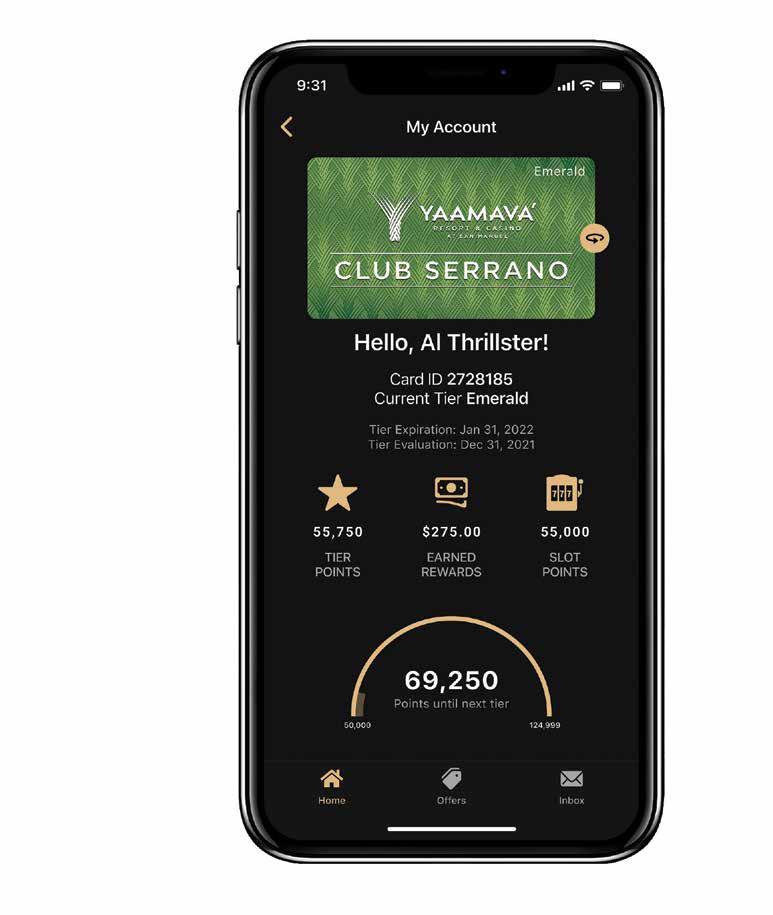
Yaamava’ Resort & Casino at San Manuel
Directory
STAY
Yaamava’ Resort
Immerse yourself and experience our first-class resort. Where traditional meets modern luxurious comfort, Yaamava’ Hotel warmly welcomes guests who seek a place for the Adventurer, Thrillist, and Night Owl. 833-YAAMAVA (922-6282)
DINING
Big Mo’ Café
Quick Bites
Refuel with quick treats and refreshments at Big Mo’ Café – your 24/7 one-stop destination to satisfy those cravings and get you back to your favorite slots and table games. The desserts and pastries are some of the most popular and photographed items on property! 800-359-2464
Chingon Kitchen
Casual Dining
Authentic Mexican cuisine served up daily at the original George Lopez’s Chingon Kitchen. Create your ultimate flavor combination from our extensive menu of tacos and taquitos, fresh guacamole, frijoles negros, elote (street corn) and more. 909-864-5050
Grove Express
Quick Bites
The Grove Express offers fresh meals and light bites without the wait. Enjoy prepared breakfast, lunch or a flavorful entrée daily from 8 am-11 pm. Located next to Serrano Vista Café, the outlet is your go-to for all things convenient. 909-864-5050
Hong Bao Kitchen
Fine Dining
Asian cuisine with a modern twist. Enjoy specialty dishes such as Shanghai Braised Pork or Kung Pao Chicken from our awardwinning culinary team. Pair with wines, spirits and limited cocktails created by our team of award-winning mixologists, including the crowd favorite: Matcha Matcha Cocktail. 800-359-2464
The Pines Modern Steakhouse
Fine Dining
Enjoy an extensive menu of premium cuts of meat, including Kobe-certified beef and fresh seafood in the exquisite setting of The Pines Modern Steakhouse, all complemented by locally sourced, organic produce. 909-425-4889
Radiance Café
Casual Dining
Indulge in poolside classics with a California twist on the terrace at Radiance Café, overlooking the tropically landscaped pool. Also home to the hottest, and most extensive, brunch in the region. Rotating themes, live entertainment and the best ingredients make for a truly one-of-a-kind dining experience. 833-YAAMAVA (922-6282)
Rock & Brews
Casual Dining
Add a bit of rock ‘n’ roll to your Yaamava’ Resort & Casino experience at Rock & Brews Restaurant. Put together your own “playlist” of rockin’ dishes – from appetizers to juicy hand-crafted burgers all while classic and current hits play in the background.
909-425-4838
Serrano Vista Cafe
Casual Dining
Serrano Vista Café is a welcoming, casual, yet upscale, setting inspired by the citrus groves of Southern California. Visit for classic American comfort food with a California twist, including healthy options 24 hours a day, seven days a week.
800-359-2464
TuTu’s Food Court
Quick Bites
TuTu’s Food Court has you covered with a wide variety of eats and desserts available to satisfy any craving. 909-864-5050
BARS & LOUNGES
ACES
First rule of Blackjack: always split your aces. Luckily, you never have to split time between entertainment and value at Aces, where you’ll find the perfect balance of craft beers and crowd favorites on tap. 800-359-2464
BAR BAR BAR
Grab a drink or conversation with our friendly barkeeps at BAR BAR BAR, where you’ll find a bevy of cocktails and ice-cold bottled or on-tap brews in a relaxing setting.
800-359-2464
DEUCES
Drop into Deuces for ice-cold drinks, your favorite beers on tap and the best in live sports entertainment on the big screen.
800-359-2464
Helix Bar
The premier pool destination for handcrafted cocktails ranging from classic Tiki to modern tropical, all starring hand-squeezed juices, exotic fruits and whimsical twists on poolside classics. 833-YAAMAVA (922-6282)
The Overlook Bar
Specialty cocktails and a chance to sample something from the exclusive wine and spirits list Collection 86 make The Overlook Bar a destination fit for royalty. Enjoy a glass of private stock wine or a neat pour of the rarest bourbon while taking in views from the balcony. 800-359-2464
Round Up Bar
Serving up a large selection of bottled and on-tap brews and an assortment of refreshing cocktails and mixes daily. 800-359-2464
Tropical Storm Bar
Whether you’re craving a Hurricane or a Tropical Storm Mojito, a selection from our drink list is like a relaxing beach vacation without leaving the casino. 800-359-2464
Tukut Lounge
Enjoy bar-top video poker or take a seat as you watch themed nightly entertainment. The recently revamped space near the center of the casino on the first floor includes a stage, state-of-the-art sound system and several HD screens. 800-359-2464
RETAIL
1891 Boutique
High-end designer brands for both men and women – from sunglasses and handbags to suits and dresses – as well as fine jewelry, including designs by Native American artists. 909-863-5756
Cache & Carry
Level up your audio experience or simply replace a phone charger at Cache & Carry, where you’ll find cutting-edge electronics and accessories from the brands you love. 800-359-2464
Decadence
Enter a sweet escape when you step into the world of Decadence at Yaamava’. With a large assortment of luxury chocolates and candy, Decadence is your destination for sweet-tooth satisfaction or to find a special gift. 909-864-5050
HIS & HERS Boutique Shops
Two high-end shops located next to each other on the first floor of the casino. HIS carries men’s apparel, cigars, luxury lifestyle jewelry, sunglasses, watches and wallets. HERS features home décor, art, high-end fragrances, designer bags and more. 800-359-2464
PUUHIA’T Roadrunner Gift Shop
Pick up Yaamava’ Resort & Casino logo wear, official sports gear from our professionalteam partners, snacks, cigarettes, cold beverages and more. 909-863-5755
R&B Authentic Merch Shop
Add some rockin’ to your shoppin’ with officially licensed rock merchandise, limited-edition photos and much more. 909-425-4814.
SPA
Serrano Spa
Enjoy the serenity of Serrano Spa during one of the wellness rituals. Offering signature massage, facials, body treatments and nail and hair services that embody Serrano strength and resilience. Begin your wellness journey at Serrano Spa. 833-YAAMAVA (922-6282)
GAMING
High Limit Slots and Tables
VIP Gaming
The High Limit Slots and High Limit Tables gaming rooms are a best-in-class experience for players betting higher denominations. The space includes an array of amenities including the option to order from Collection 86, which boasts the finest wines and spirits in the world. 800-359-2464
Lotus 8 Palace
VIP Gaming
Create your own luck and find your Zen in our Lotus 8 Palace gaming room. This space creates an East-meets-West vibe with Asian-inspired décor, slot machines and classic casino table games like EZ Baccarat and Buster Blackjack. 800-359-2464
SoCal’s Best Slots
Play 1000s of slots across two stories: mechanical reels, video reels, video keno, in-house progressive jackpots, wide-area and mystery jackpots as well as a widearea progressive (multi-casino) jackpots. 800-359-2464
Table Games & Progressives
Enjoy Vegas-style table games 24/7 on both levels of the casino such as Blackjack, EZ Baccarat and Pai Gow. Yaamava’ Resort & Casino also features the most table game progressive jackpots in California. 800-359-2464
The Vault Gaming & Provisions
VIP Gaming
Enter a world of mystery, intrigue and big jackpots at The Vault Gaming and Provisions, the ultimate high limit gaming room located on the second floor of Yaamava’ Resort & Casino. This exclusive room features close to 190 high limit slot machines, eight table games and a bar brimming with top-shelf spirits. 800-359-2464



For generations, our Tribe has answered to Yawa’—the call to act on one’s beliefs. It’s the reason we donated $300M over the last 20 years and why we continue to partner with communities across California. Because when we work together, we all prosper.
